Thick-Skinned and Thin-Skinned Tectonics: A Global Perspective
Abstract
:1. Introduction
1.1. Historical Background
1.2. Thrust Faults and Décollement Layers
1.2.1. Geometric Aspects of Thrust Faults
1.2.2. Mechanical Aspects of Thrust Faults
1.2.3. Displacement along Thrust Faults
1.2.4. Frontal and Basal Accretion
1.2.5. Role of Pre-Existing Normal Faults
- (1)
- A décollement at the base of the succession is likely to be cut by the extensional faults and if the displacement is of importance, a through going detachment must overcome steps.
- (2)
- The sediments deposited in the hanging wall of syn-sedimentary normal faults are likely to be different from the ones in its footwall. As a result sedimentary strata with different mechanical behavior may be juxtaposed and act as lateral heterogeneity in the course of subsequent horizontal compression and detachment. Numerical experiments suggest that folds develop preferentially at such heterogeneities [46].
- (3)
- In case of syn-sedimentary faulting with steeply dipping normal faults and thick basin fill, the sediments are in part deposited directly adjacent to the crystalline basement. Upon detachment of the basin fill in compression the steep normal faults are ill oriented for reactivation during the expulsion of the basin fill. There is a wealth of literature on this process of “basin inversion” with studies based on numerical and analog experiments as well as on natural examples [47]. Already in 1911 [48] postulated that basement highs and lows inherited from Mesozoic extensional faulting influenced the locations of subsequent compressional tectonics.
1.3. Driving Forces of Nappe Emplacement
1.4. Case Studies: Choice and Structure of Presentation
- The availability of geophysical data, namely seismic sections.
- The presence of extensive previous work regarding structure and tectonics setting.
- Coverage of all the different types of orogens.
2. Active Mountain Belts
2.1. Himalaya of Nepal
2.2. Zagros of Iran
- (1)
- Obduction of Neotethyan oceanic crust onto the Arabian margin in the Late Cretaceous (~100–70 Ma) which set the starting point for the formation of the Zagros Imbricate zone.
- (2)
- (3)
- Further thrusting in the Zagros Imbricate belt in Eo-Oligocene times [92]. Neotethys was closed by ~35 Ma.
- (4)
2.3. Taiwan
- (1)
- The Eastern Range, a Miocene volcanic arc with Plio-Pleistocene clastics that developed on the Philippine Sea plate.
- (2)
- The Central Range, which contains a pre-Cenozoic metamorphic complex (Tannao complex) with gneisses, marbles, metaclastics, metabasites, ophiolites and Cretaceous granitoids, all of which are part of an ancient accretionary complex at the tip of the Eurasian plate.
- (3)
- The Backbone Range, which consists of Eocene to Miocene slates that have been metamorphosed up to greenschist grade. Some authors refer to this unit as Slate belt and consider it as part of the Central Range.
- (4)
- The Hsuehshan Range contains quartzites and slates of Eocene–Oligocene age that have been metamorphosed up to greenschist grade.
- (5)
- The Western Foothills are a fold-and-thrust belt consisting of Oligocene to Miocene non-metamorphic sandstones and shales.
- (6)
- The Coastal Plain, underlain by Pliocene to recent clastic sediments.
2.4. Sierras Pampeanas of Argentina
- (1)
- The Chilenia terrane, built of gneisses, metasediments, metavolcanics and ultramafic lenses of Grenvillian age that are overprinted by Palaeozoic, Mesozoic and Cenozoic magmatic arcs. The latter modified the composition of the basement resulting in an average andesitic composition with lower bulk density and slow velocities in the lower crust [123].
- (2)
- The Cuyania terrane, which is a Laurentia-derived terrane with Grenvillian metamorphic rocks of predominantly mafic composition in the upper crust and a more felsic lower crust [123].
- (3)
- Three terranes are distinguished within the Sierras Pampeanas, all of which are Gondwana-derived: the Famatina terrane, (Protomargin of Gondwana), Pampia (Gondwana margin) and the Rio de La Plata craton [50]). All of these are made of Precambrian to Early Palaeozoic metamorphic rocks. The boundary between Famatina and Cuyania represents a crustal discontinuity, which controlled the nucleation of the Valle Fértil fault and associated basement uplift [50]). Early Palaeozoic mylonites that outcrop within a zone composed of Ordovician mafic and ultramafic rocks mark the boundary between Famatina and Pampia; Cenozoic faults were partially controlled by these Palaeozoic fabrics (Ramos et al., 2002). Similarly, the suture between Pampia and the Rio de La Plata craton, which contains ductile shear zones within Precambrian rocks, was reactivated by west-verging Cenozoic faults [50].
2.5. Northern Andes of Colombia
2.6. Central Alps of Switzerland
- (1)
- The stable foreland exposed in the basement uplift of the Black Forest.
- (2)
- The Jura Mountains, a slightly allochthonous Mesozoic sequence piled up by imbricate thrusting. A Permo-Carboniferous graben is present within the underlying crystalline basement.
- (3)
- The Molasse Basin, a foreland basin which was displaced piggy back with the underlying Mesozoic sequence that connects with the Jura Mountains.
- (4)
- The Alpine nappe stack that include the Helvetic and Penninic nappe system. The uppermost, Austroalpine nappe system has been eroded altogether in this transect. Helvetic and Penninic units are made of crystalline basement units and of highly allochthonous Mesozoic cover units. Aar, Gotthard and Verampio pertain to the proximal (Helvetic) European margin, Antigorio and Maggio to the distal (Penninic) part.
- (5)
- The Southalpine nappe stack with a lower crustal section (Ivrea) and an upper crustal section (Strona-Ceneri) with Mesozoic and Cenozoic cover. The Po Basin corresponds to the Cenozoic cover.
3. Ancient Mountain Belts
3.1. Continent-Continent Collision
3.1.1. Caledonides
3.1.2. Variscides
3.1.3. Central Australia
3.1.4. Eastern Australia
3.1.5. Apennine
3.1.6. Himalaya-Tibet Orogen
3.1.7. Western and Eastern Alps
- (1)
- The allochthonous Mesozoic–Cenozoic strata of the Helvetic nappes and the Jura Mountains were detached along Triassic evaporites mainly and transported to the NW. They now form a wedge that was thickened internally. The basal thrust was severely deformed in the rear part by the updoming of the external massifs (e.g., Belledonne).
- (2)
- In the Penninic nappes, which represent the former distal European margin and the Piemont Ocean, nappe transport was predominantly NW-directed (Handy et al., 2010). Several of the thrust faults are intricately folded. Some of the folded thrusts represent décollement layers, which indicates that nappes having formed in a thin-skinned tectonic style were later overprinted by ductile deformation that occurred in the framework of thick-skinned tectonics.
- (3)
- Although the limit between lower and upper crust, for which the velocity isoline of 6.5 km/s was used, is not a sharp boundary and ill-defined at some localities, it nevertheless seems obvious that the structure of this limit cannot be correlated with those in the upper crust in a straight forward manner. The disharmony between the top of the upper crust and the top of the lower crust could be explained by a weak lower part of the upper crust deforming in a ductile manner. Similarly, the planar shape of the lower limit of the lower crust, the Moho, and wavy shape of its upper limit suggests that the lower part of the lower crust was deforming in a ductile manner and therefore is likely to be weak.
- (4)
- The former plate boundary must be sought between the Gran Paradiso basement block of the distal European margin (Briançon microcontinent) and the Salassic upper crustal unit (mainly Sesia nappe complex) of the Adriatic margin. This plate boundary may be traced down to the crust/mantle boundary and the base of the lithosphere, which both are offset. More important is a large broken off slab of the European plate that can be traced to greater depths. Higher up in the section, the former plate boundary was deformed by the indentation of lower crust of the Adriatic margin into the European upper crust.
3.2. Subduction Related Orogens
3.2.1. Central Andes of Peru
3.2.2. Central Andes of Chile-Bolivia
3.3. Orogens Involving Broad Passive Margins
3.3.1. North American Cordillera
3.3.2. Sevier- and Laramide Belt of the Western U.S.
3.3.3. Southern Appalachians
3.4. Basin Inversion
3.4.1. Malargüe Fold-and-Thrust Belt in the Andes
3.4.2. Pyrenees
3.4.3. Atlas Mountains
3.5. Classic Thin-Skinned Tectonics
3.5.1. Klippen Nappe of Western Switzerland
3.5.2. Salt Range–Potwar Plateau of Pakistan
- (1)
- Narrow antiformal structures with oppositely verging high-angle thrust faults on the limbs.
- (2)
- Low-angle thrust faults verging to either the southeast or the northwest [289]. The tips of the thrust faults are marked by fault-propagation folds in which displacement is transformed to folding such that the thrust faults never reach the surface.
- (3)
- The most important low-angle thrust is the SE-verging Domeli thrust, which brings Cambro-Eocene strata to the surface; fault displacement is ~8.8 km [289]. Fault slip diminishes towards the west along strike and eventually the fault sense is reversed (Dil Jabba thrust is NW verging).
3.5.3. Makran Accretionary Wedge of Iran/Pakistan
4. Discussion and Conclusions
- (1)
- Collision orogens showing delamination of the crust (see Figure 33A). Delamination, or splitting apart of the crust is typical for collisional orogens where plate convergence brings two continental crustal sections into direct contact. Here the space between the delaminated crustal layers of the lower plate is filled by crust of the opposite, upper plate. This feature, also called “crocodile structure”, is in some sort the archetype of thick-skinned tectonics. Examples include the Alps (Figure 14 and Figure 21), the Himalaya-Tibet orogen (Figure 20) and the Pyrenees (Figure 28). The indentation occurs in a late stage of the collision and may be caused by the buoyancy of the continental crust resisting subduction. The lower crust of the lower plate is eclogitized, thus denser and subducted into the mantle. Such eclogitic packages might not be resolved by geophysical sounding.
- (2)
- Subduction-related orogens. Here the growth of the orogen in the continental upper plate typically occurs hundreds of kilometers inboard of the subduction trench, independent of the subduction angle (Figure 33B). Examples discussed in this paper include the Andes of Peru (Figure 22), of Chile-Bolivia (Figure 23) and Chile-Argentina (Figure 12). These orogens demonstrate that the stresses leading to crustal shortening of the upper plate are transmitted over large distances, with the upper (and possibly lower) crust acting as stress guide.
- (3)
- Orogens where one of the continental plates is made of a rigid long slab from which the sedimentary cover is detached and telescoped as long thrust sheets (Figure 33C). Examples include the Variscides (Figure 16), North American Cordillera (Figure 24) and the Southern Appalachians (Figure 26). Whereas in case of the North American Cordillera it could be argued that the rigidity of the slab is related to the greater thickness of the crust (50 km), in the Southern Appalachians only the crust beneath the Cumberland Plateau-Valley & Ridge provinces is thicker (40 km) compared to the 30 km beneath the Inner Piedmont. The crust in the Variscides has a constant thickness of roughly 30–35 km only. But as discussed by [174] this is an effect of ductile flow within a hotcrustal root heated up by collision-related magmatism.
- (4)
- Orogens where one or both continental plates are horizontally shortened by crustal-scale thrust faults, the cover being detached and telescoped (Figure 33D). Examples include the Caledonides (Figure 15), the Alice Springs orogen of Australia (Figure 17), the Alps (Figure 14 and Figure 21), the Apennine (Figure 19) and the Pyrenees (Figure 28). These orogens share an initial crustal thickness of around 30 km. The detached sedimentary cover is displaced over much shorter distances than examples with a rigid long slab, and the contracted crust is piled up to an imbricate stack of relatively thick thrust sheets made up of upper crustal rocks (including lower crust in case of the Alice Springs orogen). In this context it is interesting to note that in case of the orogens with rigid long slabs, thin thrust sheets of crystalline basement are thrust upon the long slab; these derive from the continental margins and thus formed from thinned continental crust. It thus can be argued that crustal contraction by thrusting is more pronounced if the crust is thin and possesses a high geothermal gradient.
- (5)
- Orogens in which basin inversion played an important role (Figure 33E). A prominent feature in these orogens is that steeply dipping reactivated syn-sedimentary normal faults and new thrust faults that formed in contraction lead to regional uplifts of blocks of upper crust in a thick-skinned tectonic style. Examples include the Eastern Cordillera of the Andes in Colombia (Figure 13), the Malargüe fold-and-thrust belt of the Andes in Argentina (Figure 27), the Pyrenees (Figure 28), the Atlas Mountains (29) or the Klippen nappe in the Central Alps (Figure 30). Basin inversion may be mild or complete. E.g., in the Atlas Mountains the top basement contact still forms a depression in the core of the orogen, which signifies a mild inversion. Stronger inversion occurred in the Eastern Cordillera of Colombia, where this top basement contact is uplifted to a symmetric antiform centered on the ancient basin, which itself had also been symmetric. A positive relief was also created in the Pyrenees and in the Malargüe fold-and-thrust belt. In these two examples inversion produced an asymmetric antiformal structure, which mimics the asymmetry of the original basin. In the Pyrenees it is the hyper-extended margin versus the relatively undeformed margin of the upper plate. In the Malargüe fold-and-thrust belt it is the uniform orientation of synsedimentary normal faults across the entire basin.
- (6)
- Orogens containing truly thin-skinned fold-and-thrust belts, where the cover is detached from the crystalline basement along a décollement layer and highly allochthonous (Figure 33F). In most cases the décollement layer is made of evaporite and/or shale sequences. Two end-members types may be distinguished: (1) the detached cover is mechanically strong and shortened by detachment folds, as is the case in the Zagros of Iran (Figure 10), the Salt Range–Potwar Plateau of Pakistan (Figure 31) and the Klippen nappe of western Switzerland (Figure 30), or (2) the rheological contrast between décollement horizon(s) and the detached cover is moderate and shortening is accomplished by imbricate thrusting and folding such as observed in accretionary wedges like the Makran of Iran/Pakistan (Figure 32). In the transects of Zagros and Salt Range–Potwar Plateau discussed here, the detached cover is laterally homogeneous and the décollement layer is thick such that simple upright folds developed. In the Klippen nappe the detached cover is laterally discontinuous owing to synsedimentary faulting and the décollement layer varies in thickness. As a result, the structures within the detached layer are more complex, involving imbricate thrusting. Provided the décollement horizon is of sufficient thickness, steps within the units below may be overcome. From the examples studied, steps not higher than about half of the thickness of the décollement layer can be overcome by a detachment fault. At this point it has to be distinguished between a mechanically stiff footwall (like crystalline basement as in Zagros and Salt Range–Potwar Plateau) and a weak footwall consisting of cover nappes (as is the case in the Klippen nappe). In the latter case the thrust contact may be smoothened by plucking off pieces of the footwall and dragging them along the thrust fault. An example of this process is suspected along the contact of the Glarus thrust [309].
- (1)
- Most orogens contain both thin-skinned and thick-skinned components, and it then becomes important to understand the kinematic sequence of nappe stacking. In case of the Alice Springs orogen, thin-skinned thrusting of the cover of the Amadeus basin and thick-skinned thrusting of the crustal units in the Arunta block were coeval at first, but then in a late phase of thick-skinned tectonics, the basal thrust fault of the already detached cover was uplifted to a broad antiform (see Figure 13A) [16]. In the Central Alps it can be shown that the cover sediments were detached and piled up to a nappe stack before thick-skinned tectonics affected the crystalline basement [193]. The thick-skinned tectonics led to the formation of a totally independent nappe stack and the earlier formed thrust faults were intricately folded in the process. In the North American Cordillera of southern Canada, reference [238] argue that the major thrust faults in the cover (Omineca and Foothills) were activated simultaneously with the development of thrust faults and shear zones in the crystalline basement of the Omineca belt (see inset in Figure 26A), but readily separated in space. In case of the Zagros Fold belt and the adjacent Zagros Imbricate belt, thin-skinned thrusting and thick-skinned thrusting occurred almost contemporaneously. In most of these examples thin-skinned thrusting propagated generally speaking outward (in-sequence), while thick-skinned thrusting progressed downwards. These observations correspond partly to the results of numerical experiments: Reference [309] report that the thin-skinned style detachment of cover was driven by successive thick-skinned thrusts emerging from the model crust; this process propagated outward. Reference [310] observed in their model with two décollement layers that activation of décollement propagated downward and outward.
- (2)
- The exact location of décollement layers in fold-and-thrust belts is usually discussed in much detail. Evaporite and/or shale sequences, rather frequent in thin-skinned thrust belts, are readily assessed in discussions on structural styles. But the rock types along crustal thrusts in crystalline basement rocks are more difficult to assess because they are usually not exposed. The initiation of crustal thrust faults is often rather loosely explained by reactivation of pre-existing fabrics such as intrusive contacts, pre-existing normal faults or thrust faults. Such a link may be established in cases of emergent thrusts, but an extrapolation for deeply buried thrusts is highly putative. Apart from these structures, reaction-softening by phyllonite formation or strain softening owing to rising temperatures along a (new) thrust fault are valid explanations for focusing of shear along such faults once they are initiated. The inception of faults in crystalline basement merits more research in the future.
- (3)
- Balanced cross-sections obtained by using available software packages yield geometrically correct solutions. These are valuable and usefull provided the limitations of the purely geometric solutions are taken into account. But the structural style of such cross-sections if applied to crustal units is in many instances highly questionable. This stems from the neglect of the internal deformation of the thrust sheets and in particular strains along the thrust contacts. Differential stretch between hanging wall rocks and footwall rocks may lead to important changes in displacement along thrust faults. Hence blind use of balancing software overemphasizes the continuity of such thrust faults. It is for this reason that in some of the redrawn cross-sections presented here thrust faults are portrayed as reaching less deep into the crust as is assumed in the original publications.
Supplementary Materials
Acknowledgments
Conflicts of Interest
References
- Pfiffner, O.A. Thick-Skinned and thin-skinned styles of continental contraction. Geol. Soc. Am. Spec. Pap. 2006, 414, 157–177. [Google Scholar]
- Chamberlin, R.T. The building of the Colorado Rockies. J. Geol. 1919, 27, 145–164. [Google Scholar] [CrossRef]
- Chamberlin, R.T. Vulcanism and mountain-making: A supplementary note. J. Geol. 1921, 29, 166–172. [Google Scholar] [CrossRef]
- Rodgers, J. Evolution of thought on structure of middle and southern Appalachians. AAPG Bull. 1949, 33, 1643–1654. [Google Scholar] [CrossRef]
- Gwinn, V.E. Thin-Skinned Tectonics in the Plateau and Northwestern Valley and Ridge Provinces of the Central Appalachians. Geol. Soc. Am. Bull. 1964, 75, 863–900. [Google Scholar] [CrossRef]
- Argand, E. Sur l’arc des Alpes Ocidentales. Eclogae Geol. Helv. 1928, XIV, 145–190. [Google Scholar]
- Heim, A. Geologie der Schweiz, I, II/1, II/2; Tauchnitz: Leipzig, Germany, 1919–1922. [Google Scholar]
- Elliott, D.; Johnson, M.R.W. Structural evolution in the northern part of the Moine thrust belt, NW Scotland. Edinb. Geol. Soc. Trans. Earth Sci. 1980, 71, 69–96. [Google Scholar] [CrossRef]
- Gansser, A. Geology of the Bhutan Himalaya. Denkschr. Schweiz. Naturforsch. Ges. 1983, 96, 181. [Google Scholar]
- Mégard, F. The Andean orogenic period and its major structures in central and northern Peru. J. Geol. Soc. 1984, 141, 893–900. [Google Scholar] [CrossRef]
- Rubey, W.W.; Hubbert, M.K. Part 2 of Role of fluid pressure in mechanics of overthrust faulting. 2. Overthrust belt in geosynclinal area of western Wyoming in light of fluid-pressure hypothesis. Geol. Soc. Am. Bull. 1959, 70, 167–206. [Google Scholar] [CrossRef]
- Armstrong, F.C.; Oriel, S.S. Tectonic development of Idaho-Wyoming thrust belt. Bull. AAPG 1965, 49, 1847–1866. [Google Scholar]
- Bally, A.W.; Gordy, P.L.; Stewart, G.A. Structure, Seismic Data, and Orogenic Evolution of Southern Canadian Rocky Mountains. Bull. Can. Petrol. Geol. 1966, 14, 337–381. [Google Scholar]
- Crittenden, M.D., Jr. Willard thrust and the Cache allochthon, Utah. Geol. Soc. Am. Bull. 1972, 83, 2871–2880. [Google Scholar] [CrossRef]
- Royse, F., Jr. An overview of the geologic structure of the thrust belt in Wyoming, northern Utah, and eastern Idaho. Geol. Surv. Wyoming Mem. 1993, 5, 272–311. [Google Scholar]
- Teyssier, C. A crustal thrust system in an intracratonic environment. Tectonophysics 1985, 7, 689–700. [Google Scholar] [CrossRef]
- Escher, A. Geologische Carte des Cantons Glarus und seiner Umgebung, nebst Profilen. Verh. Naturforsch. Ges. Zürich 1841, 52–62. [Google Scholar]
- Rogers, W.B.; Rogers, H.D. On the physical structure of the Appalachian Chain, as exemplifying the laws which regulated the elevation of great mountain chains generally. Assoc. Am. Geol. Nat. Repr. Trans. 1843, 4474–4531, reprinted in Rogers, W.B., 1884, The geology of the Virginias, New York. [Google Scholar]
- Callaway, C. The age of the newer gneissic rocks of the northern Highlands. Q. J. Geol. Soc. Lond. 1883, 39, 355–422. [Google Scholar] [CrossRef]
- Lapworth, C. On the structure and metamorphism of the rocks of the Durness-Eriboll district. Proc. Geol. Assoc. 1883/1884, 8, 438–442. [Google Scholar] [CrossRef]
- Törnebohm, A.E. Om Fjallproblemet. Geol. Fören. I Stockh. Förh. 1888, 10, 328–336. [Google Scholar] [CrossRef]
- Merle, O. Emplacement Mechanisms of Nappes and Thrust Sheets; Kluwer Academic Publishers: Dordrecht, The Netherlands; Boston, MA, USA; London, UK, 1998. [Google Scholar]
- Hubbert, M.K.; Rubey, W.W. Role of fluid pressure in mechanics of overthrust faulting. 1. Mechanics of fluid-filled porous solids and its application to overthrust faulting. Geol. Soc. Am. Bull. 1959, 70, 115–166. [Google Scholar]
- Smolukowsky, M.S. Some remarks on the mechanics of overthrust. Geol. Mag. 1909, 6, 203–205. [Google Scholar] [CrossRef]
- Kehle, R.O. Analysis of gravity sliding and orogenic translation. Geol. Soc. Am. Bull. 1970, 81, 1641–1664. [Google Scholar] [CrossRef]
- Hatcher, R.D., Jr. Tectonic synthesis of the U.S. Appalachians. In The Geology of North America: The Appalachian-Ouachita Orogen in the United States; Hatcher, R.D., Thomas, W.A., Viele, G.W., Eds.; Geological Society of America: Boulder, CO, USA, 1989; Volume F-2, pp. 511–535. [Google Scholar]
- Pfiffner, O.A. The structure of the Helvetic nappes and its relation to the mechanical stratigraphy. J. Struct. Geol. 1993, 15, 511–521. [Google Scholar] [CrossRef]
- Thomas, W.A. Stratigraphic framework of the geometry of the basal décollement of the Appalachian-Ouachita fold-thrust belt. Geol. Rndsch. 1988, 77, 183–190. [Google Scholar] [CrossRef]
- Price, R. The mechanical paradox of large overthrusts. Geol. Soc. Am. Bull. 1988, 100, 1898–1908. [Google Scholar] [CrossRef]
- Washington, P.; Price, R. The mechanical paradox of large overthrusts; alternative interpretation and reply. Geol. Soc. Am. Bull. 1990, 102, 529–532. [Google Scholar] [CrossRef]
- Regenauer-Lieb, K.; Yuen, D.A. Modeling shear zones in geological and planetary sciences: Solid- and fluid-thermal mechanical approaches. Earth Sci. Rev. 2003, 63, 295–349. [Google Scholar] [CrossRef]
- Stipp, M.; Stünitz, H.; Heilbronner, R.; Schmid, S.M. The eastern Tonale fault zone: A ‘natural laboratory’ for crystal plastic deformation of quartz over a temperature range from 250 to 700 °C. J. Struct. Geol. 2002, 24, 1861–1884. [Google Scholar] [CrossRef]
- Ebert, A.; Herwegh, M.; Pfiffner, A. Cooling induced strain localization in carbonate mylonites within a large-scale shear zone (Glarus thrust, Switzerland). J. Struct. Geol. 2007, 29, 1164–1184. [Google Scholar] [CrossRef]
- Duretz, T.; Schmalholz, S.M.; Podladchikov, Y.Y. Shear heating-induced strain localization across the scales. Philos. Mag. 2015, 95, 3192–3207. [Google Scholar] [CrossRef]
- O’Hara, K. Reaction weakening and emplacement of crystalline thrusts: Diffusion control on reaction rate and strain rate. J. Struct. Geol. 2007, 29, 1301–1314. [Google Scholar] [CrossRef]
- Jefferies, S.P.; Holdsworth, R.E.; Wibberley, C.A.J.; Shimamoto, T.; Spiers, C.J.; Niemeijer, A.R.; Lloyd, G.E. The nature and importance of phyllonite development in crustal-scale fault cores: An example from the Median Tectonic Line, Japan. J. Struct. Geol. 2006, 28, 220–235. [Google Scholar] [CrossRef]
- Gueydan, F.; Précigout, J.; Montési, L.G.J. Strain weakening enables continental plate tectonics. Tectonophysics 2014, 631, 189–196. [Google Scholar] [CrossRef] [Green Version]
- Bellahsen, N.; Jolivet, L.; Lacombe, O.; Bellanger, M.; Boutoux, A.; Garcia, S.; Mouthereau, F.; Le Pourhiet, L.; Gumiaux, C. Mechanisms of margin inversion in the external Western Alps: Implications for crustal rheology. Tectonophysics 2012, 560–561, 62–83. [Google Scholar] [CrossRef] [Green Version]
- Lacombe, O.; Bellahsen, N. Thick-Skinned tectonics and basement-involved fold-thrust belts: Insight from selected Cenozoic orogens. Geol. Mag. 2016, 153, 763–810. [Google Scholar] [CrossRef]
- Wojtal, S.; Mitra, G. Nature of deformation of some fault rocks from Appalachian thrusts. Geol. Soc. Am. Spec. Pap. 1988, 222, 17–34. [Google Scholar]
- Pfiffner, O.A. Displacements along thrust faults. Eclogae Geol. Helv. 1985, 78, 313–333. [Google Scholar]
- Fossen, H. Structural Geology; Cambridge University Press: Cambridge, UK, 2010; ISBN 978-0-521-51664-8. [Google Scholar]
- Passchier, C.W.; Trouw, R.A.J. Microtectonics; Springer: Berlin, Germany, 1996; ISBN 3540587136. [Google Scholar]
- Selzer, C.; Buiter, S.J.H.; Pfiffner, O.A. Numerical modeling of frontal and basal accretion at collisional margins. Tectonics 2008, 27, TC3001. [Google Scholar] [CrossRef]
- Konstaninovskaya, E.A.; Malavieille, J. Erosion and exhumation in accretionary orogens: Experimental and geological approaches. Geochem. Geophs. Geosyst. 2005, 6. [Google Scholar] [CrossRef]
- Wissing, S.B.; Pfiffner, O.A. Numerical models for the control of inherited basin geometries on structures and emplacement of the Klippen nappe (Swiss Prealps). J. Struct. Geol. 2003, 25, 1213–1227. [Google Scholar] [CrossRef]
- Gilchrist, R.; Coward, M.; Mugnier, J.-L. Structural inversion and its control: Examples from the Alpine foreland and the French Alps. Geodin. Acta 1987, 1, 5–34. [Google Scholar] [CrossRef]
- Argand, E. Les nappes de recouvrement des Alpes Pennines et leurs prolongements structuraux. Matér. Carte Géol. Suisse 1911. nouvelle série 31. [Google Scholar]
- Konstantinovskaya, E.A.; Harris, L.B.; Poulin, J.; Ivanov, G.M. Transfer zones and fault reactivation in inverted rift basins: Insights from physical modeling. Tectonophysics 2007, 441, 1–26. [Google Scholar] [CrossRef]
- Ramos, V.A.; Cristallini, E.O.; Pérez, D.J. The Pampean flat-slab of the Central Andes. J. S. Am. Earth Sci. 2002, 15, 59–78. [Google Scholar] [CrossRef]
- Scheiber, T.; Pfiffner, O.A.; Schreurs, G. Strain accumulation during basal accretion in continental collision—A case study from the Suretta nappe (eastern Swiss Alps). Tectonophysics 2012, 579, 56–73. [Google Scholar] [CrossRef]
- Elliott, D. The Motion of Thrust Sheets. J. Geophys. Res. 1976, 81, 949–963. [Google Scholar] [CrossRef]
- Ramberg, H. The role of gravity in orogenic belts. Geol. Soc. Lond. Spec. Publ. 1981, 9, 125–140. [Google Scholar] [CrossRef]
- Davis, D.M.; Suppe, J.; Dahlen, F.A. Mechanics of fold-and-thrust belts and accretionary wedges. J. Geophys. Res. 1983, 88, 1153–1172. [Google Scholar] [CrossRef]
- Dahlen, F.A.; Suppe, J.; Davis, D.M. Mechanics of fold-and-thrust belts and accretionary wedges (continued): Cohesive Coulomb theory. J. Geophys. Res. 1984, 89, 10087–10101. [Google Scholar] [CrossRef]
- Ramberg, H. Gravity, Deformation of the Earth’s Crust in Theory, Experiments and Geological Application, 2nd ed.; Academic Press: London, UK, 1981. [Google Scholar]
- Chemenda, A.I.; Mattauer, M.; Malavieille, J.; Bokun, A.N. A mechanism for syn-collisional rock exhumation and associated normal faulting: Results from physical modeling. EPSL 1995, 132, 225–232. [Google Scholar] [CrossRef]
- Hilley, G.E.; Strecker, M.R.; Ramos, V.A. Growth and erosion of fold-and-thrust belts with an application to the Aconcagua fold-and-thrust belt, Argentina. J. Geophys. Res. 2004, 109, B011410. [Google Scholar] [CrossRef]
- Mugnier, J.-L.; Baby, P.; Colletta, B.; Vinour, P.; Bale, P.; Leturmy, P. Thrust geometry controlled by erosion and sedimentation: A view from analogue models. Geology 1997, 25, 427–430. [Google Scholar] [CrossRef]
- Willett, S.D. Orography and orogeny. The effects of erosion on the structure of mountain belts. J. Geophys. Res. 1999, 104, 28957–28981. [Google Scholar] [CrossRef]
- Pfiffner, O.A.; Ellis, S.; Beaumont, C. Collision tectonics in the Swiss Alps: Insight from geodynamic modeling. Tectonics 2000, 19, 1065–1094. [Google Scholar] [CrossRef]
- Selzer, C.; Buiter, S.J.H.; Pfiffner, O.A. Sensitivity of shear zones in orogenic wedges to surface processes and strain softening. Tectonophysics 2007, 437, 51–70. [Google Scholar] [CrossRef]
- Malavieille, J. Impact of erosion, sedimentation, and structural heritage on the structure and kinematics of orogenic wedges: Analog models and case studies. GSA Today 2010, 20, 4–10. [Google Scholar] [CrossRef]
- Avouac, J.-P.; Burov, E.B. Erosion as driving mechanism of intracontinental mountain growth. J. Geophys. Res. 1996, 101, 17747–17769. [Google Scholar] [CrossRef]
- Schelling, D. The tectonostratigraphy and structure of the eastern Nepal Himalaya. Tectonics 1992, 11, 925–943. [Google Scholar] [CrossRef]
- Cattin, R.; Avouac, J.-P. Modeling mountain building and the seismic cycle in the Himalaya of Nepal. J. Geophys. Res. 2000, 105, 13389–13407. [Google Scholar] [CrossRef]
- DeCelles, P.G.; Robinson, D.M.; Quade, J.; Ojha, T.P.; Garzione, C.N.; Copeland, P.; Upreti, B.N. Stratigraphy, structure, and tectonic evolution of the Himalayan fold-thrust belt in western Nepal. Tectonics 2001, 20, 487–509. [Google Scholar] [CrossRef]
- Avouac, J.-P. Mountain Building: From Earthquakes to Geologic Deformation. In Treatise on Geophysics, 2nd ed.; Schubert, G., Ed.; Elsevier Science 6 Technology: Oxford, UK, 2015; Volume 6, pp. 382–432. [Google Scholar]
- Yin, A. Cenozoic tectonic evolution of the Himalayan orogeny as constrained by along-strike variation of structural geometry, exhumation history, and foreland sedimentation. Earth Sci. Rev. 2006, 76, 1–131. [Google Scholar] [CrossRef]
- Kohn, M.J. Himalayan Metamorphism and Its Tectonic Implications. Annu. Rev. Earth Planet. Sci. Lett. 2014, 42, 381–419. [Google Scholar] [CrossRef]
- Searle, M.P.; Simpson, R.L.; Law, R.D.; Parrish, R.R.; Waters, D.J. The structural geometry, metamorphic and magmatic evolution of the Everest massif, High Himalaya of Nepal–South Tibet. J. Geol. Soc. Lond. 2003, 160, 345–366. [Google Scholar] [CrossRef]
- Wang, J.-M.; Zhang, J.-J.; Liu, K.; Zhang, B.; Wang, X.-X.; Rai, S.M.; Scheltens, M. Spatial and temporal evolution of tectonometamorphic discontinuities in the central Himalaya: Constraints from P-T paths and geochronology. Tectonophysics 2016, 679, 41–60. [Google Scholar] [CrossRef]
- Catlos, E.J.; Harrison, T.M.; Kohn, M.J.; Grove, M.; Ryerson, F.J.; Manning, C.E.; Upreti, B.N. Geochronologic and thermobarometric constraints on the evolution of the Main Central Thrust, central Nepal Himalaya. J. Geop. Res. 2001, 106, 16177–16204. [Google Scholar] [CrossRef]
- Bollinger, L.; Henry, P.; Avouac, J.P. Mountain building in the Nepal Himalaya: Thermal and kinematic model. Earth Planet. Sci. Lett. 2006, 244, 58–71. [Google Scholar] [CrossRef]
- Bollinger, L.; Avouac, J.P.; Beyssac, O.; Catlos, E.J.; Harrison, T.M.; Grove, M.; Goffé, B.; Sapkota, S. Thermal structure and exhumation history of the lesser Himalaya in central Nepal. Tectonics 2004, 23, TC5015. [Google Scholar] [CrossRef]
- Le Fort, P. Himalayas: The collided range; Present knowledge of the continental arc. Am. J. Sci. 1975, 275, 1–44. [Google Scholar]
- Schelling, D.; Arita, K. Thrust tectonics, crustal structure, and the structure of the far-eastern Nepal Himalaya. Tectonics 1991, 10, 851–862. [Google Scholar] [CrossRef]
- Elliott, J.R.; Jolivet, R.; González, P.J.; Avouac, J.-P.; Hollingsworth, J.; Searle, M.P.; Stevens, V.L. Himalayan megathrust geometry and relation to topography revealed by the Gorkha earthquake. Nat. Geosci. 2016, 9, 174–180. [Google Scholar] [CrossRef]
- Lee, J.; Hacker, B.R.; Dinklage, W.; Wang, Y.; Gans, P.; Calvert, A.; Wan, J.L.; Chen, W.; Blythe, A.E.; McClelland, W. Evolution of the Kangmar Dome, southern Tibet: Structural, petrologic and thermochronologic constraints. Tectonics 2000, 19, 872–895. [Google Scholar] [CrossRef]
- Zhang, J.; Santosh, M.; Wang, X.; Guo, L.; Yang, X.; Zhang, B. Tectonics of the northern Himalaya since the India-Asia collision. Gondwana Res. 2012, 21, 939–960. [Google Scholar] [CrossRef]
- Hauck, M.L.; Nelson, K.D.; Brown, L.D.; Zhao, W.; Ross, A.R. Crustal structure of the Himalayan orogen at ~90° east longitude from Project INDEPTH deep reflection profiles. Tectonics 1998, 17, 481–500. [Google Scholar] [CrossRef]
- Searle, M.P.; Szulc, A.G. Channel flow and ductile extrusion of the high Himalayan slab—The Kanchenjunga-Darjeeling profile, Sikkim Himalaya. J. Asian Earth Sci. 2005, 25, 173–185. [Google Scholar] [CrossRef]
- DeCelles, P.G.; Robinson, D.M.; Zandt, G. Implications of shortening in the Himalayan fold-thrust belt for uplift of the Tibetan Plateau. Tectonics 2002, 21, 1062. [Google Scholar] [CrossRef]
- Dahlen, F.A. Critical taper model of fold-and-thrust belts and accretionary wedges. Annu. Rev. Earth Planet. Sci. 1990, 18, 55–90. [Google Scholar] [CrossRef]
- Mohajjel, M.; Fergusson, C.L.; Sahandi, M.R. Cretaceous-Tertiary convergence and continental collision, Sandandaj-Sirjan Zone, western Iran. J. Asian Earth Sci. 2003, 21, 397–412. [Google Scholar] [CrossRef]
- Vergés, J.; Saura, E.; Casciello, E.; Fernàndez, M.; Villaseñor, A.; Jiménez-Munt, I.; García-Castellanos, D. Crustal-Scale cross-sections across the NW Zagros belt: Implications for the Arabian margin reconstruction. Geol. Mag. 2011, 148, 739–761. [Google Scholar] [CrossRef]
- Agard, P.; Omrani, J.; Jolivet, L.; Mouthereau, F. Convergence history across Zagros (Iran): Constraints from collisional and earlier deformation. Int. J. Earth Sci Geol. Rundsch. 2005, 94, 401–419. [Google Scholar] [CrossRef]
- Mouthereau, F.; Lacombe, O.; Vergés, J. Building the Zagros collisional orogeny: Timing, strain distribution and the dynamics of Arabia/Eurasia plate convergence. Tectonophysics 2012, 532–535, 27–60. [Google Scholar] [CrossRef]
- Golongka, J. Plate tectonic evolution of the southern margin of Eurasia in the Mesozoic and Cenozoic. Tectonophysics 2004, 381, 235–273. [Google Scholar] [CrossRef]
- Davoudian, A.R.; Genser, J.; Dachs, E.; Shabanian, N. Petrology of eclogites from north of Shahrekord, Sananaj-Sirjan zone, Iran. Mineral. Petrol. 2008, 92, 393–413. [Google Scholar] [CrossRef]
- Izadyar, J.; Mousavizadeh, M.; Eram, M. Metamorphic evolution of high-pressure Quartz Schists in the Chadegan metamorphic complex, Sanandaj-Sirjan zone, Iran. J. Geopersia 2013, 3, 1–20. [Google Scholar]
- Mouthereau, F.; Tensi, J.; Bellahsen, N.; Lacombe, O.; De Boisgrollier, T.; Kargar, S. Tertiary sequence of deformation in a thin-skinned/thick-skinned collision belt: The Zagros Folded Belt (Fars, Iran). Tectonics 2007, 26, TC5006. [Google Scholar] [CrossRef]
- Molinaro, M.; Leturmy, P.; Guezou, J.-C.; Frizon de Lamotte, D.; Ehraghi, D. The structure and kinematics of the southeastern Zagros fold-thrust belt, Iran: From thin-skinned to thick-skinned tectonics. Tectonics 2005, 24, TC3007. [Google Scholar] [CrossRef]
- Ahmadhadi, F.; Lacombe, O.; Daniel, J.-M. Early Reactivation of Basement Faults in Central Zagros (SW Iran): Evidence from Pre-folding Fracture Populations in Asmari Formation and Lower Tertiary Paleogeography. In Frontiers in Earth Sciences; Springer: Berlin, Germany, 2007; Chapter 11. [Google Scholar] [CrossRef]
- McQuarrie, N.; Stock, J.M.; Verdel, C.; Wernicke, B.P. Cenozoic evolution of Neotethys and implications for the causes of plate motions. Tectonics 2003, 30, 2036. [Google Scholar] [CrossRef]
- Paul, A.; Kaviani, A.; Hatzfeld, D.; Vergne, J.; Mokhtari, M. Seismological evidence for crustal-scale thrusting in the Zagros mountain belt (Iran). Geophys. J. Int. 2006, 166, 227–237. [Google Scholar] [CrossRef] [Green Version]
- Haghipour, A.; Aghanabati, A. (Compilers) Geologic Map of Iran; Ministry of Mines and Metals, Geological Survey of Iran: Teheran, Iran, 1985.
- Khodabakhshnezhad, A.; Arian, M. Salt Tectonics in Southern Iran. Int. J. Geosci. 2016, 7, 367–377. [Google Scholar] [CrossRef]
- Simmons, N.A.; Myers, S.C.; Johannesson, G. Global-scale P wave tomography optimized for prediction of teleseismic and regional travel times for Middle East events: 2. Tomographic inversion. J. Geophys. Res. 2011, 116, B04305. [Google Scholar] [CrossRef]
- Mouthereau, F.; Lacombe, O.; Meyer, B. The Zagros folded belt (Fars, Iran): Constraints from topography and critical wedge modeling. Geophys. J. Int. 2006, 165, 336–356. [Google Scholar] [CrossRef]
- Talebian, M.; Jackson, J. A reappraisal of earthquake focal mechanisms and active shoete4ning in the Zagros mountains of Iran. Geophys. J. Int. 2004, 156, 506–526. [Google Scholar] [CrossRef]
- Nissen, E.; Tatar, M.; Jackson, J.A.; Allen, M.B. New views on earthquake faulting in the Zagros fold-and-thrust belt of Iran. Geophys. J. Int. 2011, 186, 928–944. [Google Scholar] [CrossRef] [Green Version]
- Allen, M.B.; Saville, C.; Blanc, E.J.-P.; Taleban, M.; Nissen, E. Orogenic plateau growth: Expansion of the Turkish-Iranian Plateau across the Zagros fold-and-thrust belt. Tectonics 2013, 32, 171–190. [Google Scholar] [CrossRef] [Green Version]
- Oveisi, B.; Lavé, J.; van der Beek, P.; Carcaillet, J.; Benedetti, L.; Aubourg, C. Thick- and thin-skinned deformation rates in he central Zagros simple folded zone (Iran) indicated by displacement of geomorphic surfaces. Geophys. J. Int. 2009, 176, 627–654. [Google Scholar] [CrossRef]
- Van Avendonk, H.J.A.; Kuo-Chen, H.; McIntosh, K.D.; Lavier, L.L.; Okaya, D.A.; Wu, F.T.; Wang, C.Y.; Lee, C.S.; Liu, C.S. Deep crustal structure of an arc-continent collision: Constraints from seismic travel times in central Taiwan and the Philippine Sea. J. Geophys. Res. 2014, 119, 8397–8416. [Google Scholar] [CrossRef]
- Ustaszewski, K.; Wu, Y.-M.; Suppe, J.; Huang, H.-H.; Chang, C.-H.; Carena, S. Crust-mantle boundaries in the Taiwan-Luzon arc-continent collision system determined from local earthquake tomography and 1D models: Implications for the mode of subduction polarity reversal. Tectonophysics 2012, 578, 31–49. [Google Scholar] [CrossRef]
- Ding, Z.-Y.; Yang, Y.-Q.; Yao, Z.-X.; Zhang, G.-H. A thin-skinned collisional model for the Taiwan orogeny. Tectonophysics 2001, 332, 321–331. [Google Scholar] [CrossRef]
- Mouthereau, F.; Deffontaines, B.; Lacombe, O.; Angelier, J. Variations along the strike of the Taiwan thrust belt: Basement control on the structural style, wedge geometry, and kinematics. Geol. Soc. Am. Spec. Pap. 2002, 358, 31–54. [Google Scholar]
- Mouthereau, F.; Lacombe, O.; Deffontaines, B.; Angelier, J.; Brusset, S. Deformation history of southwestern Taiwan foreland thrust belt: Insights from tectono-sedimentary analyses and balanced cross-sections. Tectonophysics 2001, 333, 293–322. [Google Scholar] [CrossRef]
- Lee, C.-I.; Chang, Y.-L.; Coward, M.P. Inversion tectonics of the fold-and-thrust belt, western Taiwan. Geol. Soc. Am. Spec. Pap. 2002, 358, 13–30. [Google Scholar]
- Mouthereau, F.; Lacombe, O. Inversion of the Palaeogene Chinese continental margin and thick-skinned deformation in the Western Foreland of Taiwan. J. Struct. Geol. 2006, 28, 1977–1993. [Google Scholar] [CrossRef]
- Brown, D.; Alvarez-Marron, J.; Schimmel, M.; Wu, Y.-M.; Camanni, G. The structure and kinematics of the central Taiwan mountain belt derived from geological and seismicity data. Tectonics 2012, 31, TC5013. [Google Scholar] [CrossRef]
- Wu, F.T.; Rau, R.-J.; Salzberg, D. Taiwan orogeny: Thin-Skinned or lithospheric collision? Tectonophysics 1997, 274, 191–220. [Google Scholar] [CrossRef]
- Van Avendonk, H.J.A.; McIntosh, K.D.; Huo-Chen, H.; Lavier, L.L.; Okaya, D.A.; Wu, F.T.; Wang, C.-Y.; Lee, C.-S.; Liu, C.-S. A lithospheric profile across northern Taiwan: From arc-continent collision to extension. Geophys. J. Int. 2016, 204, 331–346. [Google Scholar] [CrossRef]
- Yui, T.-F.; Chu, H.-T. ‘Overturned’ marble layers: Evidence for upward extrusion of the Backbone Range of Taiwan. EPSL 2000, 179, 351–361. [Google Scholar] [CrossRef]
- Carena, S.; Suppe, J.; Kao, H. Active detachment of Taiwan illuminated by small earthquakes and its control of first-order topography. Geology 2002, 30, 935–938. [Google Scholar] [CrossRef]
- Camanni, G.; Alverz-Marron, J.; Brown, D.; Ayala, C.; Wu, Y.-M.; Hsieh, H.-H. The deep structure of south-central Taiwan illuminated by seismic tomography and earthquake hypocenter data. Tectonophysics 2016, 679, 235–245. [Google Scholar] [CrossRef]
- Kuo-Chen, H.; Wu, F.T.; Roecker, S.W. Three-dimensional P velocity structures of the lithosphere beneath Taiwan from the analysis of TAIGER and related seismic data sets. J. Geophys. Res. 2012, 117, B06306. [Google Scholar] [CrossRef]
- Suppe, J. The active Taiwan mountain belt. In The Anatomy of Mountain Ranges; Schaer, J.P., Rodgers, J., Eds.; Princeton University Press: Princeton, NJ, USA, 1987; pp. 277–293. [Google Scholar]
- Lacombe, O.; Mouthereau, F. Basement-involved shortening and deep detachment tectonics in forelands of orogens: Insights from recent collision belts (Taiwan, western Alps, Pyrenees). Tectonics 2002, 21, 1030. [Google Scholar] [CrossRef]
- Ching, K.E.; Hsieh, M.-L.; Johnson, K.M.; Chen, K.-H.; Rau, R.-J.; Yang, M. Modern vertical deformation rates and mountain building in Taiwan from precise leveling and continuous GPS observations, 2000–2008. J. Geophys. Res. 2011, 116, B08406. [Google Scholar] [CrossRef]
- DeMets, C.; Gordon, R.G.; Argus, D.F.; Stein, S. Current plate motions. Geophys. J. Int. 1990, 101, 425–478. [Google Scholar] [CrossRef]
- Mescua, J.F.; Giambiagi, L.; Barrionuevo, M.; Tassara, A.; Mardonez, D.; Mazzitelli, M.; Lossada, A. Basement composition and basin geometry controls on upper-crustal deformation in the Southern Andes (30–36° S). Geol. Mag. 2016, 153, 945–961. [Google Scholar] [CrossRef]
- Cristallini, E.O.; Ramos, V.A. Thick-skinned and thin-skinned thrusting in the La Ramada fold and thrust belt: Crustal evolution of the High Andes of San Juan, Argentina (32° SL). Tectonophysics 2000, 317, 205–235. [Google Scholar] [CrossRef]
- Ammirati, J.-B.; Alvarado, P.; Beck, S. A lithospheric velocity model for the flat slab region of Argentina from joint inversion of Rayleigh wave phase velocity dispersion and teleseimic receiver functions. Geophys. J. Int. 2015, 202, 224–241. [Google Scholar] [CrossRef]
- Bellahsen, N.; Sebrier, M.; Siame, L. Crustal shortening at the Sierra Pie de Palo (Sierras Pampeanas, Argentina): Near-surface basement folding and thrusting. Geol. Mag. 2016, 153, 992–1012. [Google Scholar] [CrossRef]
- SERNAGEOMIN. Mapa Geológico De CHILE: Versión Digital; Publication Geologica Digital, No. 4 (CD-ROM, Versión1.0, 2003); Servicio Nacional de Geologia y Mineria: Santiago, Chile, 2003. [Google Scholar]
- Smalley, R.J.; Pujol, J.; Regnier, M.; Chiu, J.-M.; Chatelain, J.L.; Isacks, B.L.; Araujo, M.; Puebla, N. Basement seismicity beneath the Andean Precordillera thin-skinned thrust belt and implications for crustal and lithospheric behavior. Tectonics 1993, 12, 63–76. [Google Scholar] [CrossRef]
- Regnier, M.; Chatelain, J.L.; Smalley, R.; Chiu, J.-M.; Isacks, B.L.; Araujo, M. Seismotectonics of Sierra Pie de Palo, a basement block uplift in the Andean foreland of Argentina. Bull. Seismol. Soc. Am. 1992, 82, 2549–2571. [Google Scholar]
- Siame, L.L.; Sébrier, M.; Bellier, O.; Bourlès, D.; Costa, C.; Ahumada, E.A.; Gierdine, C.E.; Cisneros, H. Active basement uplift of Sierra Pie de Palo (Northwestern Argentina): Rates and inception from 10Be cosmogenic nuclide concentrations. Tectonics 2015, 34, 1129–1153. [Google Scholar] [CrossRef]
- Taboada, A.; Rivera, L.A.; Fuenzalida, A.; Cisternas, A.; Philip, H.; Bijwaard, H.; Olaya, J.; Rivera, C. Geodynamics of the northern Andes: Subductions and intracontinental deformation (Columbia). Tectonics 2000, 19, 787–813. [Google Scholar] [CrossRef]
- Kerr, A.C.; Tarney, J.; Nivia, A.; Marriner, G.F.; Saunders, A.D. The internal structure of oceanic plateaus: Inferences from obducted Cretaceous terranes in western Columbia and the Caribbean. Tectonophysics 1998, 292, 173–188. [Google Scholar] [CrossRef]
- Forero Suarz, A. The basement of the Eastern Cordillera, Colombia: An allochthonous terrane in northwestern South America. J. S. Am. Earth Sci. 1990, 3, 141–151. [Google Scholar] [CrossRef]
- Mora, A.; Parra, M.; Strecker, M.R.; Kammer, A.; Dimaté, C.; Rodríguez, F. Cenozoic Contractional reactivation of Mesozoic extensional structures in the Eastern Cordillera of Colombia. Tectonics 2006, 25, TC2010. [Google Scholar] [CrossRef]
- Nemčok, M.; Mora, A.; Cosgrove, J.W. (Eds.) Thick-Skin-Dominated Orogens: From Initial Inversion to Full Accretion; Geological Society of London: London, UK, 2013; Volume 377, p. 482. [Google Scholar]
- Zoback, M.L.; Zoback, M. Lithosphere Stress and Deformation. In Treatise on Geophysics, 2nd ed.; Schubert, G., Ed.; Elsevier Science and Technology: Oxford, UK, 2015; Volume 6, pp. 255–270. [Google Scholar] [CrossRef]
- Mora, A.; Parra, M.; Strecker, M.R.; Sobel, E.R.; Hooghiemstra, H.; Torres, V.; Jaramillo, J.V. Climatic forcing of asymmetric orogenic evolution in the Eastern Cordillera of Colombia. Geol. Soc. Am. Bull. 2008, 120, 930–949. [Google Scholar] [CrossRef]
- Tesón, E.; Mora, A.; Silva, A.; Namson, J.; Teixell, A.; Castellanos, J.; Sasallas, W.; Julivert, M.; Taylor, M.; Ibáñez-Mejía, M.; et al. Relationship of Mesozoic graben development, stress, shortening magnitude, and structural style in the Eastern Cordillera of the Colombian Andes. In Thick-Skin-Dominated Orogens: From Initial Inversion to Full Accretion; Nemčok, M., Mora, A., Cosgrove, J.W., Eds.; Geological Society of London: London, UK, 2013; Volume 377, pp. 257–283. [Google Scholar]
- INGEOMINA. Catalogo de la Red Sismologica Nacional de Colombia. 2009. Available online: http://seisan.ingeominas.gov.co/RSNC/index.php?option=com_wrapper&view=wrapper&Itemid1/477 (accessed on 11 January 2011).
- Nemčok, M.; Mora, A.; Cosgrove, J.W. Thick-skin-dominated orogens: From initial inversion to full accretion: An introduction. In Thick-Skin-Dominated Orogens: From Initial Inversion to Full Accretion; Geological Society of London: London, UK, 2013; Volume 377, pp. 1–17. [Google Scholar] [CrossRef]
- Oberhänsli, R.; Bousquet, R.; Engi, M.; Goffé, B.; Gosso, G.; Handy, M.; Höck, V.; Keller, F.; Lardeaux, J.-M.; Polino, R.; et al. Metamorphic Structure of the Alps (Map 1:1,000,000); Commission for the Geological Map of the World SGMW: Paris, France, 2004. [Google Scholar]
- Pfiffner, O.A. Geology of the Alps; WILEY Blackwell: Chichester, UK, 2014; 376p. [Google Scholar]
- Pfiffner, O.A.; Heitzmann, P. Geologic interpretation of the seismic profiles of the Central Traverse (lines C1, C2, C3-north). In Deep Structure of the Swiss Alps: Results of NRP 20; Pfiffner, O.A., Lehner, P., Heitzmann, P., Müller, S., Steck, A., Eds.; Birkhäuser: Basel, Switzerland, 1997; pp. 115–122. [Google Scholar]
- Schumacher, M.E. Interpretation of the seismic profiles through the Southern Alps (lines S1–S7, C3-south). In Deep Structure of the Swiss Alps: Results of NRP 20; Pfiffner, O.A., Lehner, P., Heitzmann, P., Müller, S., Steck, A., Eds.; Birkhäuser: Basel, Switzerland, 1997; pp. 101–114. [Google Scholar]
- Waldhauser, F.; Lippitsch, R.; Kissling, E.; Ansorge, J. High-resolution teleseismic tomography of upper-mantle structure using an a priori three-dimensional crustal model. Geophys. J. Int. 2002, 150, 403–414. [Google Scholar] [CrossRef]
- Diel, T.; Husen, S.; Kissling, E.; Deichmann, N. High-resolution 3-D P-wave model of the Alpine crust. Geophys. J. Int. 2009, 179, 1133–1147. [Google Scholar] [CrossRef]
- Wagner, M.; Kissling, E.; Husen, S. Combining controlled-source seismology and local earthquake tomography to derive a 3-D crustal model of the western Alpine region. Geophys. J. Int. 2012, 191, 789–802. [Google Scholar] [CrossRef]
- Pfiffner, O.A.; Deichmann, N. Seismotektonik der Zentralschweiz. Nagra Arbeitsbericht NAB 14–26, Nagra, Wettingen, Schweiz. 2014. Available online: http://www.nagra.ch/en/cat/publikationen/arbeitsberichte-nabs/nabs-2014-1-80/downloadcentre (accessed on 1 April 2017).
- Schlatter, A. Kinematische Gesamt-Ausgleichung der Schweizer Landesnivellementlinien 2013 und Detail-Darstellung der Rezenten Vertikalen Oberflächenbewegungen in der Zentralschweiz. Nagra Arbeitsbericht NAB 14–38. Nagra, Wettingen, Schweiz. 2014. Available online: http://www.nagra.ch/en/cat/publikationen/arbeitsberichte-nabs/nabs-2014-1-80/downloadcentre (accessed on 1 April 2017).
- Arca, S.; Beretta, G.P. Prima sintesi geodetico-geologica si movimenti verticali del suolo nell’Italia Settentrionale (1897–1957). Boll. Geod. E Sci. Affin. 1985, 44, 125–156. [Google Scholar]
- Brockmann, E.; Ineichen, D.; Marti, U.; Schaer, S.; Schlatter, A.; Villiger, A. Determination of tectonic movements in the Swiss Alp using GNSS and Leveling. In Geodesy for Planet Earth; International Association of Geodesy Symposia 136; Kenyon, S., Pacino, M.C., Marti, U., Eds.; Springer: Berlin/Heidelberg, Germany, 2012. [Google Scholar] [CrossRef]
- Vernon, A.J.; van der Beek, P.A.; Sinclair, H.D.; Rahn, M.K. Increase in late Neogene denudation of the European Alps confirmed by analysis of a fission-track thermochronology database. EPSL 2008, 270, 316–329. [Google Scholar] [CrossRef] [Green Version]
- Kastrup, U.; Zoback, M.L.; Deichmann, N.; Evans, K.F.; Giardini, D.; Michael, A.J. Stress field variations in the Swiss Alps and the northern Alpine foreland derived from inversion of fault plane solutions. J. Geophys. Res. 2004, 109, B01402. [Google Scholar] [CrossRef]
- Giamboni, M.; Ustaszewski, K.; Schmid, S.M.; Schumacher, M.E.; Wetzel, A. Plio-Pleistocene transpressional reactivation of Palaeozoic and Palaeogene structures in the Rhine-Bresse transform zone (northern Switzerland and eastern France). Int. J. Earth Sci. Geol. Rdsch. 2004, 93, 207–223. [Google Scholar] [CrossRef]
- Schönborn, G. Alpine tectonics and kinematic models of the central Southern Alps. Mem. Sci. Geol. Mem. Ist. Geol. Min. Univ. Padova 1992, XLIV, 229–393. [Google Scholar]
- Castellarin, A.; Cantelli, L. Neo-Alpine evolution of the Southern Eastern Alps. J. Geodyn. 2000, 30, 251–274. [Google Scholar] [CrossRef]
- Singer, J.; Diehl, T.; Husen, S.; Kissling, E.; Duretz, T. Alpine lithosphere slab rollback causing lower crustal seismicity in northern foreland. Earth Planet. Sci. Lett. 2014, 397, 42–56. [Google Scholar] [CrossRef]
- Krabbendam, M.; Strachan, R.A.; Leslie, A.G.; Goodenough, K.M.; Bonsor, H.C. The internal structure of the Moine Nappe Complex and the stratigraphy of the Morar Group in the Fannichs-Beinn Dearg area, NW Highlands. Scott. J. Geol. 2011, 47, 1–20. [Google Scholar] [CrossRef]
- Strachan, R.A.; Smith, M.; Harris, A.L.; Fettes, D.J. The Northern Highland and Grampian terranes. In The Geology of Scotland; Trewin, N.H., Ed.; The Geological Society: London, UK, 2002; pp. 81–147. [Google Scholar]
- Brewer, J.A.; Smythe, D.K. MOIST and the continuity of crustal reflector geometry along the Caledonian-Appalachian orogeny. J. Geol. Soc. 1984, 141, 105–120. [Google Scholar] [CrossRef]
- Milnes, A.G.; Wennberg, O.P.; Skȧr, Ø.; Koestler, A.G. Contraction, extension and timing in the South Norwegian Caledonides: The Sognefjord transect. In Orogeny through Time; Burg, J.-P., Ford, M., Eds.; Geological Society of London: London, UK, 1997; Volume 121, pp. 123–148. [Google Scholar]
- Hossack, J.R.; Garton, M.R.; Nickelsen, R.P. The geological section from the foreland up to Jotun thrust sheet in the Valdres area, south Norway. In The Caledonide Orogen–Scandinavia and Related Areas; Gee, D.G., Sturt, B.A., Eds.; John Wiley & Sons Ltd.: Chichester, UK, 1985; pp. 443–456. [Google Scholar]
- Fossen, H.; Gabrielsen, R.H.; Faleide, J.I.; Hurich, C.A. Crustal stretching in the Scandinavian Caledonides as revealed by deep seismic data. Geology 2014, 42, 791–794. [Google Scholar] [CrossRef]
- Klemperer, S.L.; Hurich, C.A. Lithosphere structure of the North Sea from deep seismic reflection profiling. In Tectonic Evolution of the North Sea Rifts; Blundell, D.J., Gibbs, A.D., Eds.; Oxford University Press: Oxford, UK, 1990; pp. 37–63. [Google Scholar]
- Fossen, H.; Dunlap, W.J. Timing and kinematics of Caledonian thrusting and extensional collapse, southern Norway: Evidence from 40Ar/39Ar thermochronology. J. Struct. Geol. 1998, 20, 765–781. [Google Scholar] [CrossRef]
- Matte, P. The Variscan collage and orogeny (480–290 Ma) and the tectonic definition of the Armorica microplate: A review. Terra Nova 2000, 13, 122–128. [Google Scholar] [CrossRef]
- Von Raumer, J.F.; Bussy, F.; Schaltegger, U.; Schulz, B.; Stampfli, G.M. Pre-Mesozoic basements—Their place in the European Paleozoic framework. Geol. Soc. Am. Bull. 2012, 125, 89–108. [Google Scholar] [CrossRef]
- Franke, W. Tectonostratigraphic units in the Variscan belt of central Europe. Geol. Soc. Am. Spec. Pap. 1989, 230, 67–90. [Google Scholar] [CrossRef]
- Schaltegger, U. U-Pb geochronology o the Southern Black Forest Batholith (Central Variscan Belt): Timing of exhumation and granite emplacement. Int. J. Earth Sci. 2000, 88, 814–828. [Google Scholar] [CrossRef]
- Schuster, R.; Stüwe, K. Permian metamorphic event in the Alps. Geology 2008, 36, 603–606. [Google Scholar] [CrossRef]
- Matte, P. Accretionary history and crustal evolution of the Variscan belt in Western Europe. Tectonophysics 1991, 196, 309–337. [Google Scholar] [CrossRef]
- Mengel, K. Evidence from Xenoliths for the composition of the lithosphere. In A Continent Revealed—The European Geotraverse; Blundell, D., Freeman, R., Mueller, S., Eds.; Cambridge University Press: Cambridge, UK, 1992; pp. 91–102. [Google Scholar]
- Franke, W. Phanerozoic structures and events in central Europe. In The European Geotraverse: A Continent Revealed; Blundell, D., Freeman, R., Mueller, S., Eds.; Cambridge University Press: Cambridge, UK, 1992; pp. 164–180. [Google Scholar]
- Blundell, D.; Freeman, R.; Mueller, S. (Eds.) A Continent Revealed—The European Geotraverse; Cambridge University Press: Cambridge, UK, 1992. [Google Scholar]
- Franke, W.; Matte, P.; Tait, J. Variscan Orogeny. In Encyclopedia of Geology; Selley, R., Cocks, L.R.M., Plimer, I.R., Eds.; Elsevier Academic Press: Cambridge, MA, USA, 2005; Volume 2, pp. 75–85. [Google Scholar]
- Korsch, R.J.; Goleby, B.R.; Leven, J.H.; Drummond, B.J. Crustal architecture of central Australia based on deep seismic reflection profiling. Tectonophysics 1998, 288, 57–69. [Google Scholar] [CrossRef]
- Collins, W.J.; Offler, R.; Farrell, T.R.; Landenberger, B. A revised Late Palaeozoic-Early Mesozoic tectonic history for the southern New England Fold Belt. In New England Orogen, Eastern Australia, Proceedings of the NEO ’93 CONFERENCE, Armidale, Australia, 2–4 February 1993; Flood, P.G., Aitchison, J.C., Eds.; University of New England: Armidale, Australia, 1993; pp. 69–84. [Google Scholar]
- Korsch, R.J.; Totterdell, J.M.; Fomin, T.; Nicoll, M.G. Contractional structures and deformational events in the Bowen, Gunnedah and Surat Basins, eastern Australia. Aust. J. Earth Sci. 2009, 56, 477–499. [Google Scholar] [CrossRef]
- Korsch, R.J.; Wake-Dyster, K.D.; Johnstone, D.W. The Gunnedah Basin–New England Orogen deep seismic reflection profile: Implications for New England tectonics. In New England Orogen, Eastern Australia, Proceedings of the NEO ’93 CONFERENCE, Armidale, Australia, 2–4 February 1993; Flood, P.G., Aitchison, J.C., Eds.; University of New England: Armidale, Australia, 1993; pp. 85–100. [Google Scholar]
- Korsch, R.J.; Johnstone, D.W.; Wake-Dyster, K.D. Crustal architecture of the New England Orogen based on deep seismic reflection profiling. Geol. Soc. Aust. Spec. Publ. 1997, 19, 29–51. [Google Scholar]
- Glen, R.A.; Korsch, R.J.; Wake-Dyster, K.D. A deep seismic cross section through the Tamworth Belt: Preliminary interpretation of 4 seconds two-way time data. In New England Orogen, Eastern Australia, Ptoceedings of the NEO ’93 CONFERENCE, Armidale, Australia, 2–4 February 1993; Flood, P.G., Aitchison, J.C., Eds.; University of New England: Armidale, Australia, 1993; pp. 101–104. [Google Scholar]
- Finlayson, D.M.; Collins, C.D.N. Lithospheric velocity structures under the southern New England Orogen: Evidence for underplating at the Tasman Sea margin. Aust. J. Earth Sci. 1993, 40, 141–153. [Google Scholar] [CrossRef]
- Barchi, M.; Minelli, G.; Magnani, B.; Mazzotti, A. Line CROP 03: Northern Apennines. Mem. Descr. Carta Geol. DItalia 2003, LXII, 127–136. [Google Scholar]
- Di Stefano, R.; Kissling, E.; Chiarabba, C.; Amato, A.; Giardini, D. Shallow subduction beneath Italy: Three-dimensional images of the Adriatic-European-Tyrrhenian lithosphere system based on high-quality P wave arrival times. J. Geophys. Res. 2009, 114, B05305. [Google Scholar] [CrossRef]
- Scisciani, V.; Agostini, S.; Calamita, F.; Pace, P.; Cilli, A.; Giori, I.; Paltrinieri, W. Positive inversion tectonics in foreland fold-and-thrust belts: A reappraisal of the Umbria-Marche Northern Apennines (Central Italy) by integrating geological and geophysical data. Tectonophysics 2014, 637, 218–237. [Google Scholar] [CrossRef]
- Carminati, E.; Doglioni, C. Alps vs. Apennines: The paradigm of tectonically asymmetric Earth. Earth Sci Rev. 2012, 112, 67–96. [Google Scholar] [CrossRef]
- Barchi, M.R. The Neogene-Quaternary evolution of the Northern Apennines: Crustal structure, style of deformation and seismicity. J. Virtual Explor. 2010, 36, 1–24. [Google Scholar] [CrossRef]
- Carminati, E.; Lustrino, M.; Cuffaro, M.; Doglioni, C. Tectonics, magmatism and geodynamics of Italy: What we know and what we imagine. J. Virtual Explor. 2010, 36, 9. [Google Scholar] [CrossRef]
- Pace, P.; Scisciani, V.; Calamita, F.; Butler, R.W.H.; Iacopini, D.; Esestime, P.; Hodgson, N. Inversion structures in a foreland domain: Seismic examples from the Italian Adriatic Sea. Interpretation 2015, 3, 1–16. [Google Scholar] [CrossRef]
- Bally, A.W.; Burbi, W.; Cooper, J.C.; Ghelardoni, L. Balanced sections and seismic reflection profiles across the Central Apennines. Mem. Soc. Geol. Italiana 1986, 34, 257–310. [Google Scholar]
- Makovsky, Y.; Klemperer, S.L.; Ratschbacher, L. Midcrustal reflector on INDEPTH wide-angle profiles: An ophiolitic slab beneath the India-Asia suture in southern Tibet? Tectonics 1999, 18, 793–808. [Google Scholar] [CrossRef]
- Bellahsen, N.; Mouthereau, F.; Boutoux, A.; Bellanger, M.; Lacombe, O.; Jolivet, L.; Rolland, Y. Collision kinematics in the western external Alps. Tectonics 2014, 33, 1055–1088. [Google Scholar] [CrossRef] [Green Version]
- Pfiffner, O.A. Basement-involved thin-skinned and thick-skinned tectonics in the Alps. Geol. Mag. 2016, 153, 1085–1109. [Google Scholar] [CrossRef]
- Nicolas, A.; Polino, R.; Hirn, A.; Nicolich, R.; Ecors-Crop Working Group. Ecors-Crop traverse and deep structure of the western Alps: A synthesis. Mém. Soc. Géol. Fr. 1990, 156, 15–28. [Google Scholar]
- Roure, F.; Bergerat, F.; Damotte, B.; Mugnier, J.-L.; Polino, R. The Ecors-Crop Alpine seismic traverse. Mém. Soc. Géol. Fr. 1996, 170, 113. [Google Scholar]
- Guellec, S.; Mugnier, J.-L.; Tardy, M.; Roure, F. Neogene evolution of the western Alpine foreland in the light of ECORS data and balanced cross-section. In Proceedings of the Deep Structure of the Alps, Mém. Soc. Géol. Conference, Paris, France, 12 December 1988; Roure, F., Heitzmann, P., Polino, R., Eds.; Société géologique de France: Paris, France, 1990; Volume 156, pp. 165–184. [Google Scholar]
- Mugnier, J.-L.; Guellec, S.; Ménard, G.; Roure, F.; Tardy, M.; Vialon, P. A crustal scale balanced cross-section through the external Alps deduced from the ECORS profile. Mém. Soc. Géol. Fr. 1990, 156, 203–216. [Google Scholar]
- Schmid, S.M.; Kissling, E. The arc of the Western Alps in the light of geophysical data on deep crustal structure. Tectonics 2000, 19, 62–85. [Google Scholar] [CrossRef]
- Bucher, S.; Ulardic, C.; Bousquet, R.; Ceriani, S.; Fügenschuh, B.; Gouffon, Y.; Schmid, S.M. Tectonic evolution of the Briançonnais units along a transect (ECORS-CROP) through the Italian-French Western Alps. Eclogae Geol. Helv. 2004, 97, 321–345. [Google Scholar] [CrossRef]
- Lippitsch, R.; Kissling, E.; Ansorge, J. Upper mantle structure beneath the Alpine orogen from high-resolution teleseismic tomography. J. Geophys. Res. 2003, 108, 2376. [Google Scholar] [CrossRef]
- Castellarin, A.; Cantelli, L.; Bertelli, L.; Borriani, D.; Fantoni, R.; Sella, M.; Nicolich, R.; Mazzotti, A.; Selli, L.; Bernabini, M.; et al. The TRANSALP seismic profile and the CROP +A sub-project. Mem. Descr. Carta Geol. Italia 2003, LXII, 107–126. [Google Scholar]
- Lüschen, E.; Lammerer, B.; Gebrande, H.; Millhan, K.; Nicolich, R.; TRANSALP Working Group. Orogenic structure of the Eastern Alps, Europe, from TRANSALP deep seismic reflection profiling. Tectonophysics 2004, 388, 85–102. [Google Scholar] [CrossRef]
- Kummerow, J.; Kind, R.; Oncken, O.; Giese, P.; Ryberg, T.; Wylegalla, K.; Scherbaum, F.; TRANSALP Working Group. A natural and controlled source seismic profile through the Eastern Alps: TRANSALP. Earth Planet. Sci. Lett. 2004, 225, 115–129. [Google Scholar] [CrossRef]
- Handy, M.R.; Schmid, S.M.; Bousquet, R.; Kissling, E.; Bernoulli, D. Reconciling plate-tectonic reconstructions of Alpine Tethys with the geological-geophysical record of spreading and subduction in the Alps. Earth Sci. Rev. 2010, 102, 121–158. [Google Scholar] [CrossRef]
- Lammerer, B.; Gebrande, H.; Lüschen, E.; Veselá, P. A crustal-scale cross-section through the Tauern Window (eastern Alps) from geophysical and geological data. Geol. Soc. Lond. Spec. Publ. 2008, 298, 219–229. [Google Scholar] [CrossRef]
- Lammerer, B.; Weger, M. Footwall uplift in an orogenic wedge: The Tauern Window in the Eastern Alps of Europe. Tectonophysics 1998, 285, 213–230. [Google Scholar] [CrossRef]
- Handy, M.R.; Ustaszewski, K.; Kissling, E. Reconstructing the Alps-Carpathians-Dinarides as a key to understanding switches in subduction polarity, slab gaps and surface motion. Int. J. Earth Sci. 2015, 104, 1–26. [Google Scholar] [CrossRef]
- Laubscher, H.P. Detachment, shear, and compression in the central Alps. Mem. Geol. Soc. Am. 1983, 158, 191–211. [Google Scholar]
- Schmid, S.M.; Pfiffner, O.A.; Froitzheim, N.; Schönborn, G.; Kissling, E. Geophysical-geological transect and tectonic evolution of the Swiss-Italian Alps. Tectonics 1996, 15, 1036–1064. [Google Scholar] [CrossRef]
- Ramos, V.A. Plate tectonic setting of the Andean Cordillera. Episodes 1999, 22, 183–190. [Google Scholar]
- Pfiffner, O.A.; Gonzalez, L. Mesozoic-Cenozoic Evolution of the Western Margin of South America: Case Study of the Peruvian Andes. Geosciences 2013, 3, 262–310. [Google Scholar] [CrossRef]
- Hildebrand, R.S.; Whalen, J.B. Arc and slab-failure magmatism in the Cordilleran Batholiths I—The Cretaceous Coastal Batholith of Peru and its role in South American orogenesis and hemispheric subduction flip. Geosci. Can. 2014, 41, 255–282. [Google Scholar] [CrossRef]
- Haederle, M.; Atherton, M.P. Shape and intrusion style of the Coastal Batholith, Peru. Tectonophysics 2002, 345, 17–28. [Google Scholar] [CrossRef]
- Mukasa, S.B. Zircon U-Pb ages of super-units in the Coastal Batholith, Peru: Implications for magmatic and tectonic processes. Geol. Soc. Am. Bull. 1986, 97, 241–254. [Google Scholar] [CrossRef]
- Cardona, A.; Cordani, U.G.; Ruiz, J.; Valencia, V.A.; Armstrong, R.; Chew, D.; Nutman, A.; Sanchez, W. U-Pb Geochronology and Nd Isotopic Signatures of the pre-Mesozoic metamorphic basement of the Eastern Peruvian Andes: Growth and provenance of a Late Neoproterozoic to Carboniferous accretionary orogeny on the northwest margin of Gondwana. J. Geol. 2009, 117, 285–305. [Google Scholar] [CrossRef]
- Chew, D.; Magna, T.; Kirkland, T.; Miškoviƈ, A.; Cardona, A.; Spikings, R.; Schaltegger, U. Detrital zircon fingerprint of the Proto-Andes: Evidence for a Neoproterozoic active margin? Precambr. Res. 2008, 167, 186–200. [Google Scholar] [CrossRef]
- Steinmann, M. Geologie von Peru; Karl Winter Verlag: Heidelberg, Germany, 1929. [Google Scholar]
- Jaillard, E.; Soler, P. Cretaceous to Early Palaeogene tectonic evolution of the northern Central Andes (0–18°) and its relation to geodynamics. Tectonophysics 1996, 259, 47–53. [Google Scholar] [CrossRef]
- Tassara, A.; Götze, H.-J.; Schmidt, S.; Hackney, R. Three-dimensional density model of the Nazca plate and the Andean continental margin. J. Geophys. Res. 2006, 111, B09404. [Google Scholar] [CrossRef]
- Espurt, N.; Brusset, S.; Baby, P.; Hermoza, W.; Bolaños, R.; Uyen, D.; Déramond, J. Paleozoic structural controls on shortening transfer in the Subandean foreland thrust system, Ene and southern Ucayali basins, Peru. Tectonics 2008, 27, 1–21. [Google Scholar] [CrossRef]
- Kley, J.; Gangui, A.; Krüger, D. Basement-involved blind thrusting in the eastern Cordillera Oriental, southern Bolivia: Evidence from cross-sectional balancing, gravimetric and magnetotelluric data. Tectonophysics 1996, 259, 171–184. [Google Scholar] [CrossRef]
- Kley, J. Geologic and geometric constraints on a kinematic model of the Bolivian orocline. J. S. Am. Earth Sci. 1999, 12, 221–235. [Google Scholar] [CrossRef]
- McQuarrie, N. The kinematic history of the central Andean fold-thrust belt, Bolivia: Implications for building a high plateau. Geol. Soc. Am. Bull. 2002, 114, 950–963. [Google Scholar] [CrossRef]
- McQuarrie, N.; Davis, G.H. Crossing the several scales of strain-accomplishing mechanisms in the hinterland of the central Andean fold-thrust belt, Bolivia. J. Struct. Geol. 2002, 24, 1587–1602. [Google Scholar] [CrossRef]
- Müller, R.D.; Roset, W.R.; Royer, J.-Y.; Gahagan, L.M.; Sclater, J.G. Digital isochrones of the world’s ocean floor. J. Geophys. Res. 1997, 102, 3211–3214. [Google Scholar] [CrossRef]
- Victor, P.; Oncken, O.; Glodny, J. Uplift of the western Altiplano Plateau: Evidence from the Precordillera between 20 degrees S and 21 degrees S: Northern Chile. Tectonics 2004, 23, TC4004. [Google Scholar] [CrossRef]
- Elger, K.; Oncken, O.; Glodny, J. Plateau-style accumulation of deformation: Southern Altiplano. Tectonics 2005, 24, TC4020. [Google Scholar] [CrossRef]
- Müller, J.P.; Kley, J.; Jacobshagen, V. Structure and Cenozoic kinematics of the Eastern Cordillera, southern Bolivia (21° S). Tectonics 2002, 21, 1037. [Google Scholar] [CrossRef]
- Scheuber, E.; Gonzalez, G. Tectonics of the Jurassic-Early Cretaceous magmatic arc of the north Chilean Coastal Cordillera (22°–26° S): A story of crustal deformation along a convergent plate boundary. Tectonics 1999, 18, 895–910. [Google Scholar] [CrossRef]
- Scheuber, E.; Reutter, K.J. Magmatic tectonics in the Central Andes between 21° and 25° S. Tectonophysics 1992, 205, 127–140. [Google Scholar] [CrossRef]
- Oncken, O.; Hindle, D.; Kley, J.; Elger, K.; Victor, P.; Schemmann, K. Deformation of the Central Andean Upper Plate System—Facts, Fiction, and Constraints for Plateau Models. In The Andes–Active Subduction Orogeny; Frontiers in Earth Sciences Series; Oncken, O., Chong, G., Franz, G., Giese, P., Götze, H.-J., Ramos, V.A., Strecker, M.R., Wigger, P., Eds.; Springer: Berlin, Germany, 2006; Volume 1, pp. 3–27. [Google Scholar]
- Stern, R.J. Subduction zones. Rev. Geophys. 2002, 40, 1012. [Google Scholar] [CrossRef]
- Oldow, J.S.; Bally, A.W.; Avé Lallemant, H.G.; Leeman, W.P. Phanerozoic evolution of the North American Cordillera: United States and Canada. In The Geology of North America—An Overview; Bally, W.W., Palmer, A.R., Eds.; Geological Society America: Boulder, CO, USA, 1989; pp. 139–232. [Google Scholar]
- Gabrielse, H.; Yorath, C.J. (Eds.) Geology of the Cordilleran Orogen in Canada; Geology of Canada Series No. 4, Geological Survey of Canada, 1991; Geological Society of America, The Geology of North America, v. G-2; Geological Survey of Canada: Ottawa, ON, Canada, 1992; 844p.
- Yonkee, W.A.; Weil, A.B. Tectonic evolution of the Sevier and Laramide belts within the North American Cordillera orogenic system. Earth Sci. Rev. 2015, 150, 531–593. [Google Scholar] [CrossRef]
- Price, R.A.; Fermor, P.R. Structure section of the Cordilleran foreland thrust and fold belt west of Calgary, Alberta. Geol. Surv. Can. Paper 1985, 84–14, 1 sheet. [Google Scholar]
- Tempelman, D.J. Chapter 17: Structural styles. In Geology of the Cordilleran Orogen in Canada; Geology of Canada; Geology of Canada Series No. 4; Gabrielse, H., Yorath, C.J., Eds.; Geological Survey of Canada: Ottawa, ON, Canada, 1991; Geological Society of America: Boulder, CO, USA, 1992; v. G-2. [Google Scholar]
- Simony, P.S.; Carr, S.D. Cretaceous to Eocene evolution of the southeastern Canadian Cordillera: Continuity of Rocky Mountain thrust systems with zones of “in-sequence” mid-crustal flow. J. Struct. Geol. 2011, 33, 1417–1434. [Google Scholar] [CrossRef]
- Cook, F.A.; Varsek, J.L.; Clowes, R.M.; Kanasewich, E.R.; Spencer, C.S.; Parrish, R.R.; Browen, R.L.; Carr, S.D.; Johnson, B.J.; Price, R.A. Lithoprobe crustal reflection cross-section of the southern Canadian Cordillera, 1. Foreland thrust and fold belt to Fraser River fault. Tectonics 1992, 11, 12–35. [Google Scholar] [CrossRef]
- Cook, F.A. Lithospheric processes and products in the southern Canadian Cordillera: A Lithoprobe perspective. Can. J. Earth Sci. 1995, 32, 1803–1824. [Google Scholar] [CrossRef]
- Clowes, R.M.; Zelt, C.A.; Amor, J.R.; Ellis, R.M. Lithospheric structure in the southern Canadian Cordillera from a network of seismic refraction lines. Can. J. Earth Sci. 1995, 32, 1485–1513. [Google Scholar] [CrossRef]
- Price, R.A. The Cordilleran foreland thrust and fold belt in the southern Canadian Rocky Mountains. In Thrust and Nappe Tectonics; McClay, K.R., Price, N.J., Eds.; Geological Society London: London, UK, 1981; Volume 9, pp. 427–448. [Google Scholar]
- DeCelles, P.G. Late Cretaceous-Paleocene synorogenic sedimentation and kinematic history of the Sevier thrust belt, northeast Utah and southwest Wyoming. Geol. Soc. Am. Bull. 1994, 106, 32–56. [Google Scholar] [CrossRef]
- DeCelles, P.G. Late Jurassic to Eocene evolution of the Cordilleran thrust belt and foreland basin system, Western U.S.A. Am. J. Sci. 2004, 304, 105–168. [Google Scholar] [CrossRef]
- Smithson, S.B.; Brewer, J.A.; Kaufman, S.; Oliver, J.E.; Hurich, C.A. Structure of the Laramide Wind River Uplift, Wyoming, from COCORP deep reflection data and from gravity data. J. Geophys. Res. 1979, 84, 5955–5972. [Google Scholar] [CrossRef]
- Yeck, W.L.; Sheehan, A.F.; Anderson, M.L.; Erslev, E.A.; Miller, K.C.; Siddoway, C.S. Structure of the Bighorn Mountain region, Wyoming, from teleseismic receiver function analysis: Implications for the kinematics of Laramide shortening. J. Geophys. Res. 2014, 119, 7028–7042. [Google Scholar] [CrossRef]
- Hatcher, R.D., Jr. Alleghanian (Appalachian) orogeny, a product of zipper tectonics: Rotational transpressive continent-continent collision and closing of ancient oceans along irregular margins. Geol. Soc. Am. Spec. Pap. 2002, 364, 199–208. [Google Scholar]
- Hatcher, R.D., Jr.; Osberg, P.H.; Drake, A.A., Jr.; Robinson, P.; Thomas, W.A. Tectonic map of the U.S. Appalachians. In The Appalachian-Ouachita Orogen in the United States; Hatcher, R.D., Thomas, W.A., Viele, G.W., Eds.; Geolodical Society America: Boulder, CO, USA, 1989; Volume F-2, plate I. [Google Scholar]
- Boyer, S.; Mitra, G. Relations between deformation of crystalline basement and sedimentary cover at the basement/cover transition zone of the Appalachian Blue Ridge Province. Geol. Soc. Am. Spec. Pap. 1988, 222, 119–136. [Google Scholar]
- Costain, J.K.; Hatcher, R.D., Jr.; Coruh, C.; Pratt, T.L.; Tylor, S.R.; Litehiser, J.J.; Zietz, I. Geophysical characteristics of the Appalachian crust. In The Appalachian-Ouachita Orogen in the United States. The Geology of North America; Hatcher, R.D., Thomas, W.A., Viele, G.W., Eds.; Geolodical Society America: Boulder, CO, USA, 1989; Volume F-2, pp. 385–416. [Google Scholar]
- Cook, F.A.; Albaugh, D.S.; Brown, L.D.; Kaufman, S.; Oliver, J.E.; Hatcher, R.D., Jr. Thin-skinned tectonics in the crystalline southern Appalachians; COCORP seismic-reflection profiling of the Blue Ridge and Piedmont. Geology 1979, 7, 563–567. [Google Scholar] [CrossRef]
- Orts, D.L.; Folguera, A.; Giménez, M.; Ramos, V.A. Variable structural controls through time in the southern Central Andes (~36° S). Andean Geol. Rev. Geol. Chile 2012, 39, 220–241. [Google Scholar]
- Giambiagi, L.; Bechis, F.; García, V.; Clark, A.H. Temporal and spatial relationships of thick- and thin-skinned deformation: A case study from the Malargüe fold-and-thrust belt, southern Central Andes. Tectonophysics 2008, 459, 123–139. [Google Scholar] [CrossRef]
- Giambiagi, L.; Ghiglione, M.; Cristallini, E.; Bottesi, G. Kinematic models of basement/cover interaction: Insights from Malargüe fold and thrust belt, Mendoza, Argentina. J. Struct. Geol. 2009, 31, 1443–1457. [Google Scholar] [CrossRef]
- Giambiagi, L.; Mescua, J.; Bechis, F.; Tassara, A.; Hoke, G. Thrust belts of the southern Central Andes: Along-strike variations in shortening, topography, crustal geometry, and denudation. Geol. Soc. Am. Bull. 2012, 124, 1339–1351. [Google Scholar] [CrossRef]
- Turienzo, M.M. Structural style of theMalargüe fold-and-thrust belt at the Diamante River area (34°30’–34°50’ S) and its linkage with the Cordillera Frontal, Andes of central Argentina. J. S. Am. Earth Sci. 2010, 29, 537–556. [Google Scholar] [CrossRef]
- Ramos, V.A.; Litvak, V.D.; Folguera, A.; Spagnuolo, M. An Andean tectonic cycle: From crustal thickening to extension in a thin crust (34°–37° SL). Geosci. Front. 2014, 5, 351–367. [Google Scholar] [CrossRef]
- Branellec, M.; Nivière, B.; Callot, J.-P.; Ringenbach, J.-C. Mechanisms of basin contraction and reactivation in the basement-involved Malargüe fold-and-thrust belt, Central Andes (34–36° S). Geol. Mag. 2016, 153, 926–944. [Google Scholar] [CrossRef]
- Turienzo, M.; Sánchez, N.; Dimieri, L.; Lebinson, F.; Araujo, V. Tectonic repetitions of he Early Cretaceous Agro Formation in the Chos Malal fold-and-thrust belt, Neuquén Basin, Argentina: Geometry, kinematics and structural implications for Andean building. J. S. Am. Earth Sci. 2014, 53, 1–19. [Google Scholar] [CrossRef]
- Sánchez, N.; Turienzo, M.; Lebinson, F.; Araujo, V.; Goutand, I.; Dimieri, L. Structural style of the Chos Malal fold and thrust belt, Neuquén basin, Argentina: Relationship between thick- and thin-skinned tectonics. J. S. Am. Earth Sci. 2015, 64, 399–417. [Google Scholar] [CrossRef]
- Rojas Vera, E.A.; Folguera, A.; Zamora Valcarce, G.; Bottesi, G.; Ramos, V.A. Structure and development of the Andean system between 36° and 39° S. J. Geodyn. 2014, 73, 34–52. [Google Scholar] [CrossRef]
- Panien, M.; Buiter, S.J.H.; Schreurs, G.; Pfiffner, O.A. Inversion of a symmetric basin: Insights from a comparison between analogue and numerical experiments. Geol. Soc. Lond. Spec. Publ. 2006, 253, 253–270. [Google Scholar] [CrossRef]
- Jammes, S.; Manatschal, G.; Lavier, L.; Masini, E. Tectonosedimentary evolution related to extreme crustal thinning ahead of a propagating ocean: Example of the western Pyrenees. Tectonics 2009, 28, TC4012. [Google Scholar] [CrossRef]
- Mouthereau, F.; Filleaudeau, P.-Y.; Vacherat, A.; Pik, R.; Lacombe, O.; Fellin, M.G.; Castelltort, S.; Christophoul, F.; Masini, E. Placing limits to shortening evolution in the Pyrenees: Role of margin architecture and implications for the Iberia/Europe convergence. Tectonics 2014, 33, 2283–2314. [Google Scholar] [CrossRef]
- Lagabrielle, Y.; Labaume, P.; de Saint Blanquat, M. Mantle exhumation, crustal denudation, and gravity tectonics during Cretaceous rifting in the Pyrenean realm (SW Europe): Insights from the geological setting of lherzolite bodies. Tectonics 2010, 29, TC4012. [Google Scholar] [CrossRef]
- Choukroune, P. The ECORS Pyrenean deep seismic profile reflection data and the overall structure of an orogenic belt. Tectonics 1989, 8, 23–39. [Google Scholar] [CrossRef]
- Roure, F.; Choukroune, P.; Berastegui, X.; Munoz, J.A.; Villien, A.; Matheeron, P.; Bareyt, M.; Seguret, M.; Camara, P.; Deramond, J. ECORS Deep seismic data and balanced cross-sections: Geometric constraints on the evolution of the Pyrenees. Tectonics 1989, 8, 41–50. [Google Scholar] [CrossRef]
- Daignières, M.; Gallart, J.; Banda, E.; Hirn, A. Implications of the seismic structure for the orogenic evolution of the Pyrenean Range. EPSL 1982, 57, 88–100. [Google Scholar] [CrossRef]
- Teixell, A. Crustal structure and orogenic material budget in the west central Pyrenees. Tectonics 1998, 17, 395–406. [Google Scholar] [CrossRef]
- Pulgar, J.A.; Gallart, J.; Fernández-Viejo, G.; Pérez-Estaún, A.; Álvarez-Marrón, J.; ESCIN Group. Seismic image of the Cantabrian Mountains in the western extension of the Pyrenees from integrated ESCIN reflection and refraction data. Tectonophysics 1996, 264, 1–19. [Google Scholar] [CrossRef]
- Muñoz, J.A. Evolution of a continental collision belt. ECORS-Pyrenees crustal balanced cross-section. In Thrust Tectonics; McClay, K.R., Ed.; Chapman and Hall: New York, NY, USA, 1992; pp. 235–246. [Google Scholar]
- Jolivet, M.; Labaume, P.; Monié, P.; Brunel, M.; Amaud, N.; Campani, M. Thermochronology constraints for the propagation sequence of the south Pyrenean basement thrust system (France-Spain). Tectonics 2007, 26, TC5007. [Google Scholar] [CrossRef]
- Teixell, A.; Labaume, P.; Lagabrielle, Y. The crustal evolution of the west-central Pyrenees: Inferences from a new kinematic scenario. C. R. Geosci. 2016, 348, 257–267. [Google Scholar] [CrossRef] [Green Version]
- Wang, Y.; Chevrot, S.; Monteiller, V.; Komatitsch, D.; Mouthereau, F.; Manatschal, G.; Sylvander, M.; Diaz, J.; Ruiz, M.; Grimaud, F.; et al. The deep roots of the western Pyrenees revealed by full waveform inversion of teleseismic P waves. Geology 2016, 44, 475–478. [Google Scholar] [CrossRef]
- Beauchamp, W.; Allmendinger, R.W.; Barazangi, M.; Demnati, A.; El Alji, M.; Dahmani, M. Inversion tectonics and the evolution of the High Atlas Mountains, Morocco, based on a geological-geophysical transect. Tectonics 1999, 18, 168–184. [Google Scholar] [CrossRef]
- Teixell, A.; Arboleya, M.-L.; Julivert, M. Tectonic shortening and topography in the central High Atlas (Morocco). Tectonics 2003, 22, 1051. [Google Scholar] [CrossRef]
- Gomez, F.; Beauchamp, W.; Barazangi, M. Role of the Atlas Mountains (northwest Africa) within the African-Eurasian plate-boundary zone. Geology 2000, 28, 775–778. [Google Scholar] [CrossRef]
- Zeyen, H.; Ayarza, P.; Fernàndez, M.; Rimi, A. Lithospheric structure under the western African-European plate boundary: A transect across the Atlas Mountains and the Gulf of Cadiz. Tectonics 2005, 24, TC2001. [Google Scholar] [CrossRef]
- Teixell, A.; Ayarza, P.; Zeyen, H.; Fernàndez, M.; Arboleya, M.-L. Effects of mantel upwelling in a compressional setting: The Atlas Mountains of Morocco. Terra Nova 2005, 17, 456–461. [Google Scholar] [CrossRef]
- Ayarza, P.; Carbonell, R.; Teisell, A.; Palomeras, I.; Martí, D.; Kchikach, A.; Harnafi, M.; Levander, A.; Gallart, J.; Arboleya, M.L.; et al. Crustal thickness and velocity structure across the Moroccan Atlas from long offset wide-angle reflection seismic data: The SIMA experiment. Geochem. Geophys. Geosyst. 2014, 15, 1698–1717. [Google Scholar] [CrossRef] [Green Version]
- El Harfi, A.; Guiraud, M.; Lang, J. Deep-rooted “thick skinned” model for the High Atlas Mountains. Implications for the structural inheritance of the southern Tethys passive margin. J. Struct. Geol. 2006, 28, 1958–1976. [Google Scholar] [CrossRef]
- Babault, J.; Teixell, A.; Arboleya, M.; Charroud, M. A Late Cenozoic age for long-wavelength surface uplift of the Atlas Mountains of Morocco. Terra Nova 2008, 20, 102–107. [Google Scholar] [CrossRef]
- Morley, C.K.; King, R.; Hillis, R.; Tingay, M.; Backe, G. Deepwater fold and thrust belt classification, tectonics, structure and hydrocarbon prospectivity: A review. Earth Sci. Rev. 2011, 104, 41–91. [Google Scholar] [CrossRef]
- Baud, A.; Septfontaine, M. Preésentation d’un profil palinspastique de la nappe des Préalpes Médianes en Suisse occidentale. Eclogae Geol. Helv. 1980, 73, 651–660. [Google Scholar]
- Wissing, S.B.; Pfiffner, O.A. Structure of the eastern Klippen nappe (BE, FR): Implications for its Alpine tectonic evolution. Eclogae Geol. Helv. 2002, 95, 381–398. [Google Scholar]
- Sartori, M. Blocs basculés briançonnais en relation avec leur socle originel dans la nappe de Siviez-Mischabel (Valais, Suisse). C. R. Acad. Sci. 1987, 305, 999–1005. [Google Scholar]
- Burbank, D.W. The chronology of intermontane-basin development in the northwestern Himalaya and the evolution of the Northwest Syntaxis. EPSL 1983, 64, 77–92. [Google Scholar] [CrossRef]
- Baker, D.M.; Lillie, R.J.; Yeats, R.S.; Johnso, G.D.; Yousouf, M.; Hamid Zamin, A.S. Development of he Himalayan frontal thrust zone: Salt Range, Pakistan. Geology 1988, 16, 3–7. [Google Scholar] [CrossRef]
- Pennock, E.S.; Lillie, R.J.; Hamid Zaman, A.S.; Yousaf, M. Structural Interpretation of Seismic Reflection Data from Eastern Salt Range and Potwar Plateau, Pakistan. AAPG Bull. 1989, 73, 841–857. [Google Scholar]
- Davis, D.M.; Engelder, T. The role of salt in fold-and-thrust belts. Tectonophysics 1985, 119, 67–88. [Google Scholar] [CrossRef]
- Costa, E.; Vendeville, B.C. Experimental insights on the geometry and kinematics of fold-and-thrust belts above weak, viscous evaporitic décollement. J. Struct. Geol. 2002, 24, 1729–1739. [Google Scholar] [CrossRef]
- Treloar, P.J.; Coward, M.P.; Wiliams, M.P.; Khan, M.A. Basement-cover imbrication south of the Main Mantle Thrust, north Pakistan. Geol. Soc. Am. Spec. Pap. 1989, 232, 137–152. [Google Scholar]
- Von Huene, R.; Scholl, D.W. Observations at convergent margins concerning sediment subduction, subduction erosion, and the growth of continental crust. Rev. Geophys. 1991, 29, 279–316. [Google Scholar] [CrossRef]
- Platt, J.P.; Leggett, J.K.; Young, J.; Raza, H.; Alam, S. Large-scale sediment underplating in the Makran accretionary prism, southwest Pakistan. Geology 1985, 13, 507–511. [Google Scholar] [CrossRef]
- Lallemand, S.; Schnürle, P.; Malavieille, J. Coulomb theory applied to accretionary wedges: Possible causes for tectonic erosion and/or frontal accretion. J. Geophys. Res. 1994, 99, 12033–12055. [Google Scholar] [CrossRef]
- Kukowski, N.; Oncken, O. Subduction Erosion—The “Normal” Mode of Fore-Arc Material Transfer along the Chilean Margin? In The Andes—Active Subduction Orogeny; Frontiers in Earth Sciences Series; Oncken, O., Chong, G., Franz, G., Giese, P., Götze, H.-J., Ramos, V.A., Strecker, M.R., Wigger, P., Eds.; Springer: Berlin/Heidelberg, Germany, 2016. [Google Scholar] [CrossRef]
- Smith, G.; McNeill, L.; Henstock, T.J.; Bull, J. The structure and fault activity of the Makran accretionary prism. J. Geophys. Res. 2012, 117, B07407. [Google Scholar] [CrossRef]
- Gutscher, M.-A.; Westbrook, G.K. Great Earthquakes in Slow-Subduction, Low-Taper Margins. In Subduction Zone Geodynamics; Frontiers in Earth Sciences; Lallemand, S., Funiciello, F., Eds.; Springer: Berlin/Heidelberg, Germany, 2002; pp. 119–133. [Google Scholar] [CrossRef]
- Dielforder, A.; Vollstaedt, H.; Vennemann, T.; Berger, A.; Herwegh, M. Linking megathrust earthquakes to brittle deformation in a fossil accretionary complex. Nat. Commun. 2015, 6, 7504. [Google Scholar] [CrossRef] [PubMed] [Green Version]
- Burg, J.-P.; Dolati, A.; Bernoulli, D.; Smit, J. Structural style of the Makran Tertiary accretionary complex in SE-Iran. In Lithosphere Dynamics and Sedimentary Basins: The Arabian Plate and Analogues; Frontiers in Earth Sciences; Hosani, K.A., Roure, F., Ellison, R., Lokier, S., Eds.; Springer: Berlin/Heidelberg, Germany, 2013; pp. 239–259. [Google Scholar] [CrossRef]
- Kopp, C.; Fruehn, J.; Flueh, E.R.; Reichert, C.; Kukowski, N.; Bialas, J.; Laeschen, D. Structure of the Makran subduction zone from wide-angle and reflection seismic data. Tectonophysics 2000, 329, 171–191. [Google Scholar]
- Byrne, D.E.; Sykes, L.R.; Davis, D.M. Great Thrust Earthquakes and Aseismic Slip Along the Plate Boundary of the Makran Subduction Zone. J. Geophys. Res. 1992, 97, 449–478. [Google Scholar] [CrossRef]
- Schlüter, H.U.; Prexl, A.; Gaedicke, C.; Roeser, H.; Reichert, C.; Meyer, H.; von Daniels, C. The Makran accretionary wedge: Sediment thicknesses and ages and the origin of mud volcanoes. Mar. Geol. 2002, 185, 219–232. [Google Scholar] [CrossRef]
- Dolati, A. Stratigraphy, Structural Geology and Low-Temperature Thermochronology across the Makran Accretionary Wedge in Iran. Ph.D. Thesis, ETH-Zürich, Zürich, Switzerland, 2012. [Google Scholar]
- Smit, J.; Burg, J.-P.; Dolati, A.; Sokoutis, D. Effects of mass waste events on thrust wedges: Analogue experiments and application to the Makran accretionary wedge. Tectonics 2010, 29, TC3003. [Google Scholar] [CrossRef]
- Baudin, T.; Marquer, D.; Persoz, F. Basement-cover relationships in the Tambo nappe (Central Alps, Switzerland): Geometry, structure and kinematics. J. Struct. Geol. 1993, 15, 543–553. [Google Scholar] [CrossRef]
- Steck, A. Structures dés deformations tertiaires dans les Alpes centrales (transversales Aar-Simplon-Ossola). Eclogae Geol Helv. 1984, 77, 55–100. [Google Scholar]
- Herwegh, M.; Hürzeler, J.-P.; Pfiffner, O.A.; Schmid, S.M.; Abart, R.; Ebert, A. Excursion guide to the field trip of the Swiss Tectonic Studies Group (Swiss Geological Society) to the Glarus nappe complex (14.-16.09.2006). Swiss J. Geosci. 2008, 101, 323–340. [Google Scholar] [CrossRef]
- Erdös, Z.; Huismans, R.S.; van der Beek, P.; Thieulot, C. Extensional inheritance and surface processes as controlling factors of mountain belt structure. J. Geophys. Res. Solid Earth 2014, 119, 9042–9061. [Google Scholar] [CrossRef]
- Stockmal, G.S.; Beaumont, C.; Nguyen, M.; Lee, B. Mechanics of thin-skinned fold-and-thrust belts: Insights from numerical models. Geol. Soc. Am. Spec. Pap. 2007, 433, 63–98. [Google Scholar] [CrossRef]
- Schreurs, G.; Buiter, S.J.H.; Boutelier, J.; Burberry, C.; Callot, J.-P.; Cavozzi, C.; Cerca, M.; Chen, J.-H.; Cristallini, E.; Cruden, A.R.; et al. Benchmarking Analogue Models of Brittle Thrust Wedges. J. Struct. Geol. 2016, 92, 116–139. [Google Scholar] [CrossRef]
- Panien, M.; Schreurs, G.; Pfiffner, O.A. Sandbox experiments on basin inversion: Testing the influence of basin orientation and basin fill. J. Struct. Geol. 2005, 27, 433–445. [Google Scholar] [CrossRef]
- Buiter, S.J.H. A review of brittle compressional wedge models. Tectonophysics 2012, 530–531, 1–17. [Google Scholar] [CrossRef]
- Buiter, S.J.H.; Schreurs, G.; Albertz, M.; Gerya, T.V.; Kaus, B.; Landry, W.; le Pourhiet, L.; Mishin, Y.; Egholm, D.L.; Cooke, M.; et al. Benchmarking numerical models of brittle thrust wedges. J. Struct. Geol. 2016, 92, 140–177. [Google Scholar] [CrossRef]
- Ruh, J.B.; Kaus, B.J.P.; Burg, J.-P. Numerical investigation of deformation mechanics in fold-and-thrust belts: Influence of rheology of single and multiple décollements. Tectonics 2012, 31, TC3005. [Google Scholar] [CrossRef]
- Suppe, J.; Medwedeff, D.A. Geometry and kinematics of fault-propagation folding. Eclogae Geol. Helv. 1990, 83, 409–454. [Google Scholar]
- Beaumont, C.; Fullsack, P.; Hamilton, J. Erosional control of active compressional orogens. In Thrust Tectonics; McClay, K.R., Ed.; Chapman and Hall: London, UK, 1992; pp. 1–18. [Google Scholar]
- Ellis, S.; Wissing, S.; Pfiffner, O.A. Strain localization as a key to reconciling experimentally derived flow-data with dynamic models of continental collision. Int. J. Earth Sci. Geol. Rundsch. 2001, 90, 168–180. [Google Scholar] [CrossRef]
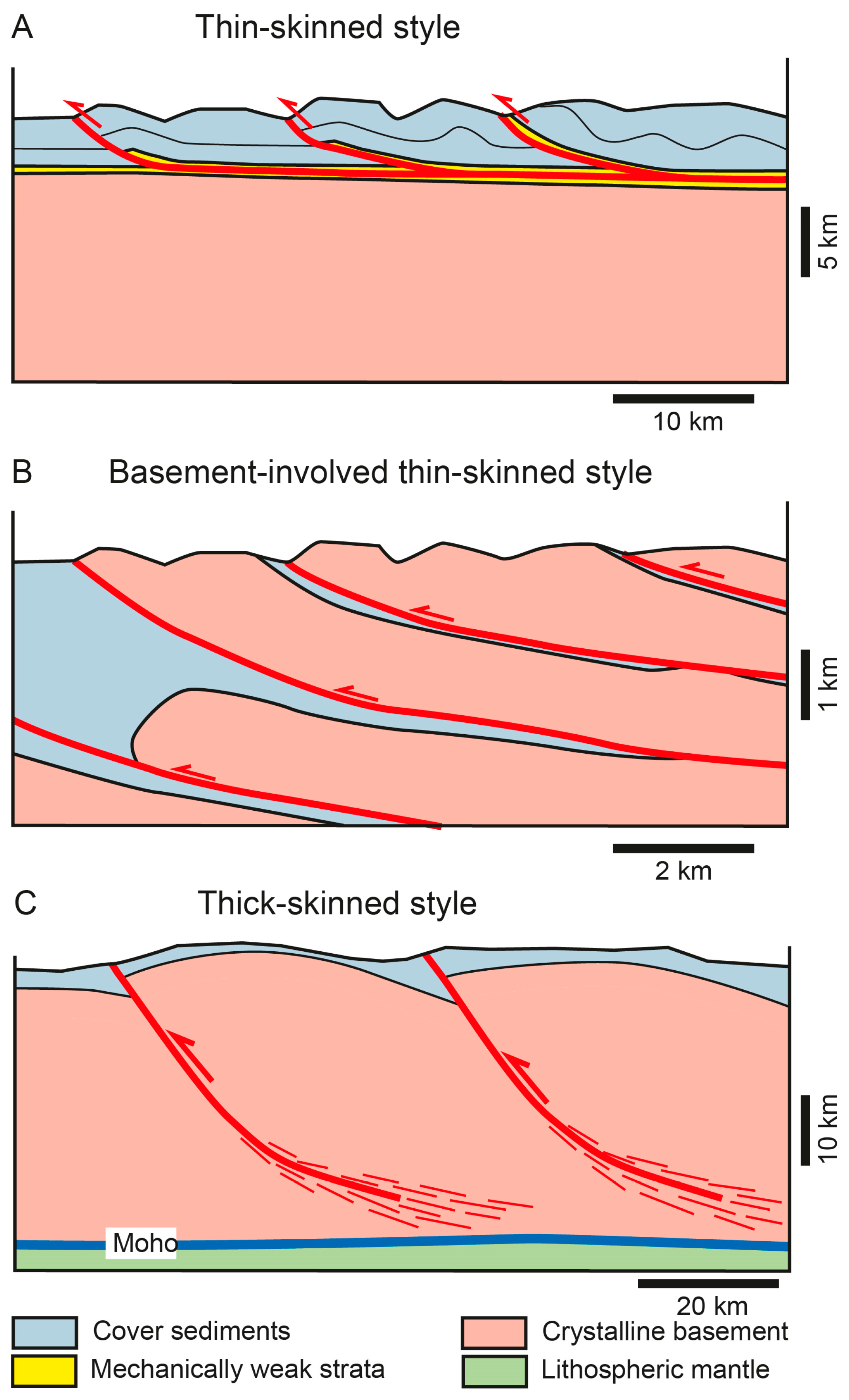
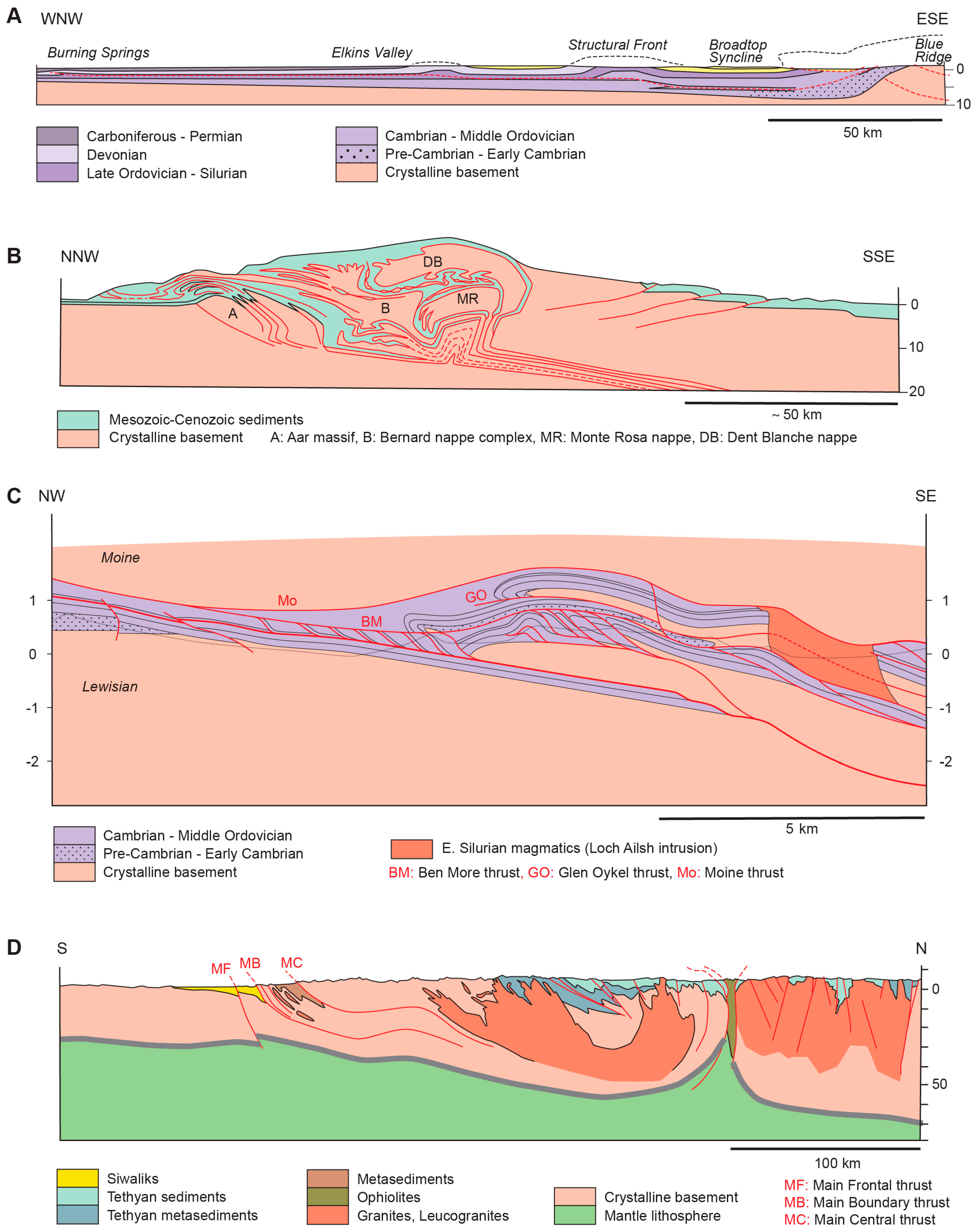
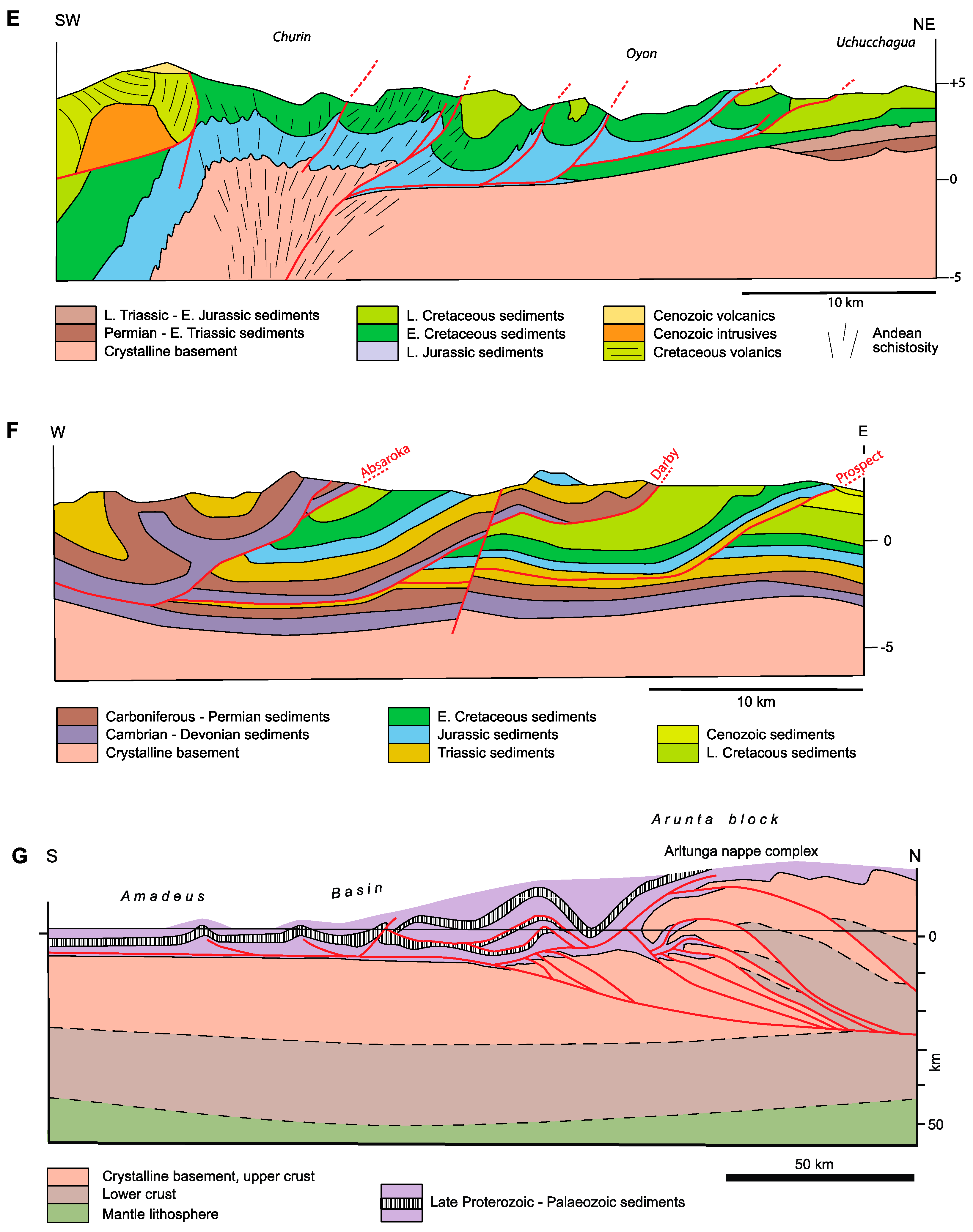

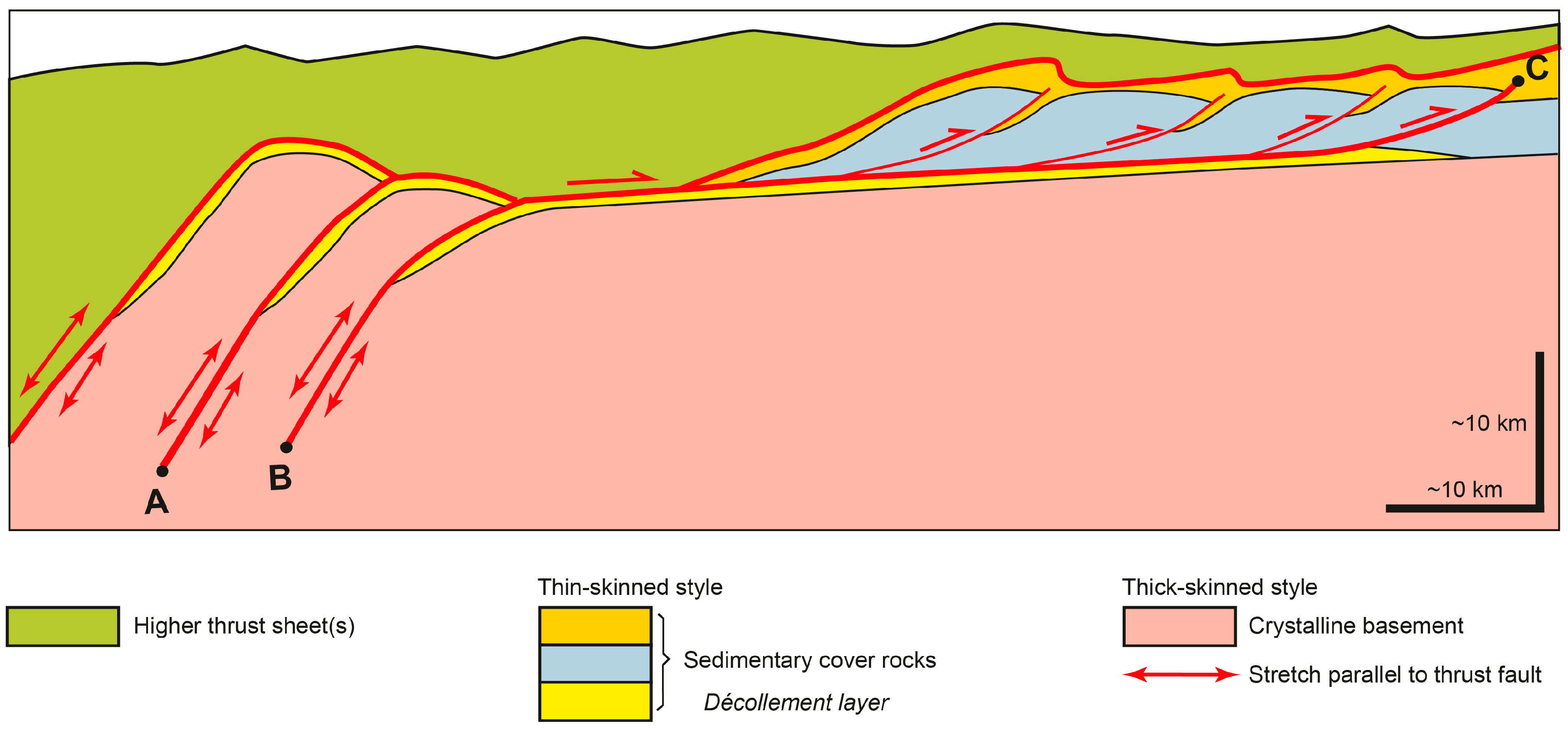
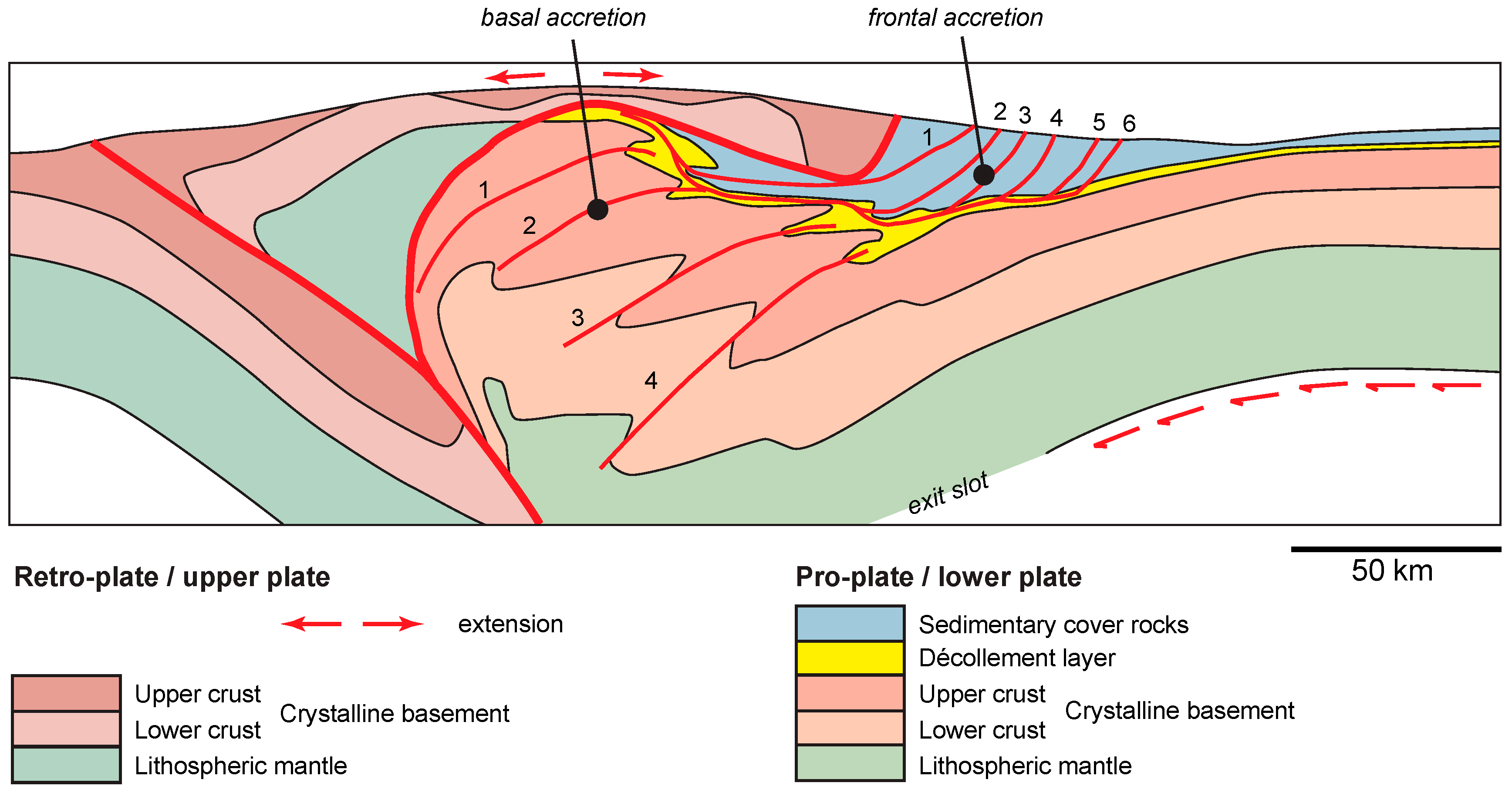

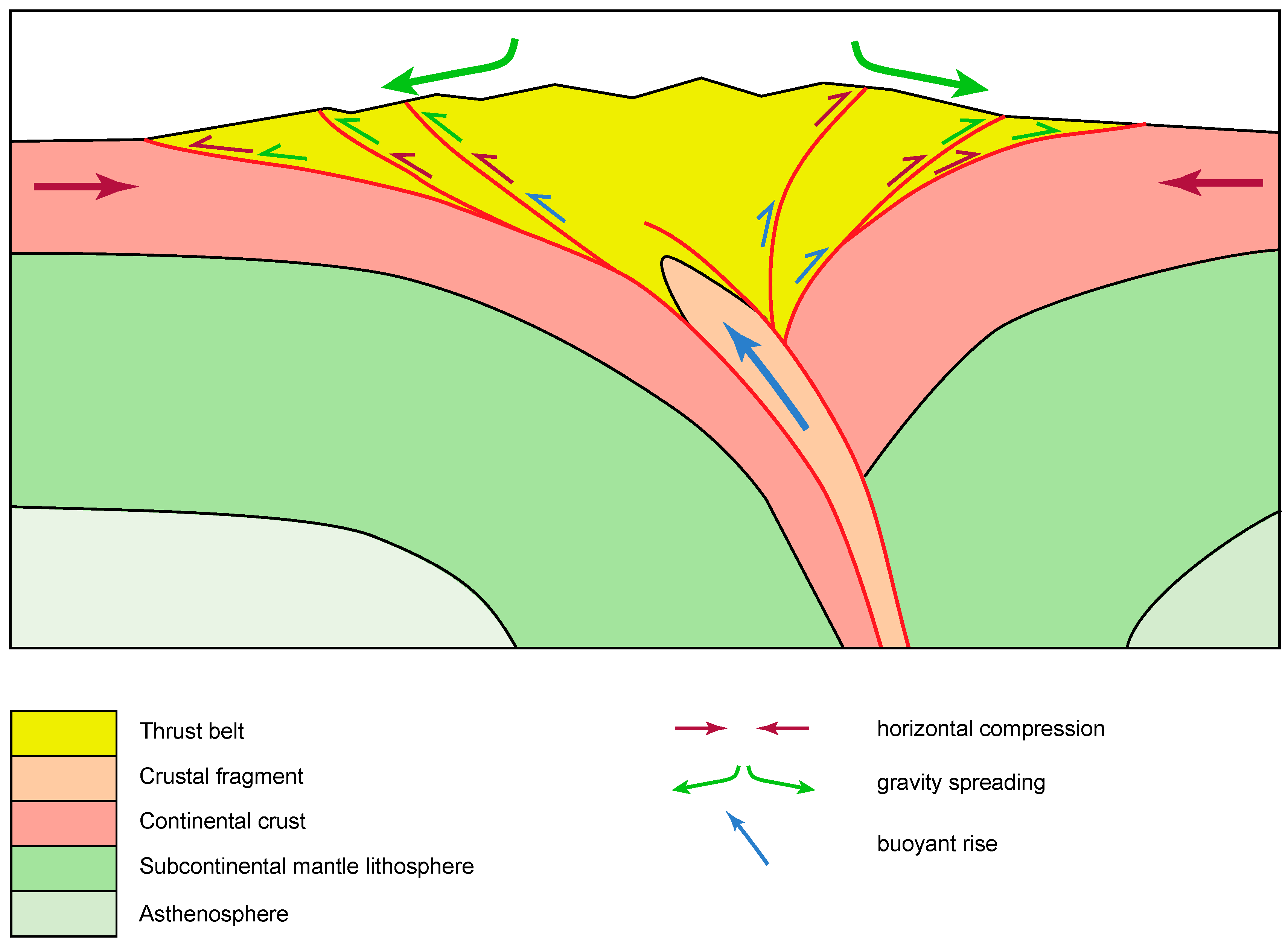
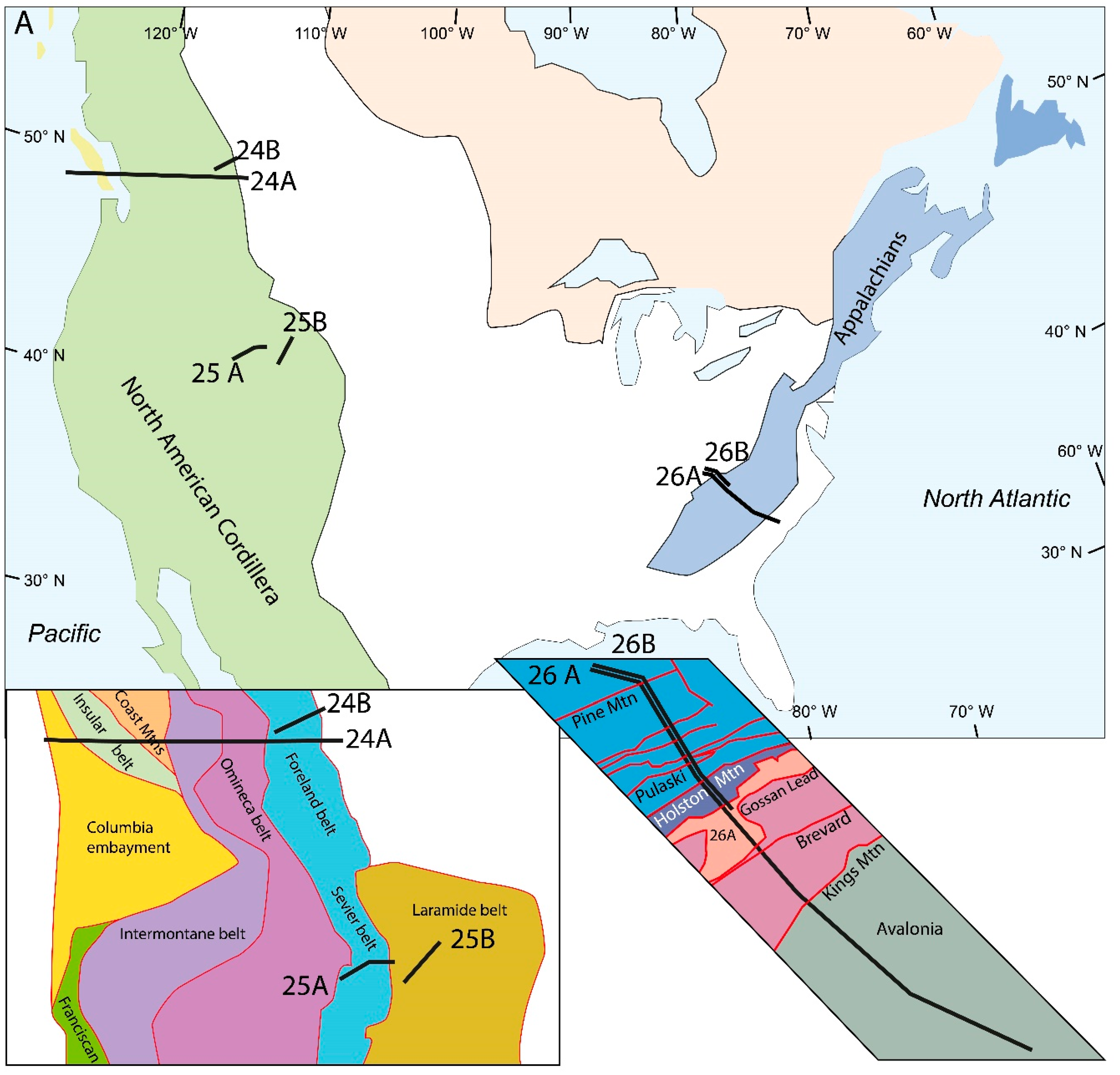
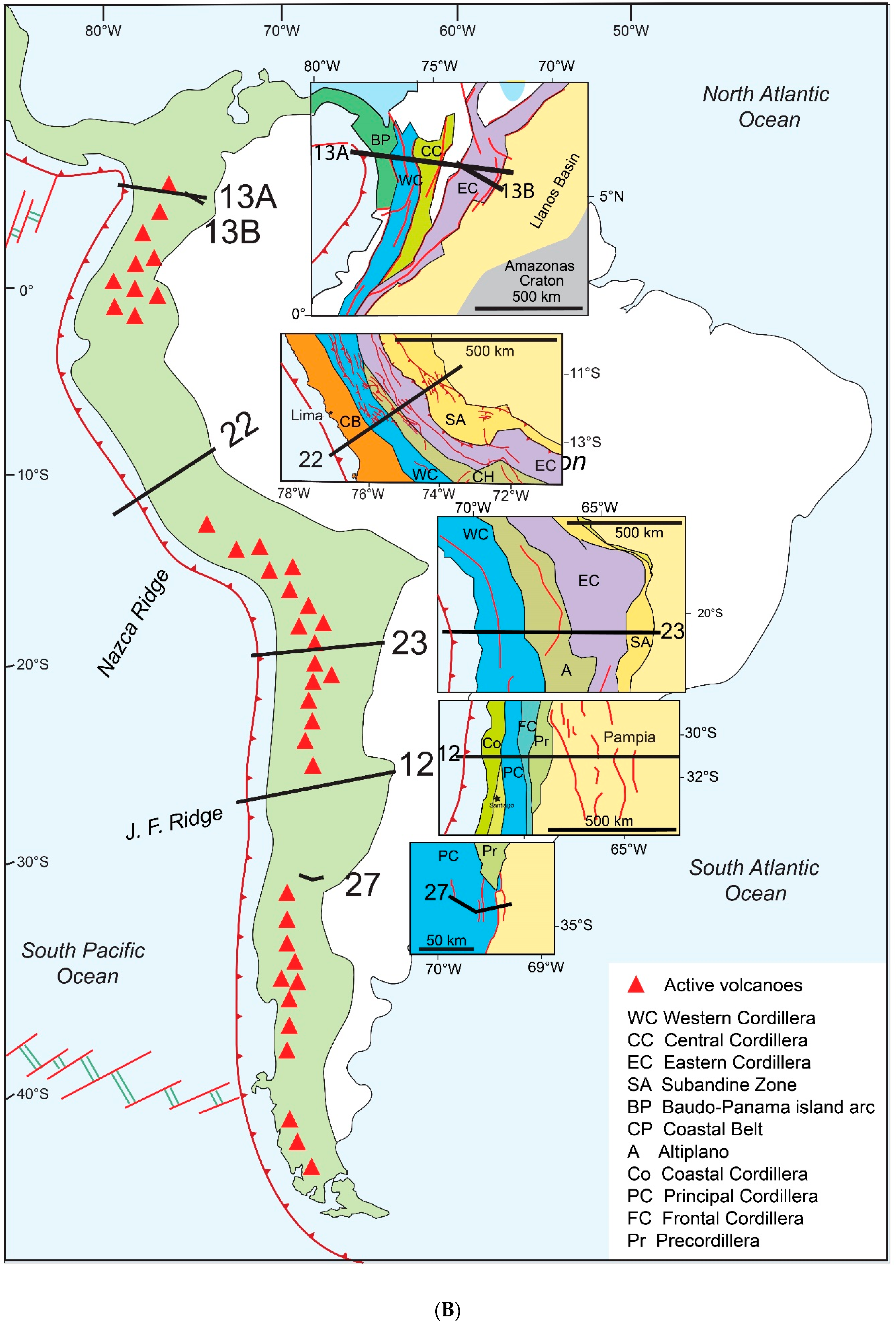
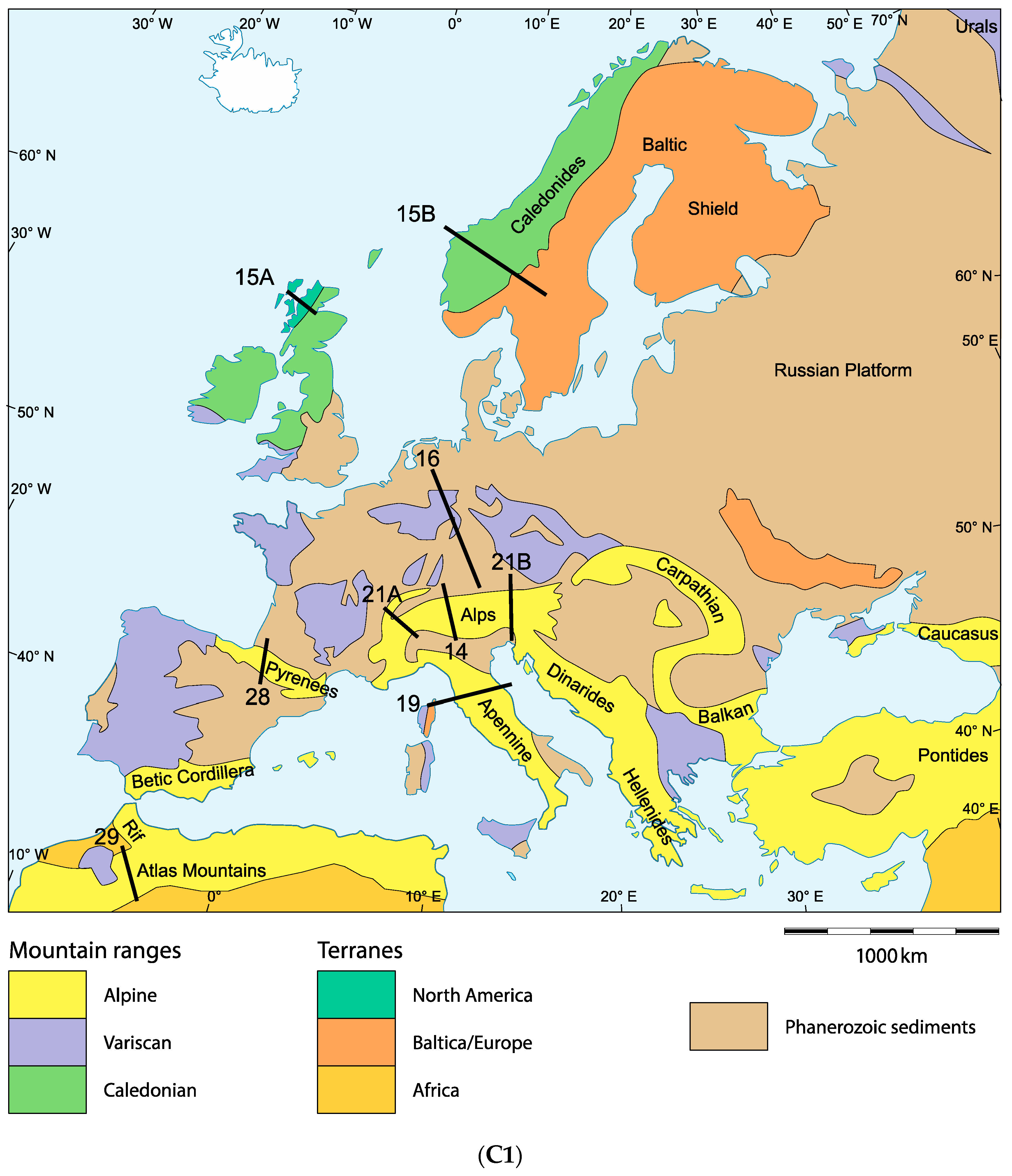
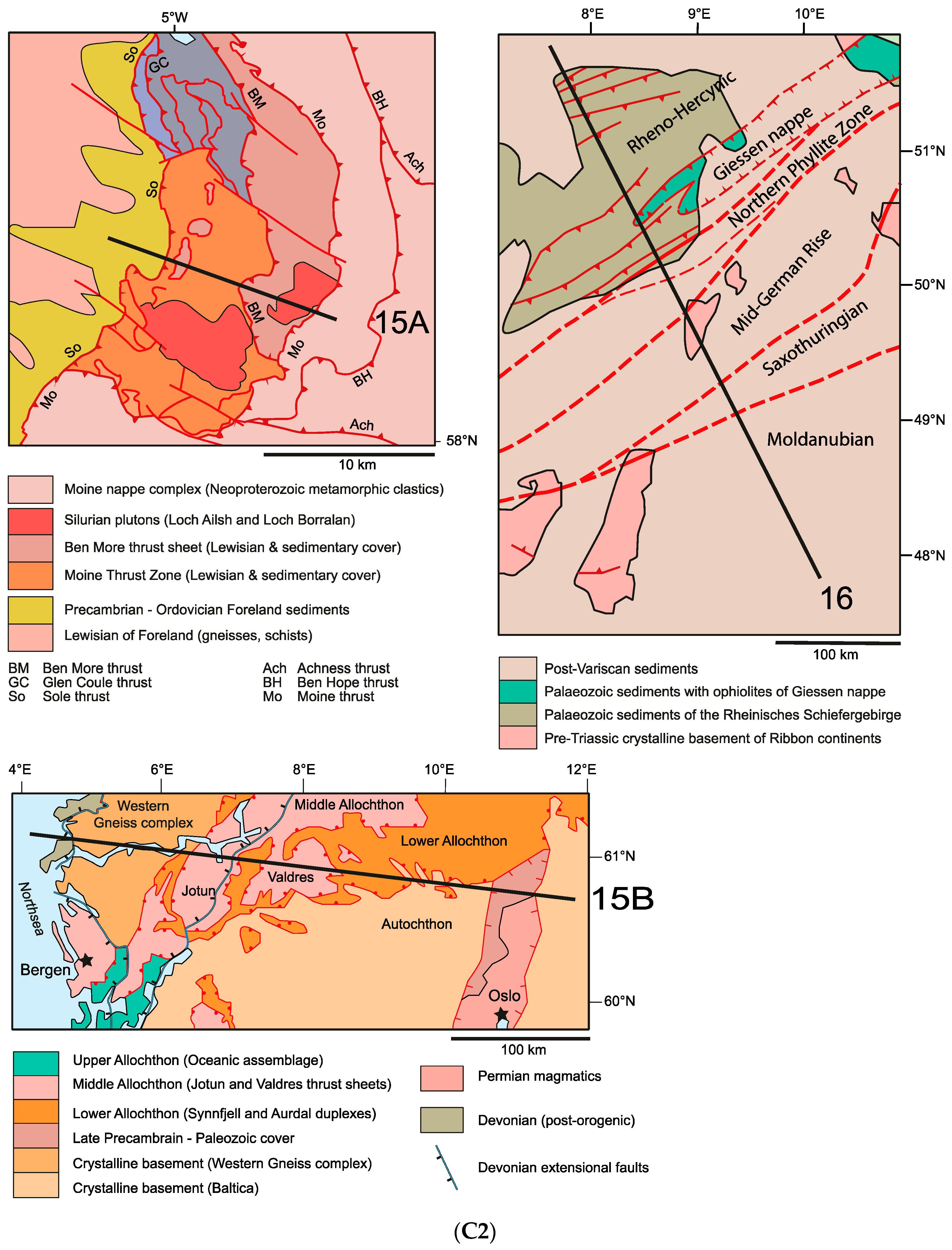
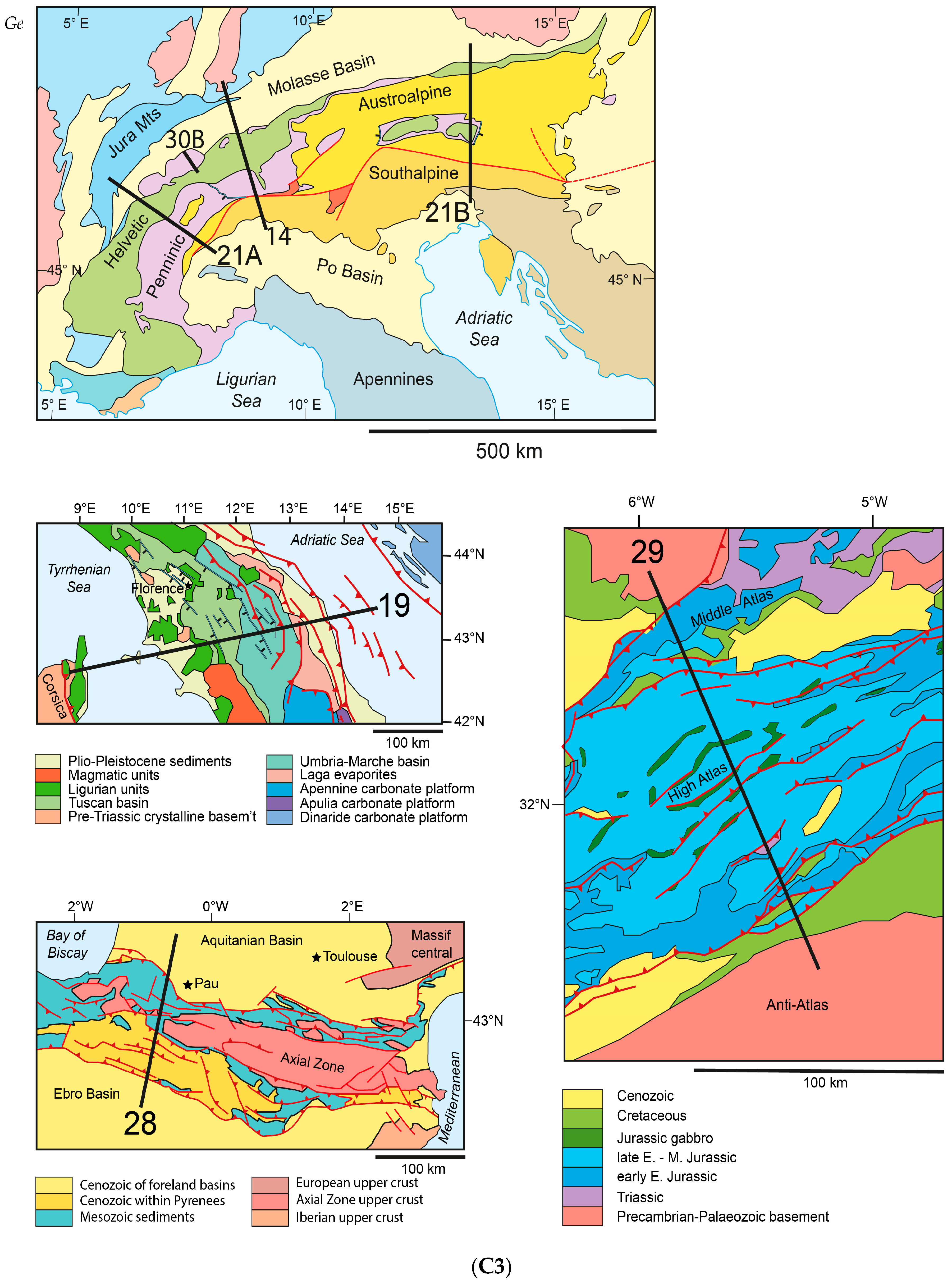



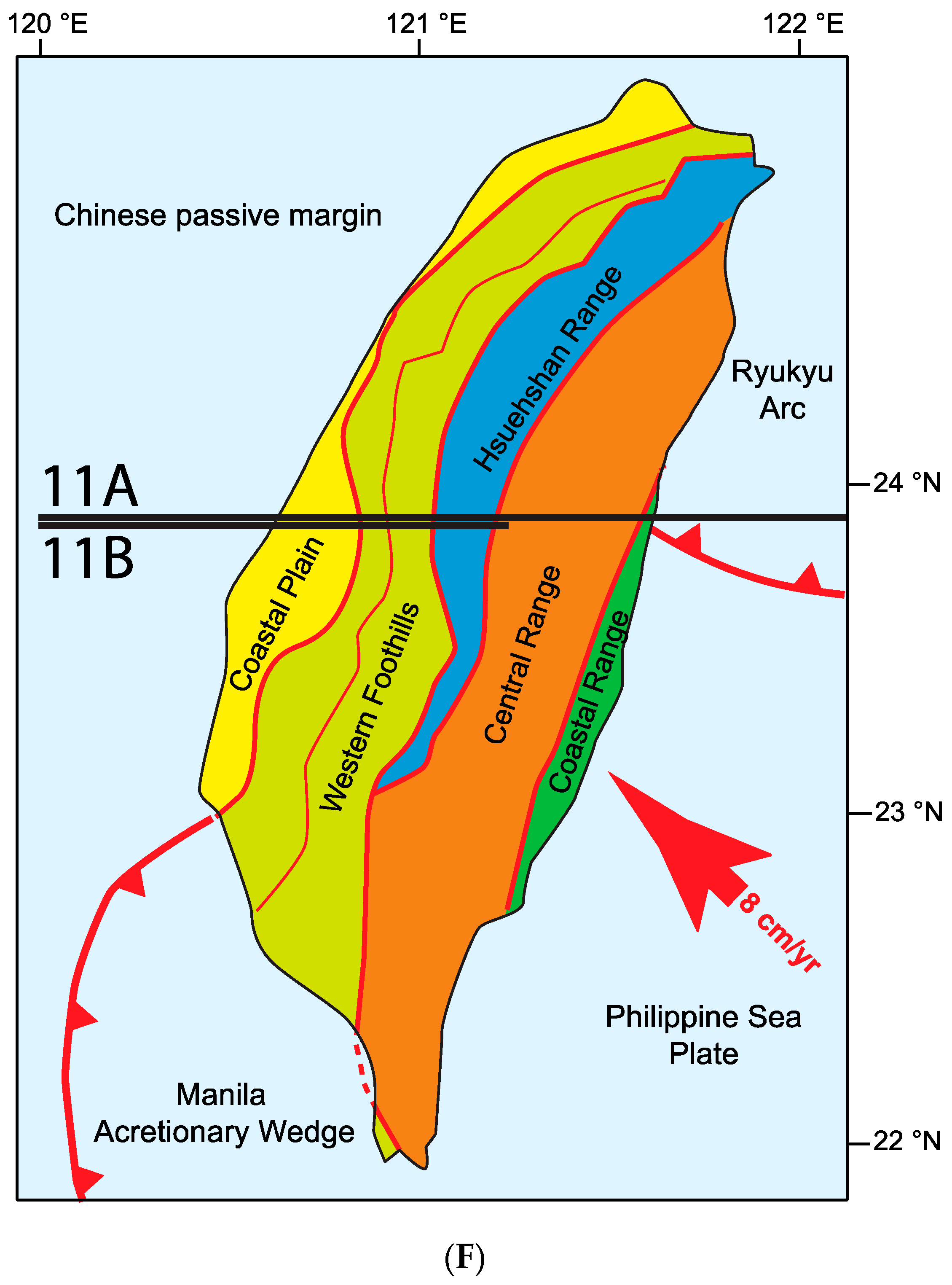

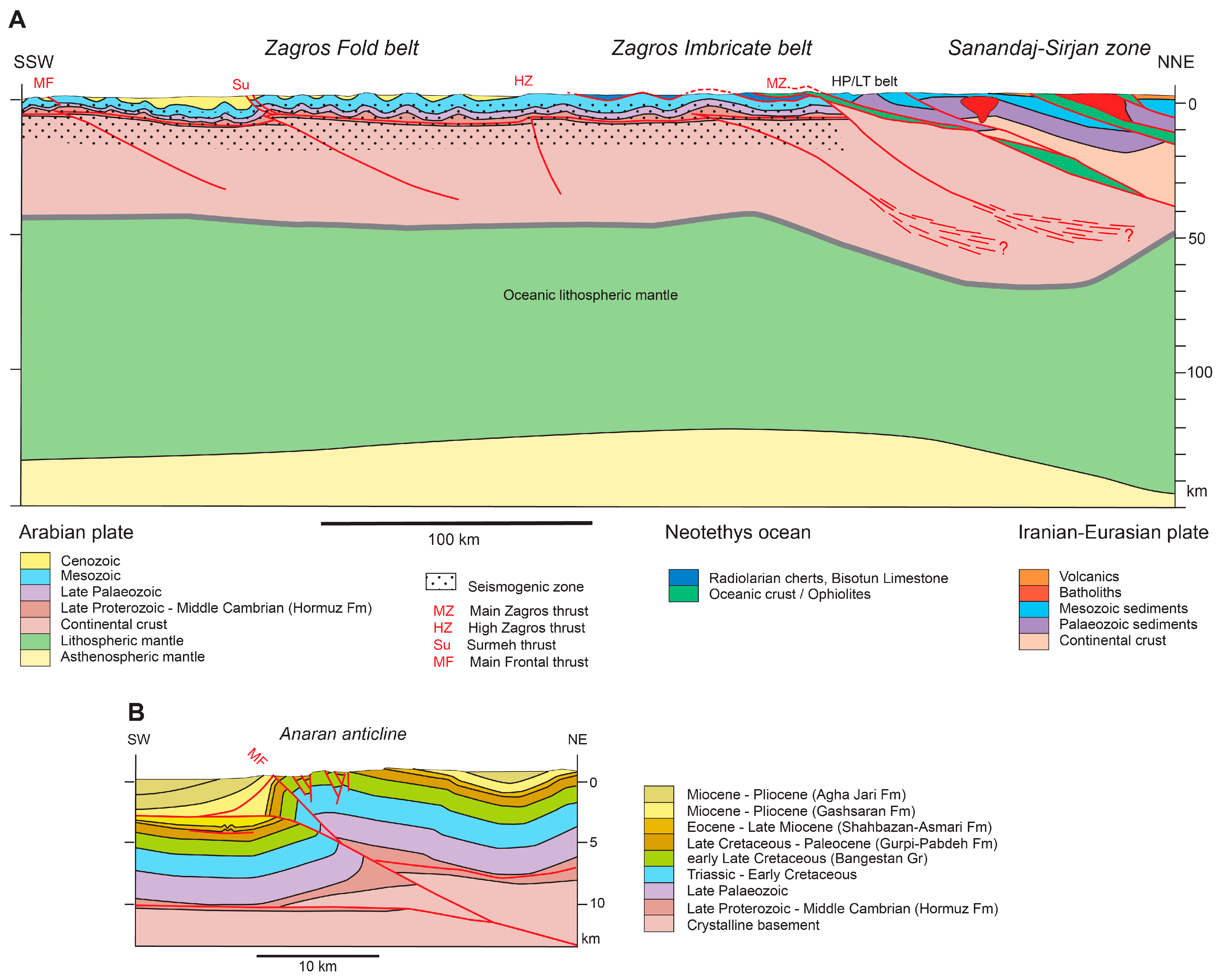


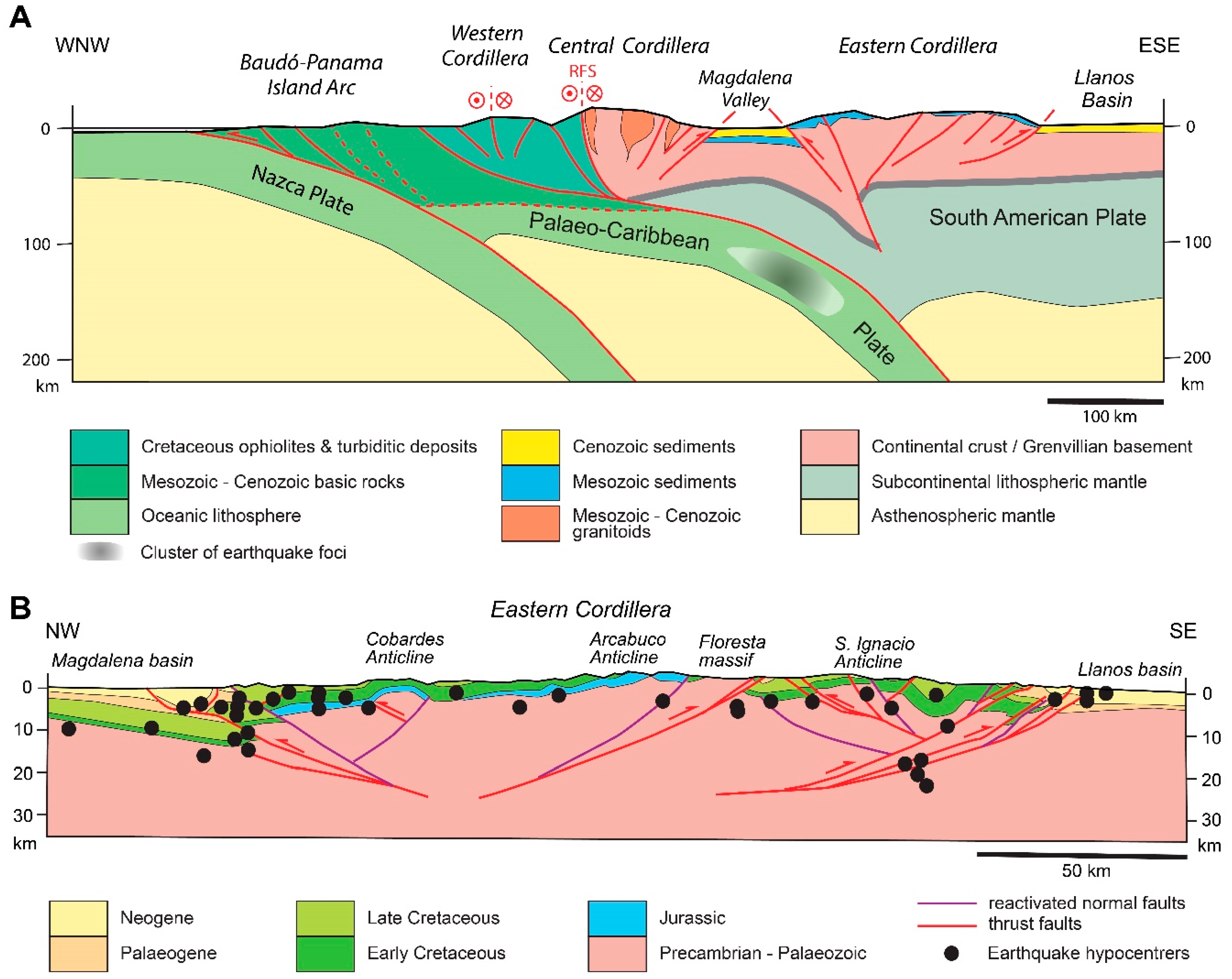
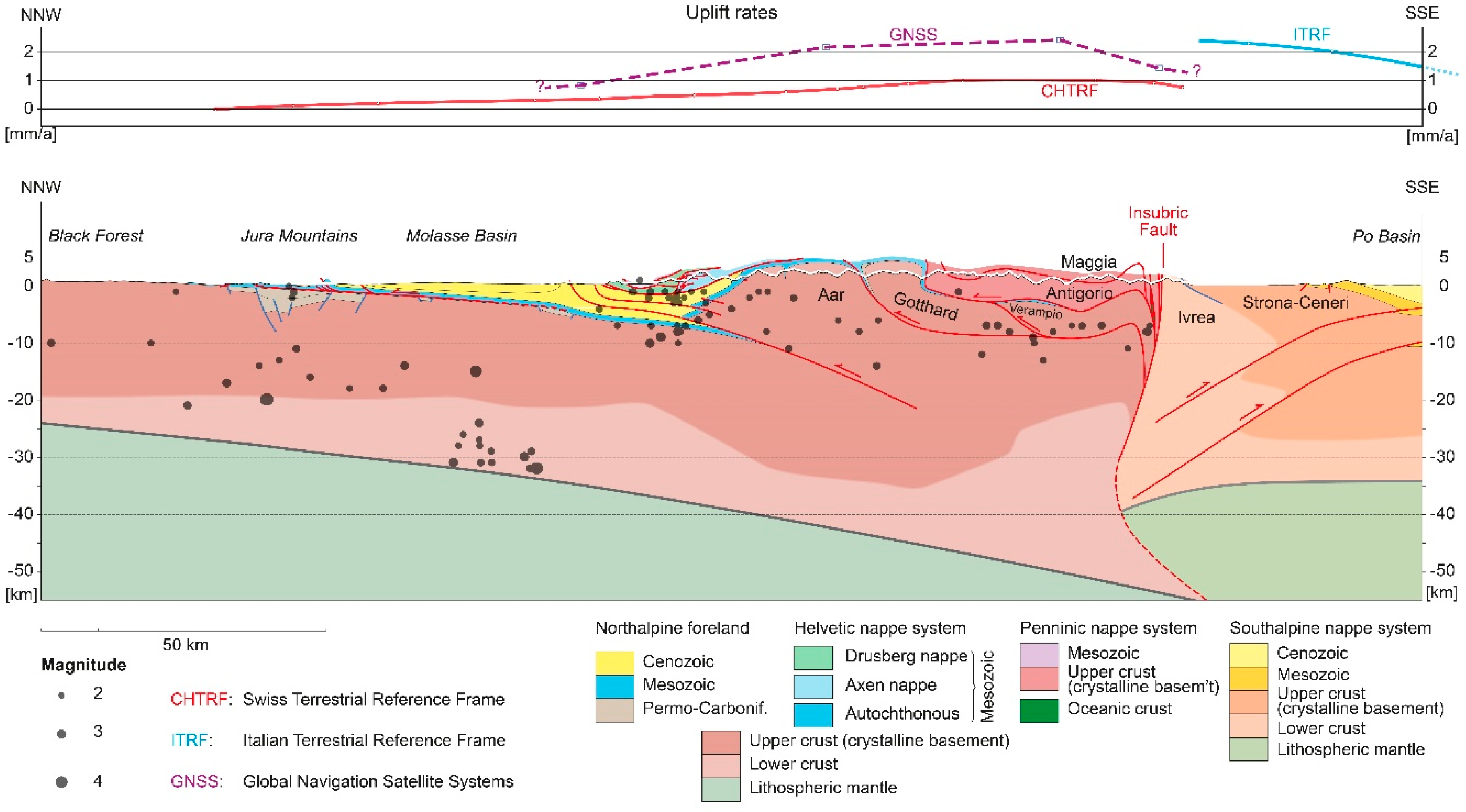
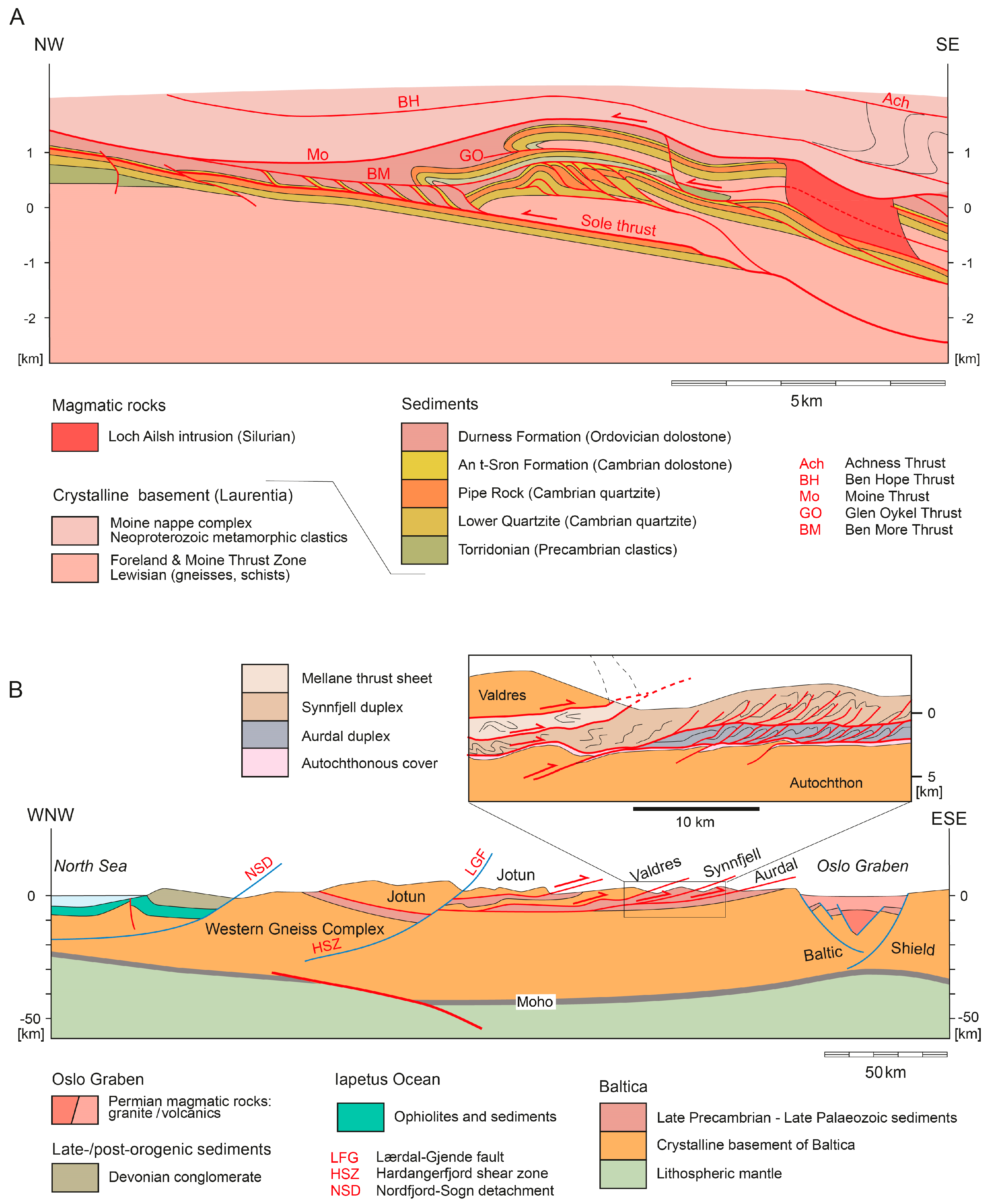
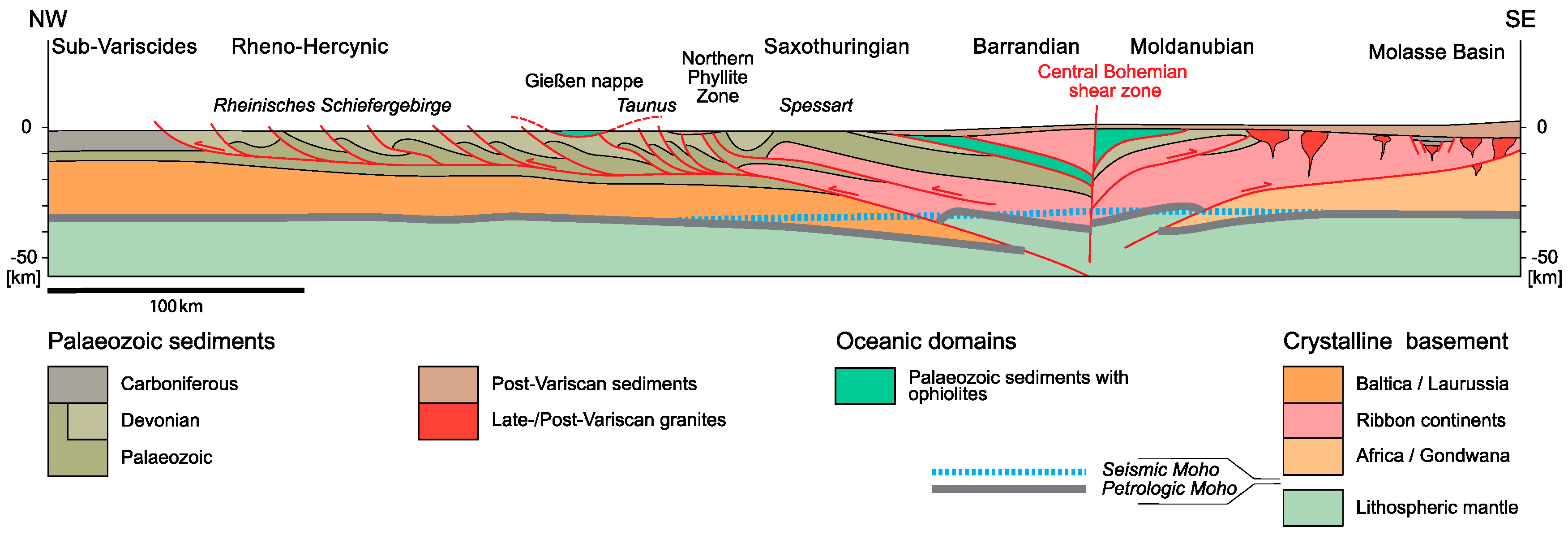



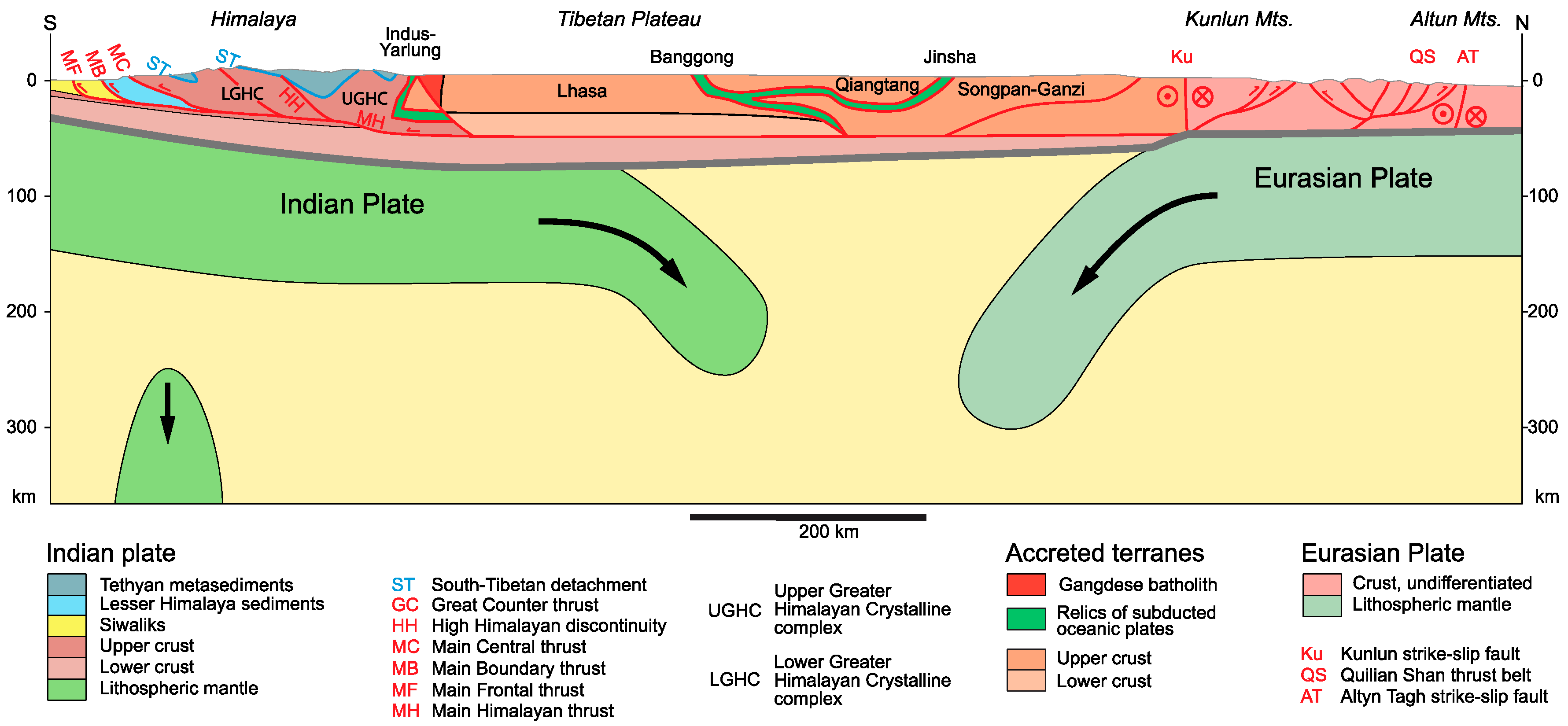
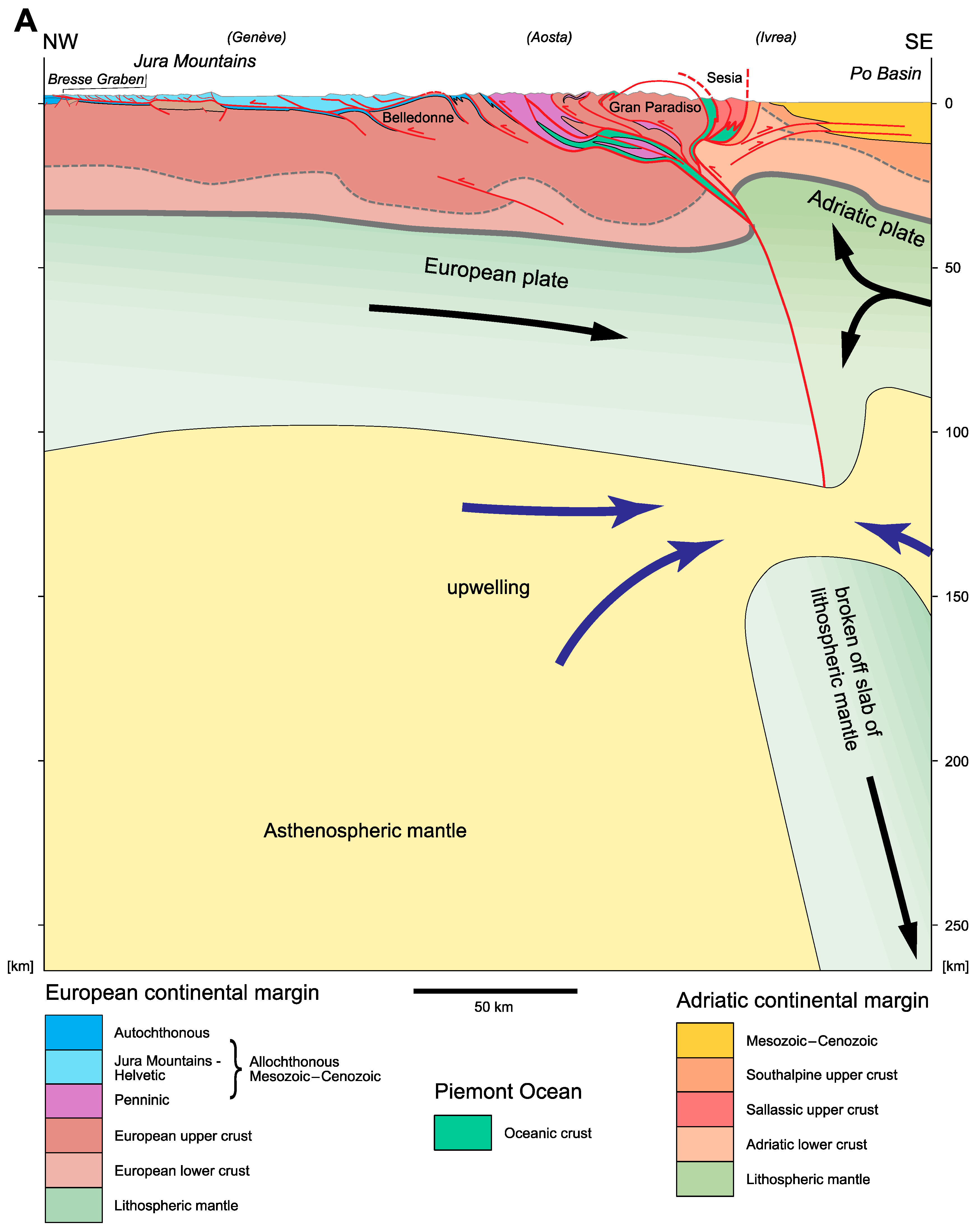
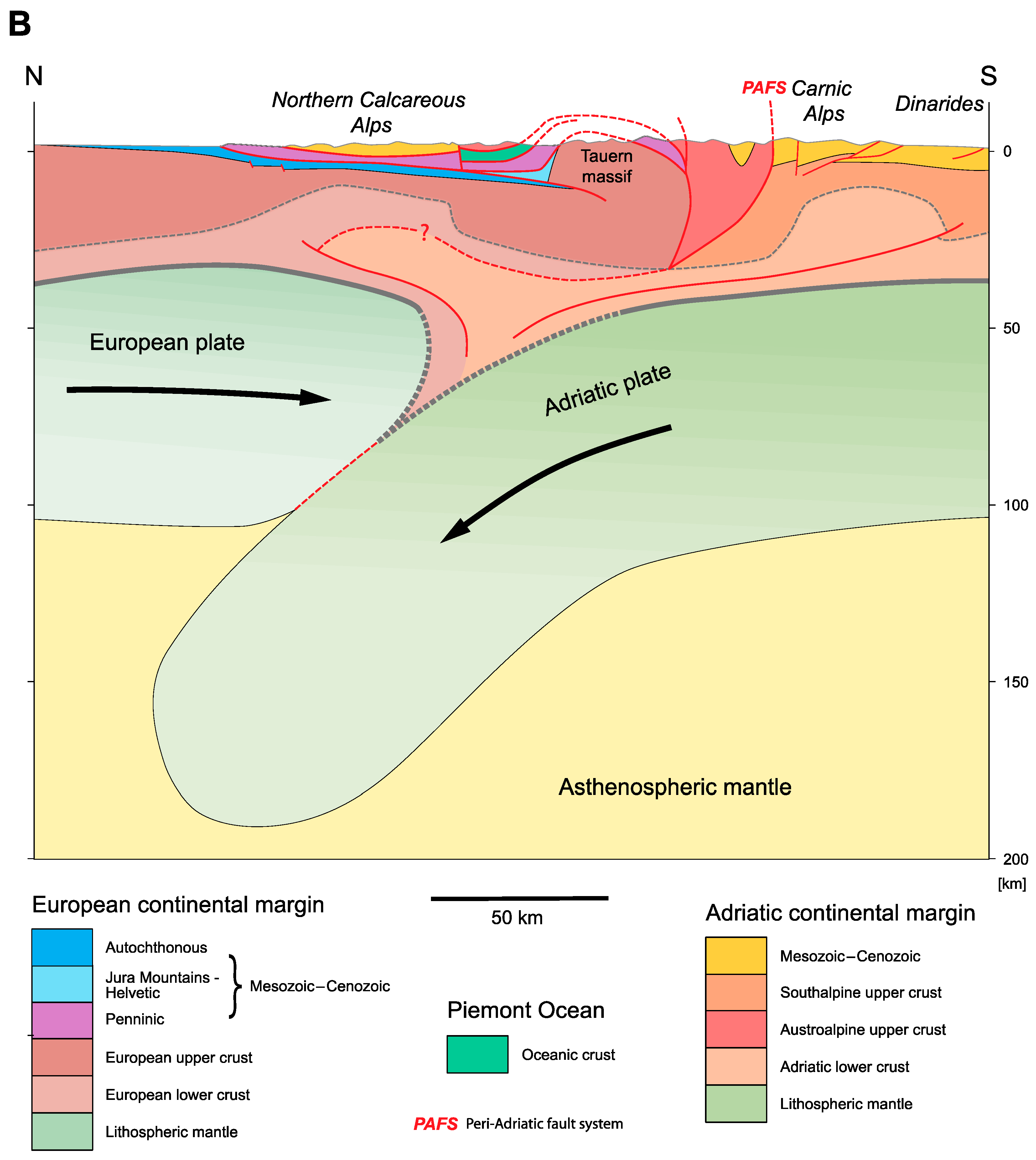
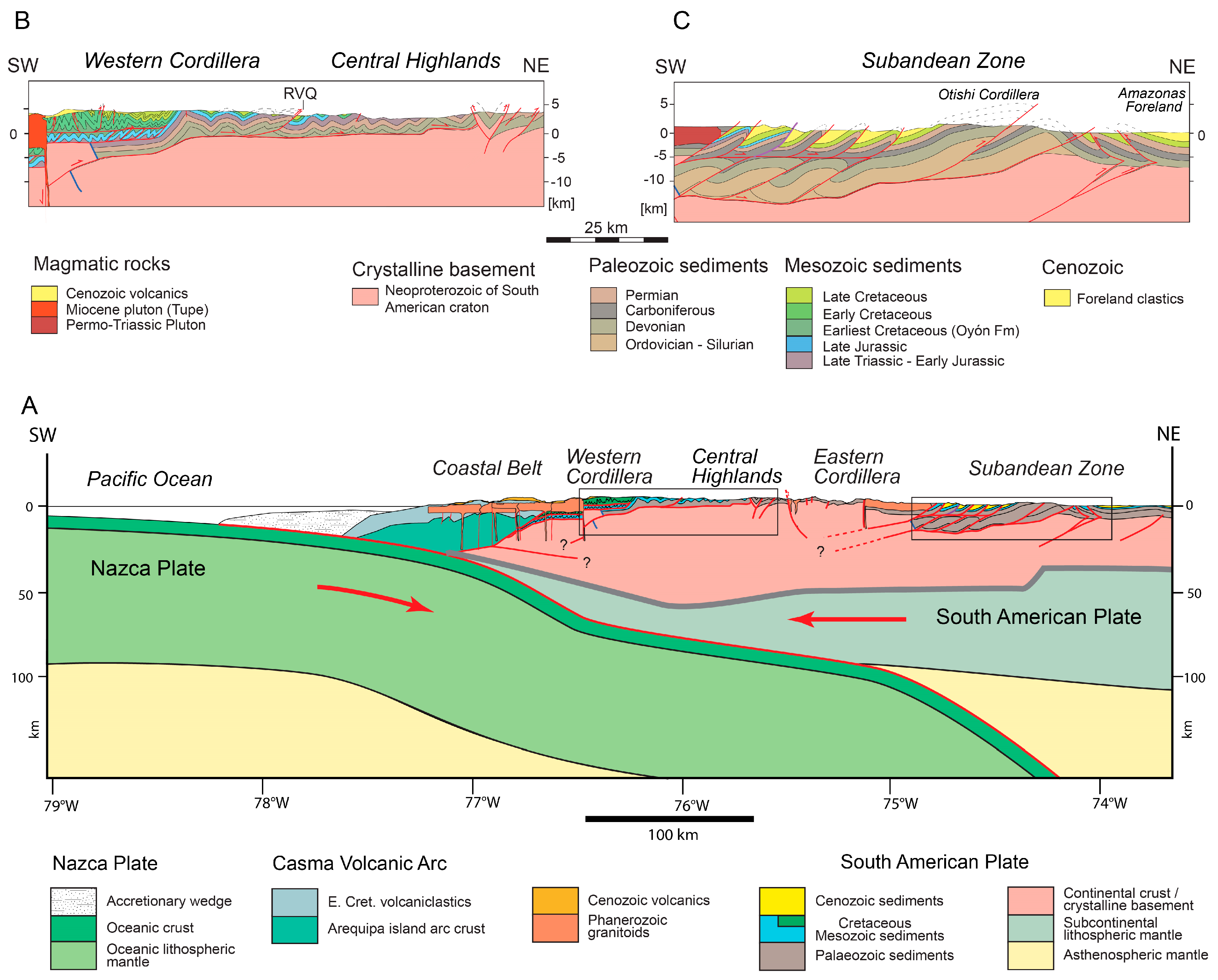
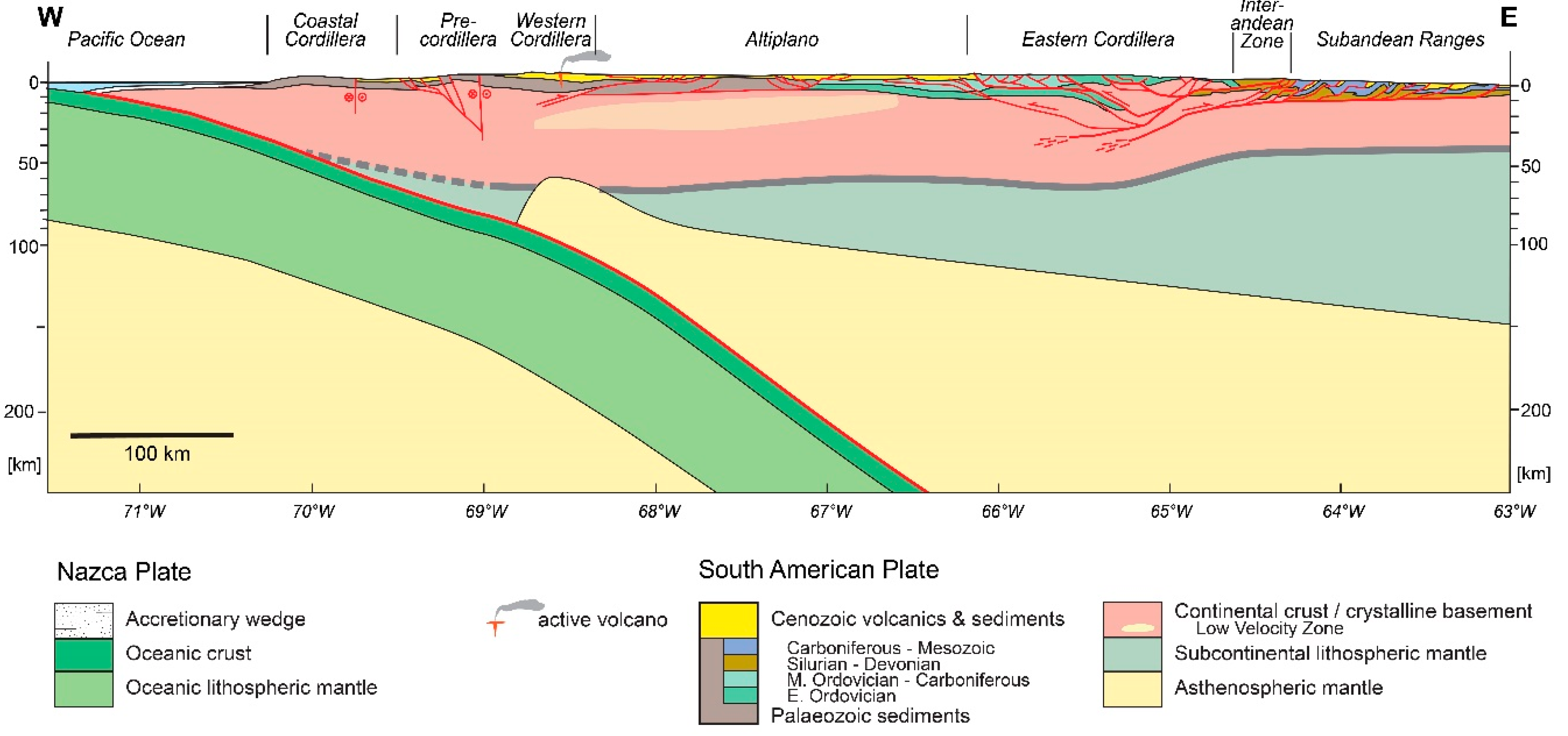
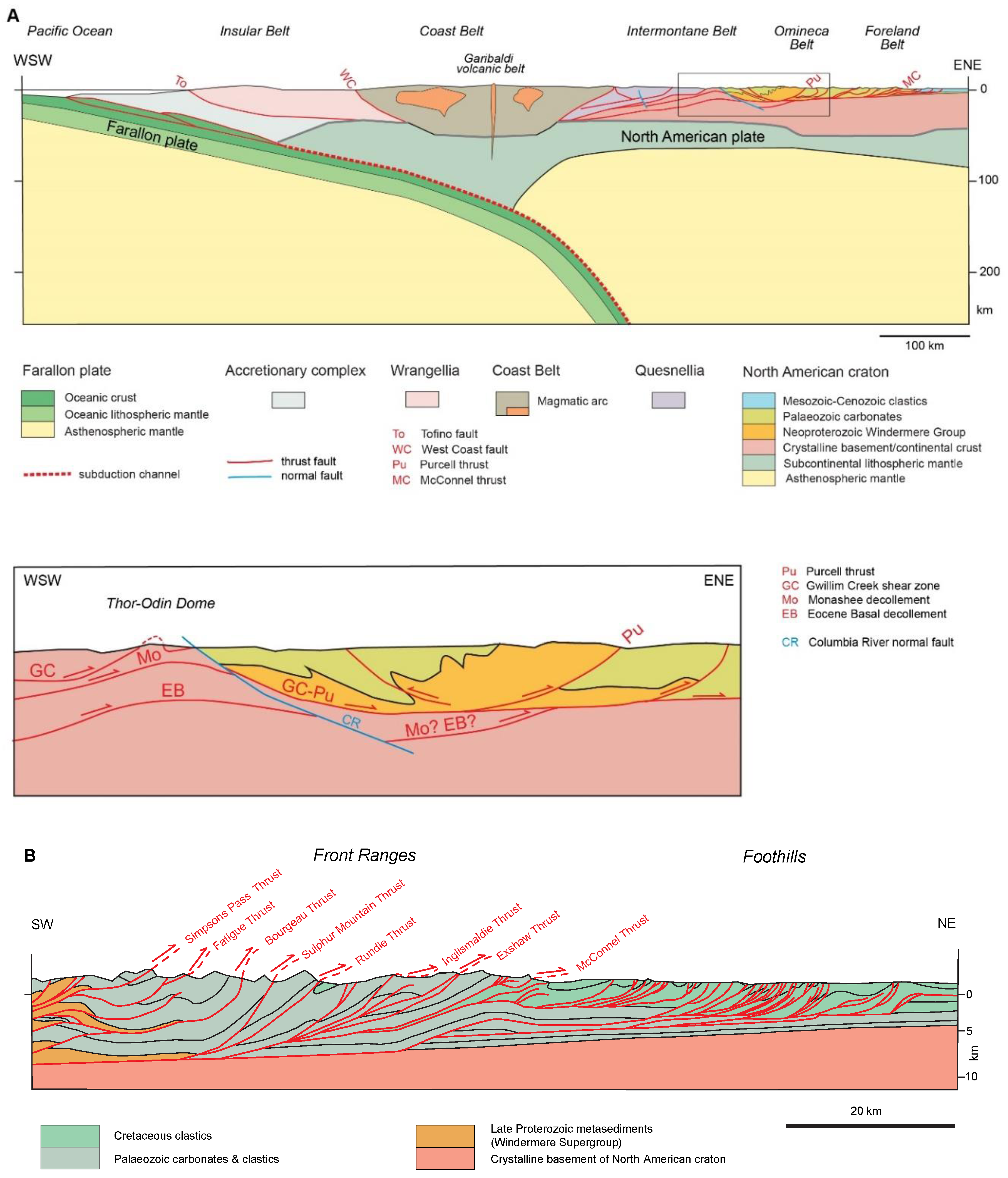
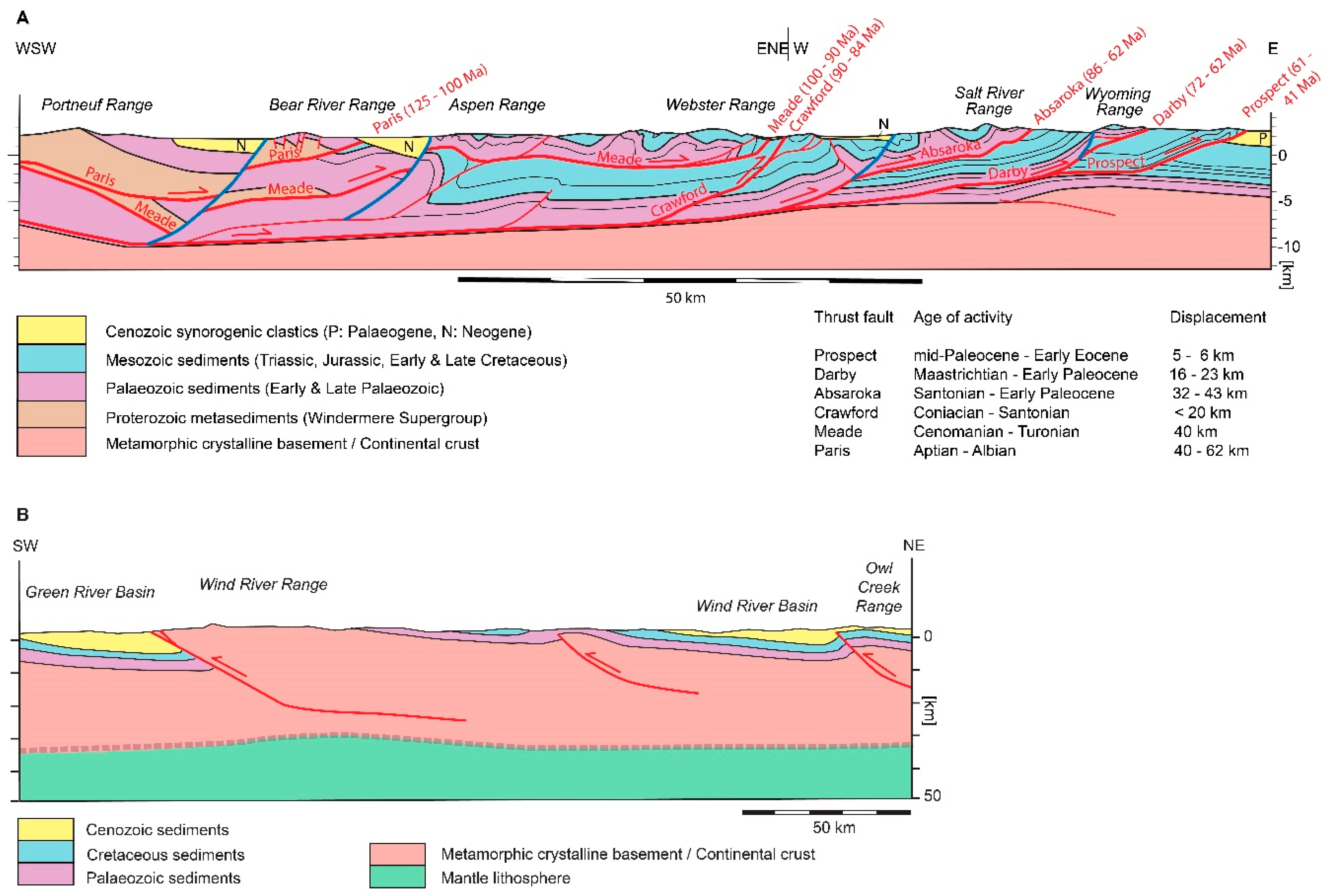
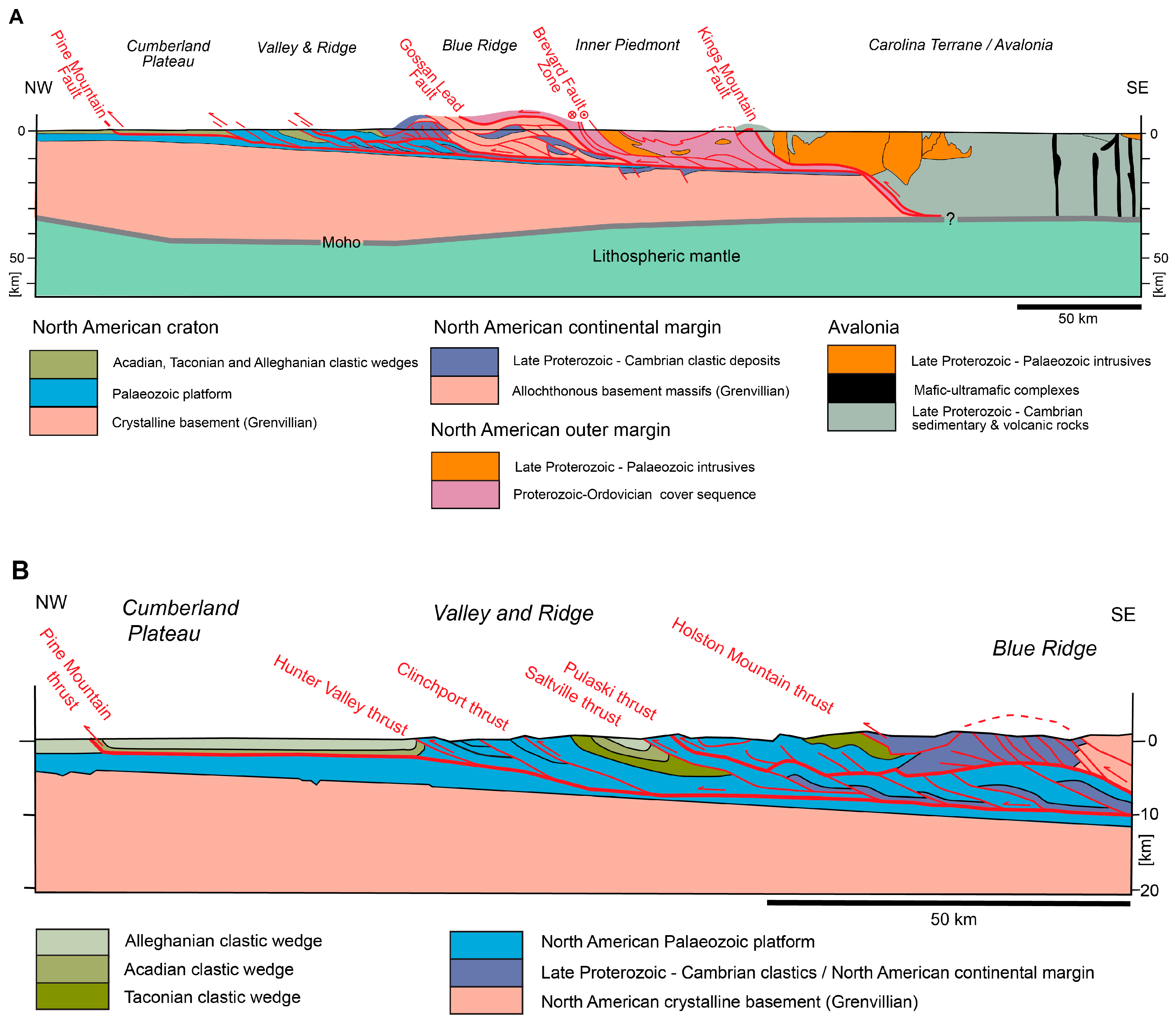
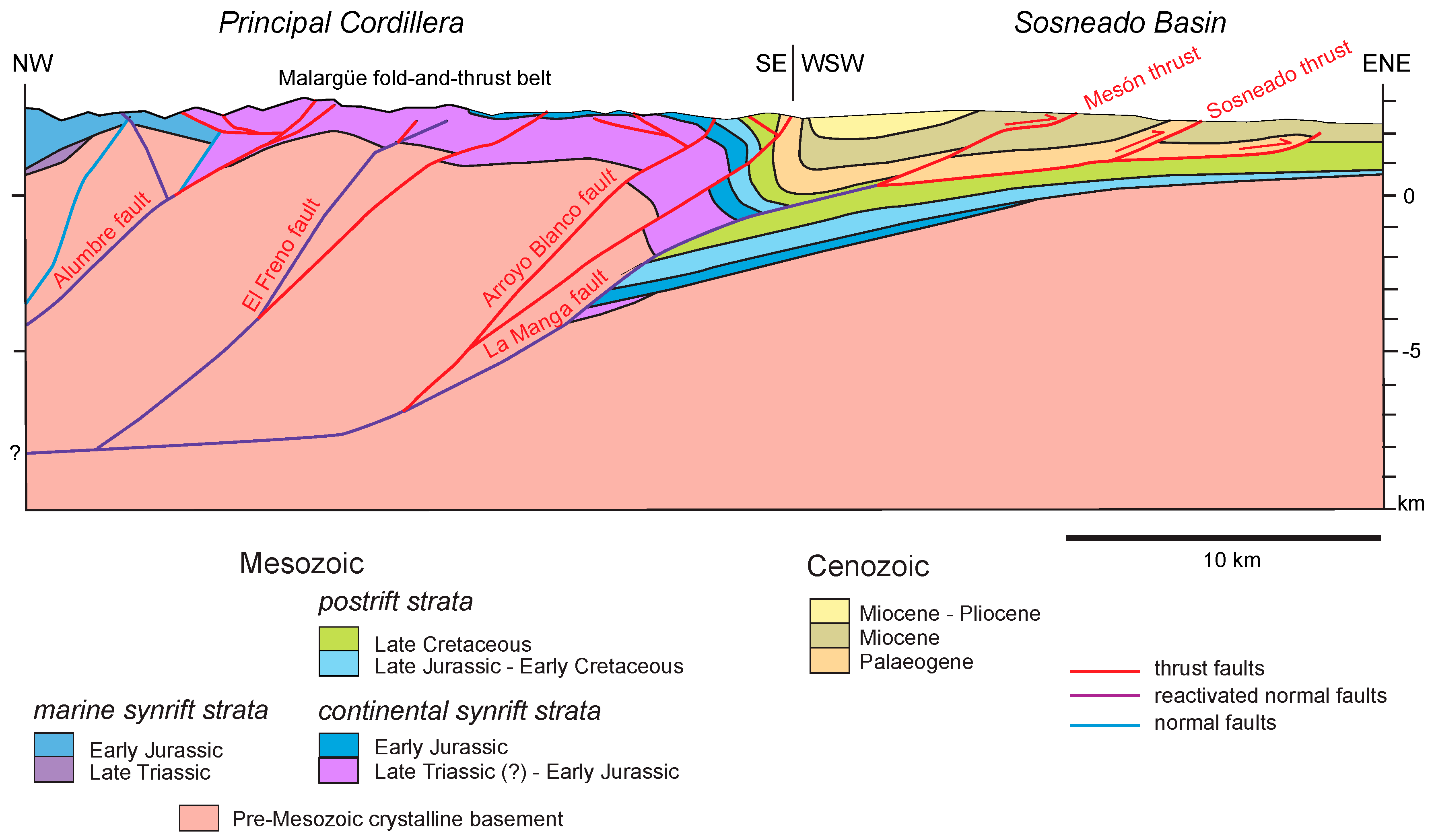
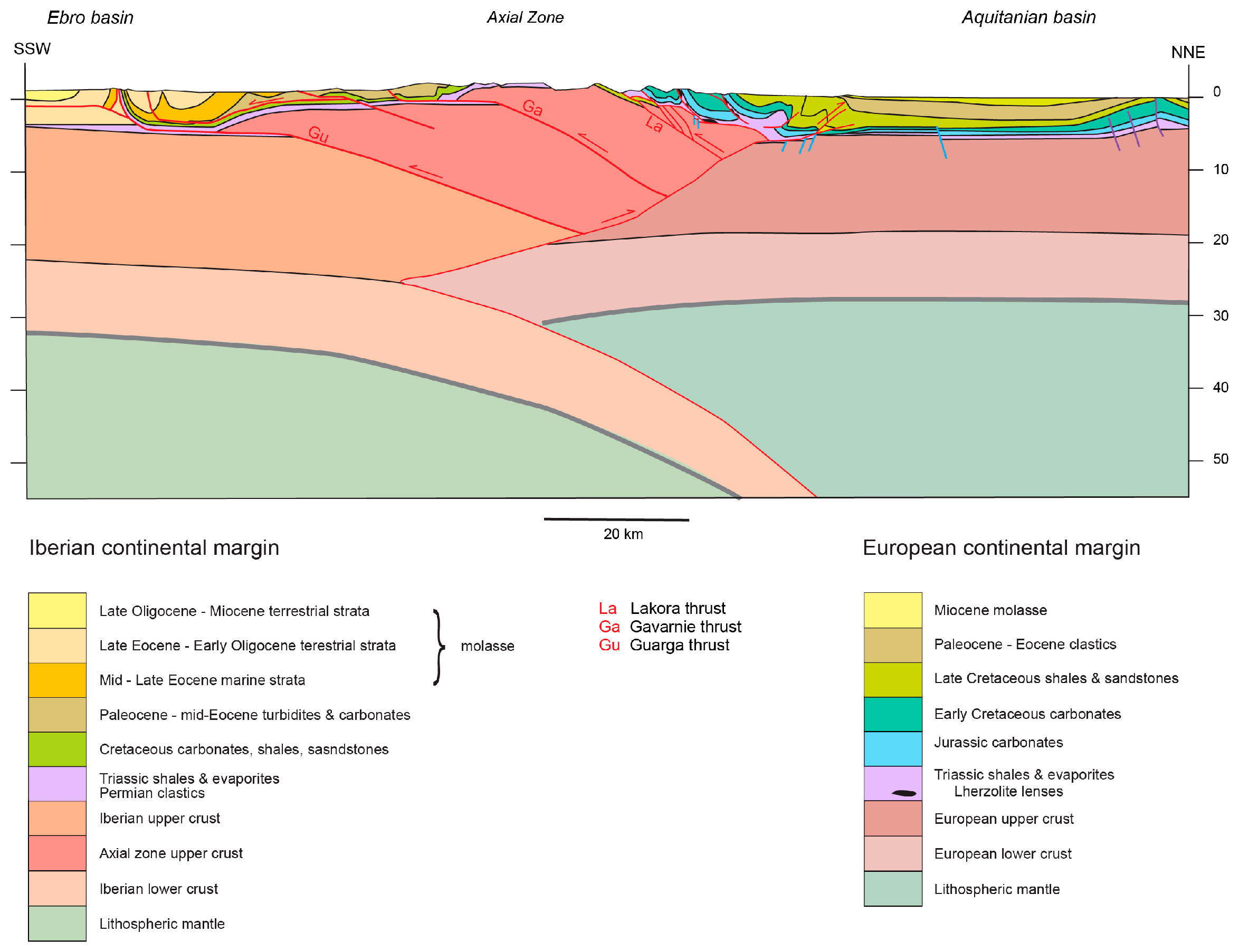
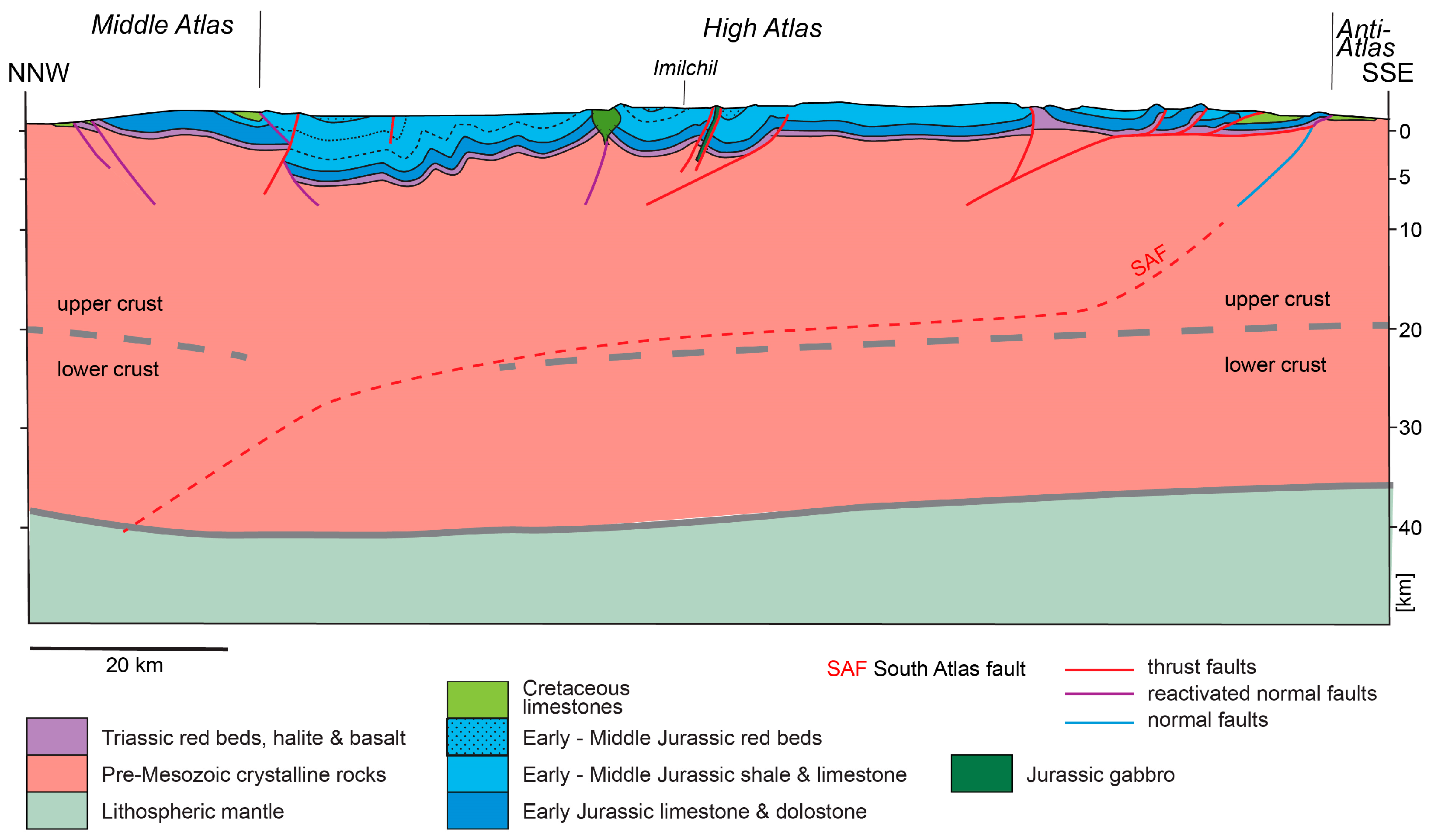

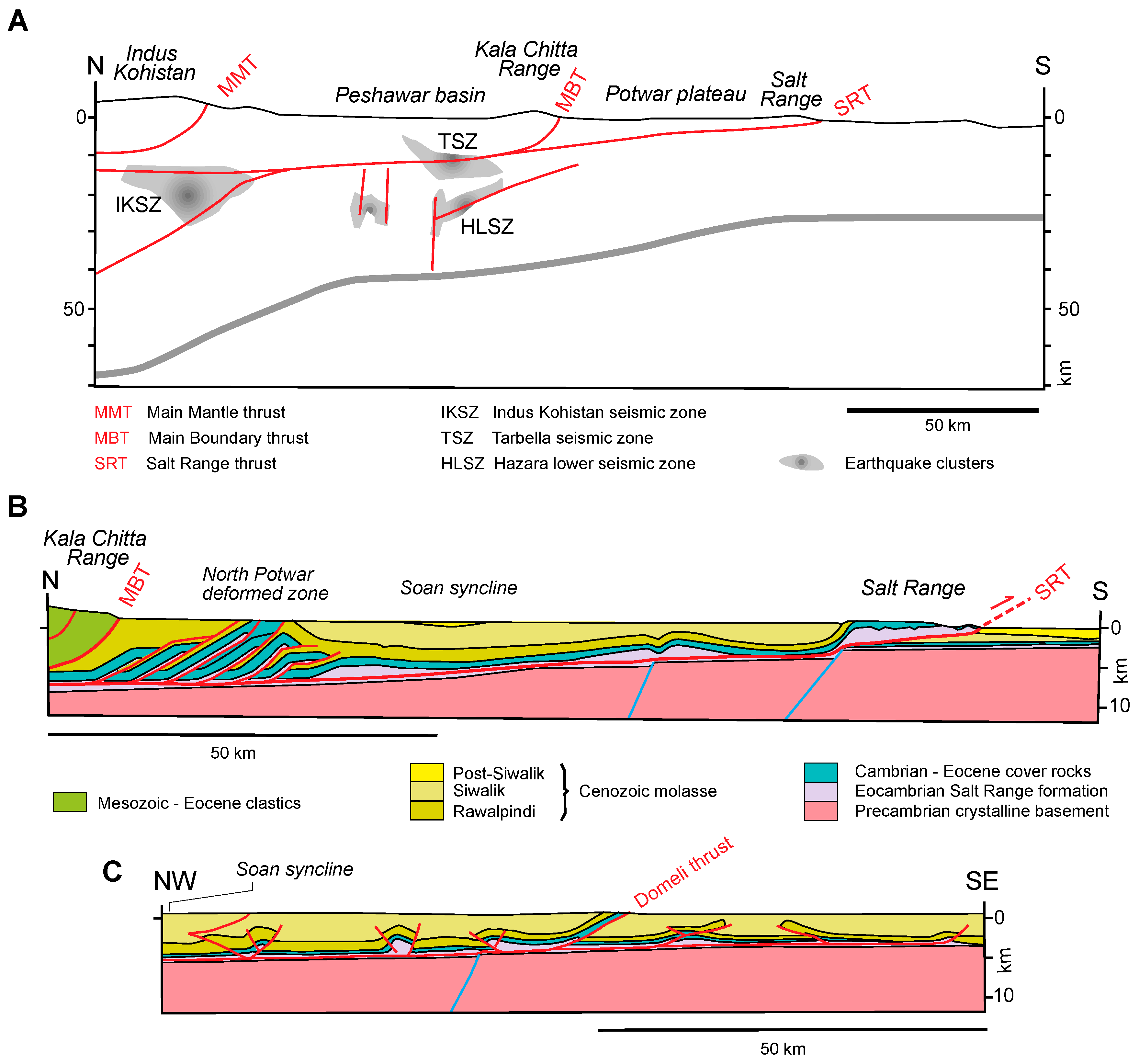
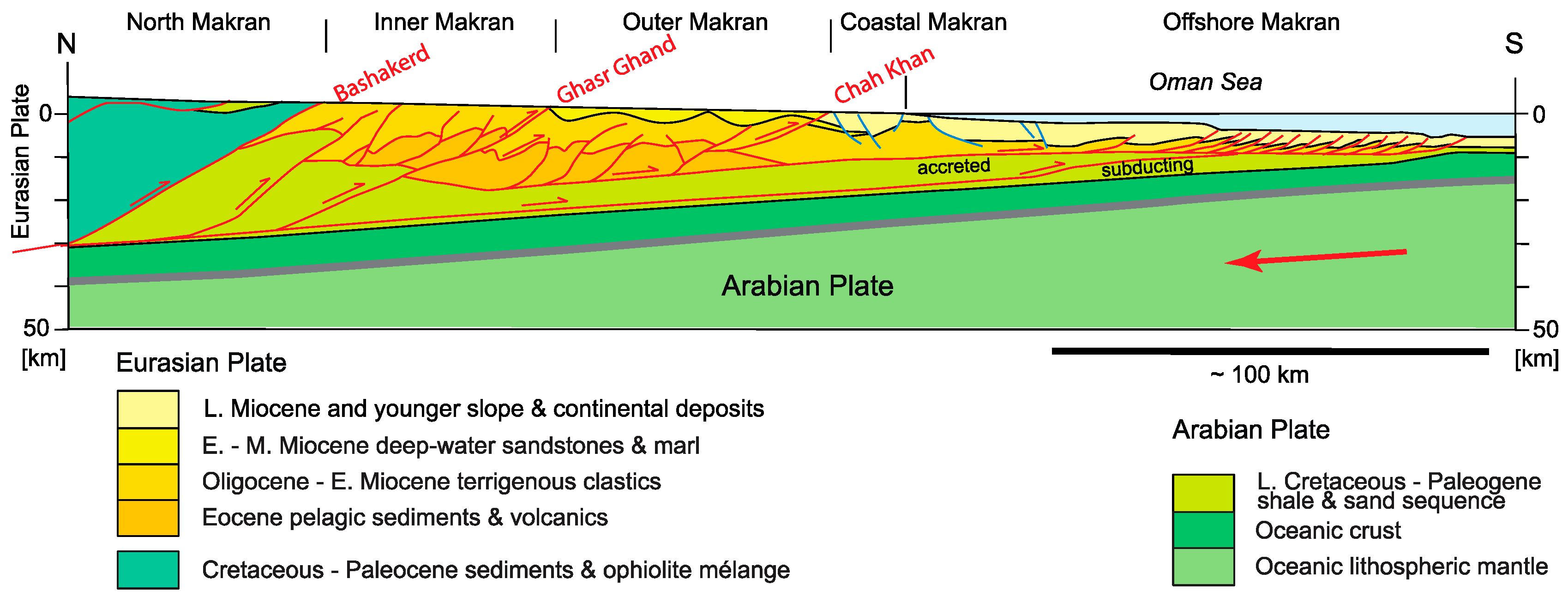
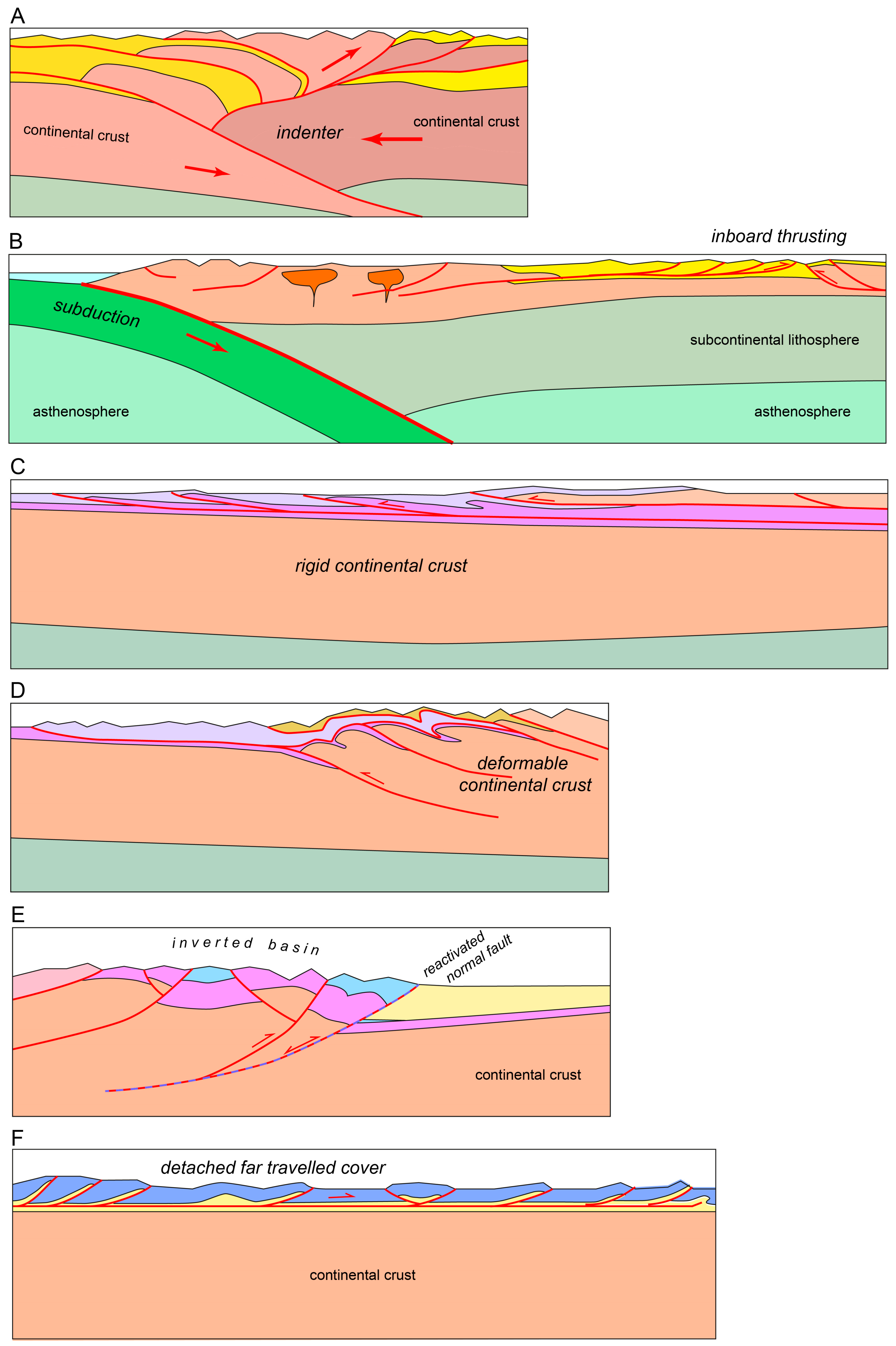
© 2017 by the author. Licensee MDPI, Basel, Switzerland. This article is an open access article distributed under the terms and conditions of the Creative Commons Attribution (CC BY) license (http://creativecommons.org/licenses/by/4.0/).
Share and Cite
Pfiffner, O.A. Thick-Skinned and Thin-Skinned Tectonics: A Global Perspective. Geosciences 2017, 7, 71. https://doi.org/10.3390/geosciences7030071
Pfiffner OA. Thick-Skinned and Thin-Skinned Tectonics: A Global Perspective. Geosciences. 2017; 7(3):71. https://doi.org/10.3390/geosciences7030071
Chicago/Turabian StylePfiffner, O. Adrian. 2017. "Thick-Skinned and Thin-Skinned Tectonics: A Global Perspective" Geosciences 7, no. 3: 71. https://doi.org/10.3390/geosciences7030071



